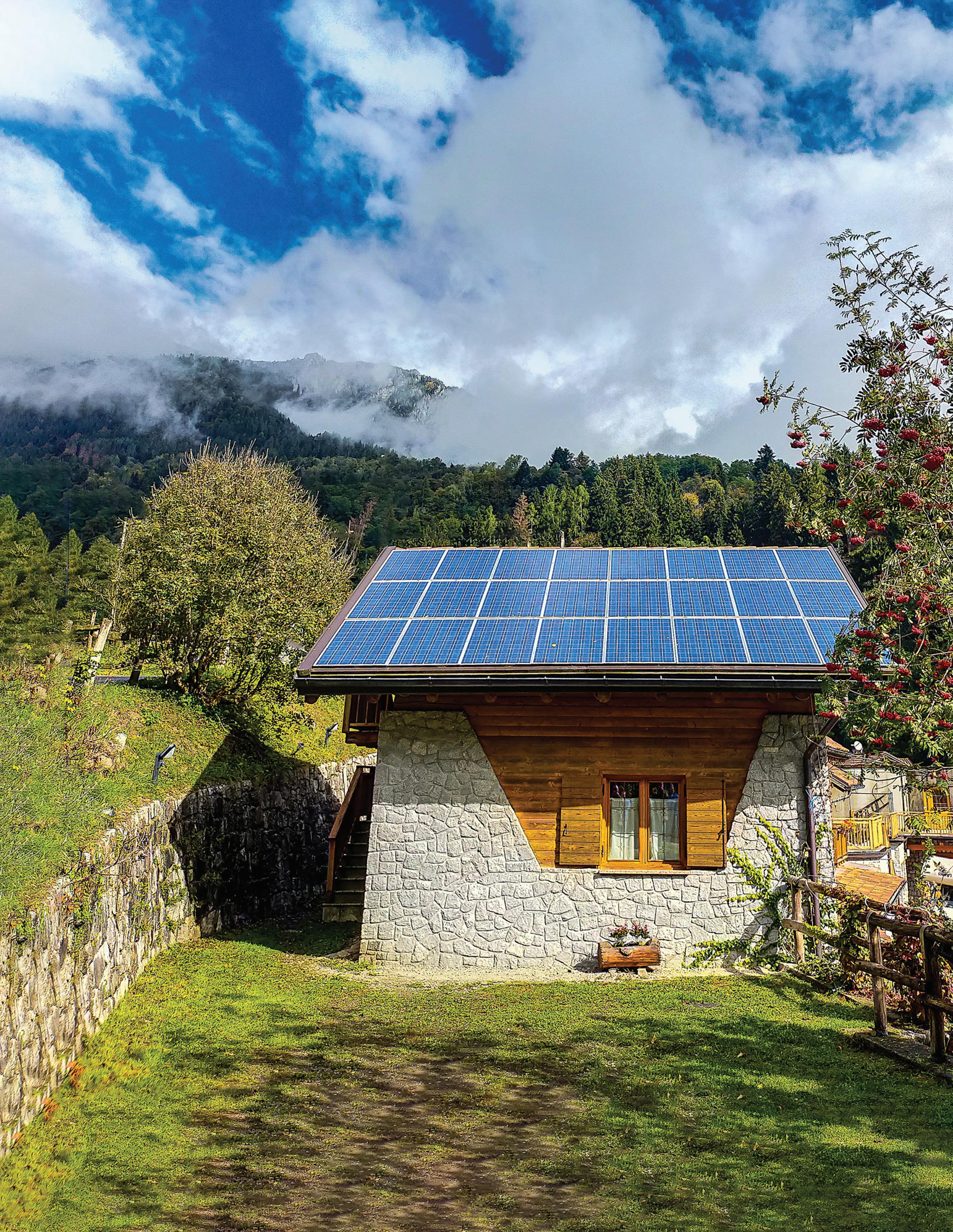


















MOTHER EARTH NEWS EARTH NEWS APRIL/MAY 2023 Printed on recycled paper Issue No. 317 • $5.99 US • Display until May 15, 2023 FOREDIBLESPICYFLOWERS YOURGARDEN•PAGE36• Forage for Edible Mushrooms, P. 44 What to Do If You Find a Wild Bird Egg, P. 41 How Long Do Chicks Need Heat Lamps?, P. 57 Plan Community Groups for Monarch Habitats, P. 52 PLAN FOR YOU, P. 14 Sustainable Homesteading HOW MANY PANELS DO YOU NEED?, P. 26 Power Your Home with Solar Organic Gardening HARNESS NITROGEN TO FEED YOUR PLANTS, P. 20
L Series 24.8 HP Land Pride performance-matched implements

Don’t count the hours in the day. Count what you did in those hours with the L Series tractors. The power, size and versatility to take on every challenge. A solid steel frame that never backs down. The #1 selling compact tractor series for a decade* is built right. To get more done right.


See #14 on page 89


KubotaUSA.com *Based on EDA tractor sales data of under 40 horsepower models from 2009 to 2021. © Kubota Tractor Corporation, 2022. This material is for descriptive purposes only. Kubota disclaims all representations and warranties, express or implied, or any liability from the use of this material. For complete warranty, safety and product information, consult your local Kubota dealer. For the complete disclaimer, go to KubotaUSA.com/disclaimers and see the posted disclaimer. Keeping track of everything you got done. That’s the hard part.
My winter garden is a mess. Dead plants hang off my trellises, and leaf debris litters my walkways.
Autumn and the killing frost happen during hectic times. I’m often traveling for work, preserving my harvests, or facilitating livestock breeding during ruts. We’ll rush out, pack tomatoes in cardboard boxes, and save what we can. The frost takes it all, leaving limp plants that soon dry out. But that’s fine. It’s all part of the scientific process, and it saves me a whole lot of time.
Organic gardening involves science, but you don’t need to be a scientist to grow a successful garden. A couple of simple principles go a long way:
1 Elements can’t be created or destroyed. They must be made available for plants.
2 Microbes can’t work without food (organic material), water, and the right temperatures.
Those two rules explain why many organic gardeners:
• Compost kitchen scraps. Minerals in vegetable peels and cores become minerals in next year’s produce.
• Don’t pull frost-killed plants unless they’re invasive; we let the roots break down in the soil so microbes can use them as organic material.


• Don’t till our gardens, because it exposes microbes to killing factors, such as sunlight and heat.
• Mulch or cover crop to keep soil temperatures and moisture levels optimal for beneficial microbes.
Like many gardeners, I used to believe I had to till in spring. It took a few years for me to understand how no-till systems work, but once I did, I never looked back. When those frost-killed crops dry out, I crush them to ground
the Mess
level and then cover them with compost and manure. I cut particularly woody plants at soil level and chop the tops into my compost piles. Then, I let winter do what winter does best: break down cellular structures with frost and moisture. Spring microbes take over when the weather warms, since their food is already available. By planting time, the material has mostly broken down.
To sow seeds, I chop the top layer with a shovel until fine enough for the desired seed size. I dig a hole just big enough for the root ball for transplants, and then I push everything back around the plant. And I mulch as soon as possible. This is crucial for my desert gardening in Nevada. Mulch everything.
Of course, the science of organic gardening differs for specific gardens and specific areas. I don’t burn plants or apply wood ash, because my groundwater has an alkaline pH of 8.0, but this practice can benefit root crops growing in acidic soils. And I’ve learned that leftover cheesemaking whey is an amazing microbial acidifier for alkaline soils.
Which area-specific techniques do you use in your gardens? What tips can you offer other readers who want to leave behind chemical fertilizers or destructive tilling practices? We’d love to hear from you.
And don’t miss Andy Wilcox’s article, “Repairing the Nitrogen Cycle in Your Garden” (Page 20), for a little easy-tounderstand science about why leaving your winter garden “a mess” might be just what it needs. (Plus, it’s a great time-saver for busy autumn schedules.)
May all your garden’s elements be bioavailable,
CLASSIFIED ADVERTISING 866-848-5416; Classifieds@MotherEarthNews.com


NEWSSTAND
Director of Newsstand & Production B C
Director of Sales B L


Director of Events & Business Development A P

Director of Information Technology T S

Director of Finance & Accounting R H
Founders J J S M E N (ISSN -) April/May 2023, Issue No. 317.
M E N is published bimonthly by Ogden Publications, Inc., 1503 SW 42nd St., Topeka, KS 66609-1265. Periodicals Postage Paid at Topeka, KS and additional mailing offices. POSTMASTER: Send address changes to Ogden Publications, Inc., 1503 SW 42nd St., Topeka, KS 66609-1265. For subscription inquiries call 800-234-3368. Outside the U.S. and Canada, call 785-274-4365; fax 785-274-4305.
Subscribers: If the Post Office alerts us that your magazine is undeliverable, we have no further obligation unless we receive a corrected address within two years. © 2023 Ogden Publications Inc. Printed in the U.S.A. In accordance with standard industry practice, we may rent, exchange, or sell to third parties mailing address information you provide us when ordering a subscription to our print publication. If you would like to opt out of any data exchange, rental, or sale, you may do so by contacting us via email at CustomerService@OgdenPubs.com. You may also call 800-234-3368 and ask to speak to a customer service operator.

WWW.MOTHER ARTHNEWS.COM XXXX/XXXX XXXX 1 News from MOTHER Embracing
68C 100Y 24K Pantone 363C THE ORIGINAL GUIDE TO LIVING WISELY ® ISSUE EDITORS Editorial Director M A Editor at Large O H. W III EDITORIAL TEAM I B K G L H R M J M I R A S A S C S J T C T ADVERTISING DIRECTOR B E; BEscalante@OgdenPubs.com ART DIRECTION AND PREPRESS Art Director M
S
T O
T.
WEB AND DIGITAL CONTENT Web Content Manager
DISPLAY ADVERTISING 800-678-5779; AdInfo@OgdenPubs.com
Newsstand Manager B C CUSTOMER CARE 800-234-3368; CustomerService@OgdenPubs.com Publisher B U Director of Circulation & Marketing C O
• CHIP & SHRED with power to spare
• BIGGER ENGINES beat the competition
• BUILT USA TOUGH for smooth operation
• Easy to maneuver and EASY ON YOU
Tow-Behind

• #1 in vacuum power and capacity

• NEW PRO MAX model holds up to 450 gallons
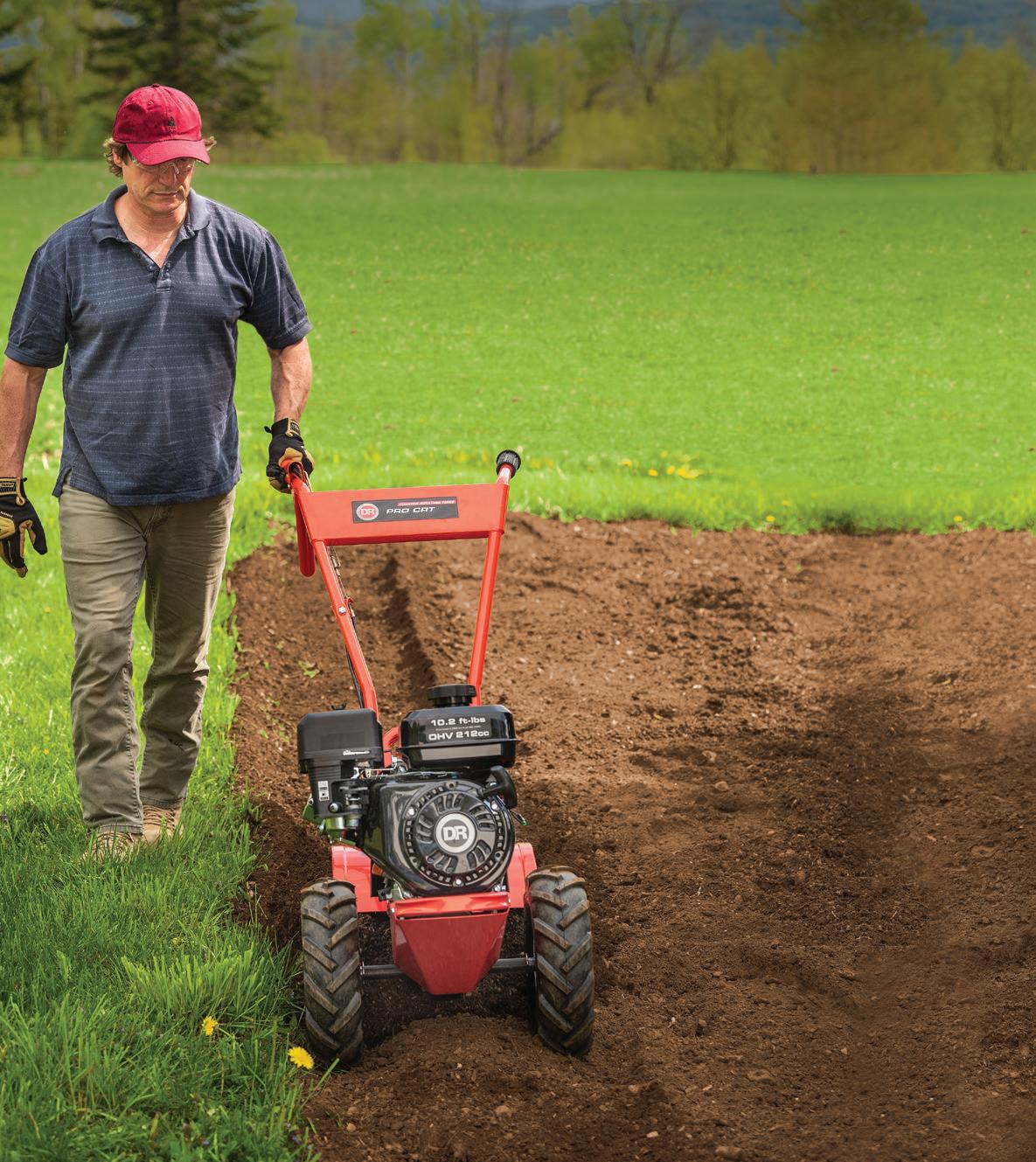



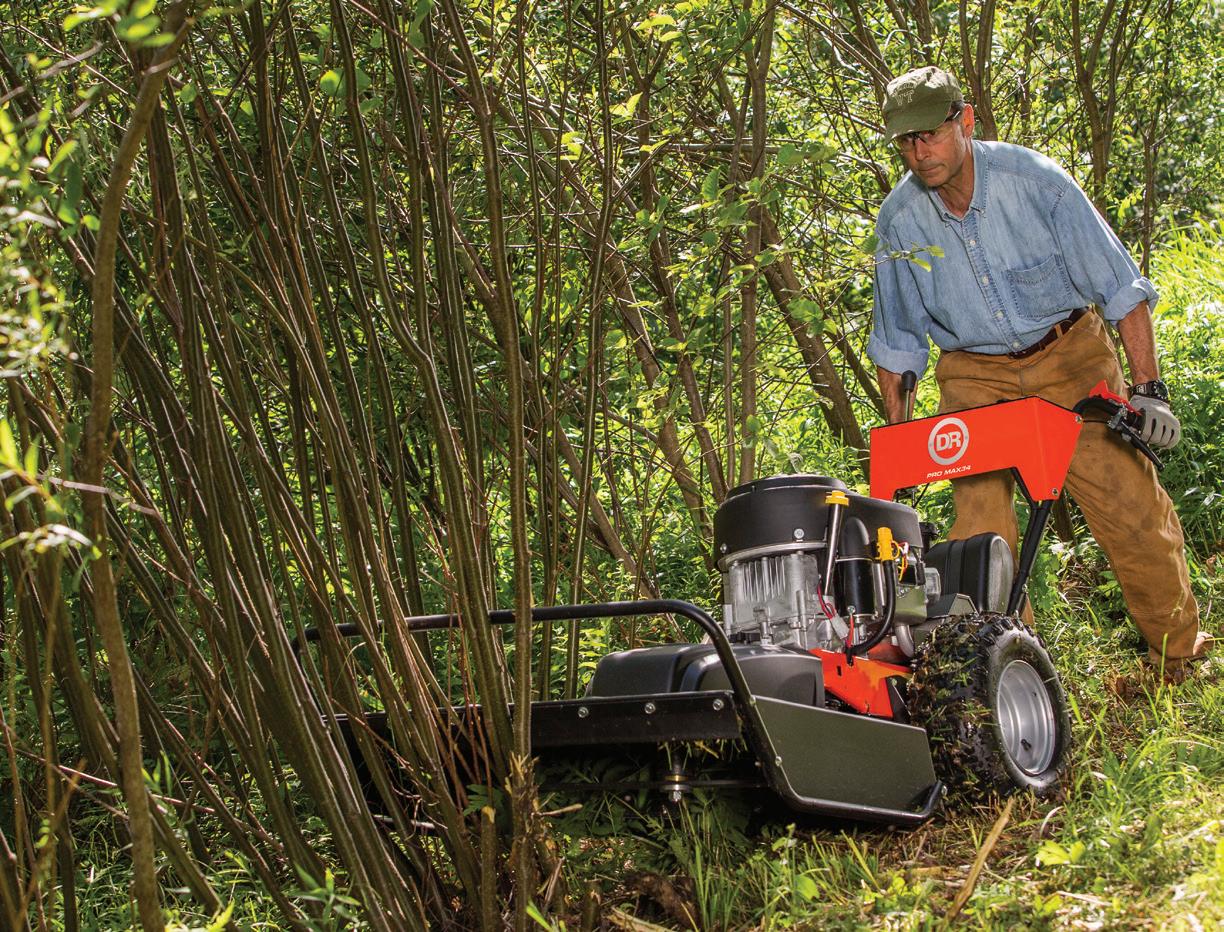
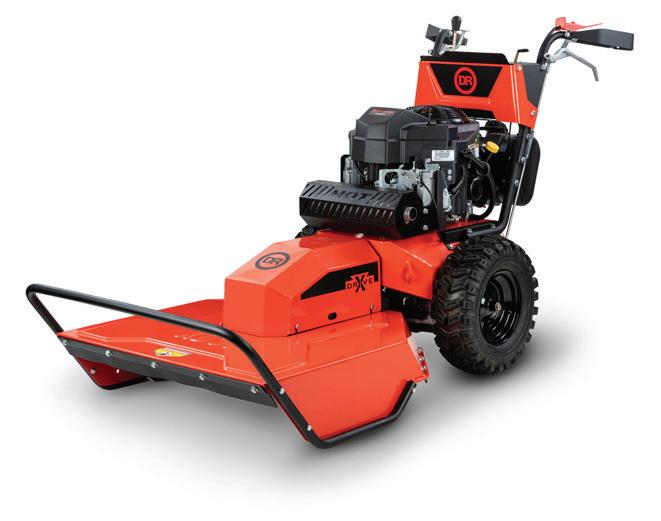





• All models newly redesigned with up to 20% more capacity

















Walk-Behind




• NEW PILOT XT models ll paper leaf bags for curbside pickup

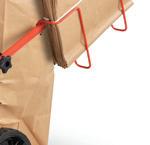

• Collects & mulches up to 50 lbs of leaves










• Includes onboard caddy for extra bags

SOME LIMITATIONS APPLY FREE SHIPPING SALE! DR Power Equipment A GENERAC POWER SYSTEMS COMPANY DRfieldbrush.com ® Brush Mower! Devour Brush Piles with a DR ® Chipper Shredder!
DRchipper.com DRleafvac.com The LEADER in Leaf Vacs!
USA ENGINEERED AND BUILT Assembled in the USA using domestic and foreign parts. USA ENGINEERED AND BUILT Assembled in the USA using domestic and foreign parts. DR® Leaf & Lawn Vacuums Do it Right with DR® USA ENGINEERED AND BUILT Assembled in the USA using domestic and foreign parts. Starting at Just $1999 99 The LEADER in Field & Brush Mowers
Up to 2X THE POWER of the competition
•
of
options PLUS Tow-Behind, Commercial & NEW ELECTRIC models NEW DESIGN
• CUT 3" brush & thick eld grass with ease • WIDEST SELECTION
deck sizes and features • GO-ANYWHERE power steering & hydrostatic drive













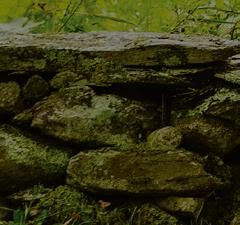





















Request your FREE PRODUCT CATALOG Online or Toll-Free at 800-456-0516 GoDRpower.com • Fill in potholes and smooth out washboard • Loosen & redistribute existing material • Tow with your ATV, UTV, or tractor DRpowergrader.com Make Your Driveway Like NEW with a DR ® Power Grader! Haul up to 800 lbs with a DR ®Powerwagon! DRpowerwagon.com USA ENGINEERED AND BUILT Assembled in the USA using domestic and foreign parts. DRrototiller.com Great Gardens Start with DR ® Rototillers! DRtrimmer.com USA ENGINEERED AND BUILT Assembled in the USA using domestic and foreign parts. Discover the POWER and PRECISION of a DR ® Trimmer Mower! • Self-propelled hauler • Powers up hills with ease • Powered dumping • Converts to a atbed • Bust sod and churn through the most compacted ground • Prepare seedbeds or till garden waste back into your soil • Full line includes walk-behinds, tow-behinds, and cultivators • 5X the power of a handheld trimmer • TRIM precisely without arm fatigue • MOW where a bladed mower can’t • TOUGHEST trimmer cord available
14
the Plan
32
20 Repair the Nitrogen Cycle in Your Garden

Restore your soil’s ability to circulate nutrients.



36 Edible Blossoms to Spice Up Your Cooking
Grow these pretty pops of color and flavor.
62 Hometown Hacks: DIY Greenhouse
Learn how to build a low-cost, portable greenhouse.

68 Country Lore
A wildlife rehabber advises what to do if you encounter a wild bird egg or baby bird this spring.
Explore mushroom foraging by getting to know these edible favorites.
52
Protect pollinators by building relationships with your neighbors and exchanging plants and information.
Reader tips for homemade body products, keeping birds out of berries, natural tick and ant control, recycling yarn and shower curtains in gardens, growing beans for shade, chive blossom vinegar, fencing with winery slats, and making bee boats.
74 Ask Our Experts
Expert advice on buying your first bees, growing cut flowers, and avoiding toxic galvanized wire.
96 Photos from the Field Reader-submitted photos.

C lo C kwise from top left : adobe sto C k / graziano va CC a wiresto C k ; adobe sto C k / last 19; adobe sto C k happy C ulteur ; adobe sto C k / lost in translation ; john moore 1 News from Mother Embracing the Mess 6 Dear Mother Reader letters of inspiration, community, and more. 8 Green Gazette: Funding and Support for Your Farmers Updates on obstacles facing young farmers, the Keystone Pipeline spill in Kansas, a victory for Klamath salmon, a renewable energy plant in Oregon, rooftop and reef gardens, and floating wetlands. 12 Firsthand Reports: Nature Provides Spending time in nature and away from the “rat race” can be refreshing and relaxing. 26 Suited to Solar Advice for assessing whether you can generate enough power for your household needs.
Big Burns
nutritious spring grass
curtailing troublesome
Controlled pasture burns can boost
while
weeds.
41 How to Help Wild Baby Birds
44 Dead Tree Delicacies
Organize a Local Butterfly Group
and
to
57 All About the Heat How to keep chicks warm and healthy
when
transition them to outdoor coop life.
57 26 74
Table of Contents April/May 2023
Planning
The first step to developing any new homestead is determining how it’ll be done.
HEALTHY FOOD Stories with this logo are available in audio form at www.MotherEarthNews.com
GROW
!

“Is there any possibility of receiving transcripts of your podcasts?”






Transcripts for Podcasts


EDITORS’ PICK A Gift from Where It All Started
I started reading your news while in high school back in the ’70s. Forty years ago, I started my business of landscaping, maintenance, and growing Christmas trees, plus a wreath and garland fundraising business to help school and church groups.

My small farm had dairy, beef, poultry, sheep, gardens, and more. My wife and I raised seven kids, with 13 grandkids and counting. We still have the tree farm and gardens; the kids have the livestock. With need of new knees, my wife and I moved to town five years ago. All of our kids enjoy the lifestyle they grew up with in one way or another. But this gift to them (MOTHER EARTH NEWS subscriptions) will maybe show them where it all started. My life has been great, thanks to you folks.
N. Houston Via mail
I found your podcast through your email — my husband gets your magazine, and I get the email. I’m hoping to find transcripts for your podcasts — I don’t hear well and would really like to access the information provided. I’m especially interested in Podcast Ep. 170 with Dr. Temple Grandin. Is there any possibility of receiving transcripts of podcasts for those of us who read but don’t hear well?






Thank you for your time and attention.
Leah Via email
would be so cool to see my garden shed in your Dear MOTHER department. I believe a while back you had a garden shed contest — but, of course, I missed that.
This shed (see photo below) was on the property where I live when I purchased the home — with an acre of land — in northeast Iowa in 2013. Originally, it was home to a woodburning furnace that was supposed to heat the house.
Hi Leah,
You’re not the first subscriber to request transcripts. And we’ve got great news! We’re working on including transcripts on our website as part of our initiative to keep our podcasts accessible for as many people as possible. You can find the podcasts and trancripts online at www.MotherEarthNews. com/Podcast.
— MOTHER
Little Garden Shed
I’m reading (cover to cover) the August/September 2022 issue and love the photos and stories about subscribers’ garden sheds. I’ve been a subscriber to MOTHER EARTH NEWS for decades — with some small lapses (sorry!). And it


Well, after two winters of freezing while trying to heat the house with wood, I realized (after looking at the owner’s manual) that the unit was supposed to be installed in the basement alongside the furnace. Our heating and cooling consultant did
(CONTINUED ON PAGE 82)
Dear MOTHER
6 MOTHER EARTH NEWS April/May 2023 T OP : C OURTESY OF R OSALIE W INARD ; B OTTOM : M ARY H YLAND


Your RV is all checked in for great protection Get coverage from a leader in RV insurance. 1-800-PROGRESSIVE / PROGRESSIVE.COM Progressive Casualty Insurance Co. & affiliates. Quote in as little as 4 minutes See #29 on page 89
Funding and Support for Young Farmers
Late last year, the National Young Farmers Coalition published the results of its 2022 National Young Farmer Survey, with responses gathered from past, present, and aspiring farmers up to 40 years old. The survey’s data shows there are many obstacles facing young farmers.
Farmers’ top reported challenges include finding affordable land to buy, accessing capital, affording health care, meeting the costs of production, finding housing, and paying off student loans. Across the board, young farmers who are Black, Indigenous, and people of color are disproportionately affected.
Fortunately, farmers have some new opportunities to gain the support they need. In November 2022, the U.S. Department of Agriculture announced a $24 million investment into organizations and institutions that train beginning farmers and ranchers. In a press release, the National Institute of Food and Agriculture’s Acting Director Dionne Toombs says, “[Beginning farmers’] success, especially in the first 10 years, often hinges on access to reliable, science-based information and the latest
educational resources so they can improve their operations’ profitability and sustainability long-term.”

A fresh wave of new farmers includes many young people from populations that’ve historically been excluded from traditional financing. Nonprofits can help, such as a community-led investment fund called Black Farmer Fund, which provides supportive capital to Black farmers in the northeast U.S.

Onyx Ramírez, communications lead for Black Farmer Fund, stresses the importance of investing in your community. “The challenge that we look to remedy and overcome with our work is access to capital,” she says, adding that farmers need money to run their businesses, establish connections, increase production, hire people, access land, and get support for resources like bookkeeping and legal help. “We’re really working to create a supportive environment for all of that. … If we intentionally invest in our community, we can continue to grow and reach new heights. … There are a lot of organizations that are doing really incredible work for new Black farmers.”
To learn more, visit www.Farmers.gov/Your-Business/BeginningFarmers and www.BlackFarmerFund.org.
Some organizations are developing support and resources to help young farmers succeed.
Green Gazette By Darby Stipe
A dobe S tock /J M AAS / peoplei MA ge S co M
Keystone Pipeline Spill in Kansas

On Wednesday, Dec. 7, 2022, operators from TC Energy were alerted to an oil spill in Washington County, Kansas, from its Keystone pipeline. Nearly 600,000 gallons of oil spilled into Mill Creek and the surrounding area. This pipeline was transporting crude tar sands, also known as diluted bitumen. Bitumen is difficult to clean, because it’s a thick, viscous substance. Unlike crude oil, which tends to stay on top of the water, bitumen sinks to the bottom of waterways and coats everything it touches in a sticky substance. The longer diluted bitumen sits on land, the farther it can seep underground, potentially destroying soil health and threatening root systems in the process. Cleanup efforts can take years and cost upward of $1 billion.
The Keystone Pipeline System is an oil pipeline system in the U.S. and Canada owned by TC Energy. This system has now been the subject of 23 reported leaks since 2010. Though the cause of the Kansas spill is still unknown as of this writing, TC Energy reportedly got a special permit from the Pipeline and Hazardous Materials Safety Administration to operate some areas of the pipeline at a higher pressure than ordinarily allowed. The permit has prompted questions about whether the higher stress on the system contributed to the spill.
Citing safety concerns, TC Energy issued a no-fly zone over the spill area from Dec. 16 through Dec. 21. Environmental advocates and public officials are urging transparency through the cleanup process.
A Victory for the Klamath Salmon

In November 2022, the Federal Energy Regulatory Commission (FERC) voted to remove four dams on the lower Klamath River, launching the country’s largest river-restoration efforts and the world’s largest dam-removal project. Located in Northern California and southern Oregon, the Klamath River has been a crucial route for salmon, which traditionally provided food for many Indigenous tribes in the area. The dams were built mainly for hydropower and flood control, but they also reduce salmons’ spawning areas and increase disease risk. Tribes, their allies, and various stakeholders have been advocating for the


dam removals for more than 20 years to save the Klamath salmon. The FERC has finally agreed and ruled in their favor. (The Yurok Tribe also granted the Klamath River personhood to protect it. Read more at www. MotherEarthNews.com/ Green-Gazette-Klamath.)
Dam removal can be a long process. First, roads will need to be built to allow heavy machinery to gain access to the dam sites for their removal. In 2024, the reservoirs will be drawn down between salmon runs to have the least impact on aquatic life, and then the dams will be removed. By the end of 2024, the river should be open for the return of the salmon.
www.MotherearthNews.coM 9
Green Gazette
F ro M top : t ony A o l S on (2); A dobe S tock / d A vidrh
The dam removals from the Klamath River will restore salmon to the area.
A Mother earth News staff member captured downstream damage at Mill Creek after the oil spill and recalls the smell of diesel in the air.
Oregon Renewable Energy Plant
Oregon opened the country’s first renewable energy plant in October 2022. Able to power about 100,000 homes, the Wheatridge Renewable Energy Facility combines the use of solar and wind power with battery storage.

Renewable energy sources don’t provide the same amount of energy evenly throughout the day, and electricity use tends to peak in the evening hours, causing a problem called “intermittency.” Solar energy peaks during the middle of the day with the sun, and wind starts to pick up in the evenings. The batteries will help smooth out the transition period between the two to ensure there isn’t a lapse in service.
Renewable energy projects can still present challenges. Created in a partnership between NextEra Energy Resources and Portland General Electric, the plant requires massive lithium batteries to run continuously. Solar and wind power development may be carbon-free, but their components and facilities must be manufactured using energy that may not come from renewables. Residents who live near existing or potential solar or wind farms may also have concerns about their appearance or losing valuable farmland to them. Additionally, solar panels and wind turbines require large amounts of land to mine for materials, so it’s essential for policymakers to ensure an ethical and environmentally sound supply chain.
Rooftop gardening researchers may have found a game-changing new discovery.
Promising Results from a Rooftop Garden
In Boston, researchers found that vegetables grown in rooftop gardens near the buildings’ CO2 exhaust vents experienced a significant increase in plant growth compared with those grown farther away from the vents. HVAC systems ventilate buildings with fresh air and oxygen while pumping stale air and CO2 out through waste vents. The CO2 levels in buildings with large amounts of people can build up to high levels, and researchers wanted to find a way to utilize these emissions. The study used spinach, which is highly reactive to CO2, and corn, which is less sensitive to CO2 levels. Both plants experienced high levels of growth when placed next to the CO2 vents, though slightly increased temperatures near the vents may also be a factor. It’s unclear if nutrient levels also get a boost with the CO2, but this study is an excellent sign for urban growers and rooftop gardeners to keep innovating.

Great Barrier Reef Gardening

Coral reefs around the world are experiencing a steep decline with rising global temperatures. The Coral Nurture Program in Australia is working on coral “gardening” to help increase the survival rate of local coral species. A partnership between tourism companies and scientists, the program has created underwater coral nurseries where divers attach broken, healthy pieces of coral to a frame for them to regrow. Then, they reattach the coral to the damaged reef to help nurture recovery. Corals are tentacled, squishy creatures that secrete calcium carbonate to protect themselves and build reefs. They form a symbiotic relationship with algae, which provide food from the sun and give coral their exotic colors. The algae start emitting toxins when temperatures get too high, and the corals eject them and thus their color leading to coral bleaching. The project isn’t a permanent solution in the face of climate change. But, according to Master Reef Guide Russell Hosp in a Washington Post story, it’s designed to “give Mother Nature a little bit of a boost.”
Floating Wetlands Clean Urban Waters
challenges.
Researchers from around the world are exploring the benefits of creating artificial floating wetlands in urban areas. These wetlands have the potential to clean water pollution, provide habitat for other native species, and lower excess nutrient levels in rivers and streams. By using specific plant species, algal blooms can be reduced while industrial contaminants are absorbed into plant tissue. In an article, Yale Environment 360 reports that one researcher in Boston found that 1 acre of a floating wetland could take in nutrient pollution from 7 to 15 acres of urban development, offering hope for a new way of cleaning industrial areas. For these projects to be successful, heavily polluted waterways would require hundreds of floating wetlands and the maintenance costs to go along with them. After the plants take up the excess nutrients or chemicals, such as PFAS, they’d also need to be removed to avoid re-contaminating the waterways. Despite these obstacles, floating wetlands may have the potential to make a positive difference in a variety of urban environments.
F rom top : A dobe S tock / b A ll 141030; A dobe S tock / c h A d
Green Gazette 10 MOTHER EARTH NEWS April/May 2023
Renewable power can still pose environmental











Sprayers Vacuums Shredder Chippers Tillers ® www.MacKissic.com (800) 348-1117 Leaf Blowers Three Point Hitch Wood Chippers Heavy-duty, American-made, built to last equipment for the DIYer to easily maintain their properties and lifestyle. Proudly Made inthe USA See #17 on page 89
Nature Provides
water with you. Some people boil water for half an hour and let it cool; others use water-filtration systems or iodine. Plus, if you’re near a body of water, you can go swimming. This is a great way to start your day.
By Joseph Neel
Nature provides for us in a variety of ways, whether we recognize these gifts or not. But nature isn’t just there for us to exploit. By following a few basic guidelines, anyone can engage with nature in a more grateful way. There’s nothing to it but to do it!
These days, it’s a high priority for some people to simply get out and get in touch with nature. It can be therapeutic to spend time away from technology and in the company of the relaxing sounds and fresh scents of the outdoors, if you’re willing to lace up tight and venture out into the splendor.
Nurtured by Nature

If you can accept nature as it is, it can work in your favor. If gravity is on your side, you’ll have to do much less “work.” Dry fallen limbs, trees, or driftwood can help you stay warm. You can also sit on wood or place wood underneath your equipment so nothing gets damp.
After putting out fires, simply dump leftover ashes on the coals to make sure the fire is out; this is especially effective when the ashes are still damp from morning dew.
If you’re near moving water, you can choose from a variety of methods to stay hydrated, as well as wash dishes and do laundry, without having to bring all your

Whether you’re camping near a body of water or not, there’s plenty you can do outdoors during different times of the year, such as hiking; looking for mushrooms; gathering firewood, sticks, and dry leaves for campfires; bird-watching; and simply walking, possibly with a walking stick. You can gather trash and leave the area better than you found it; some areas have trash cans nearby, or you can take the trash with you when you leave.
Be Prepared
While the saying “always be prepared” is a noble enough guideline for activities like hiking and camping, sometimes, less is more. But depending on the area where
Firsthand Reports
Current River, where the author camps, is fed by cold springs and stays cool year-round.
F lickr /G ran G er M eador
With a bit of preparation and some durable supplies, spending time out in nature and away from the “rat race” can be refreshing and relaxing.
you’re staying, the weather can be unpredictable, and one small hole in your tent can leave you a sleepless mess. Having a simple repair kit and a first-aid kit may save you from minor headaches and injuries, as will doing your homework when planning where to go.
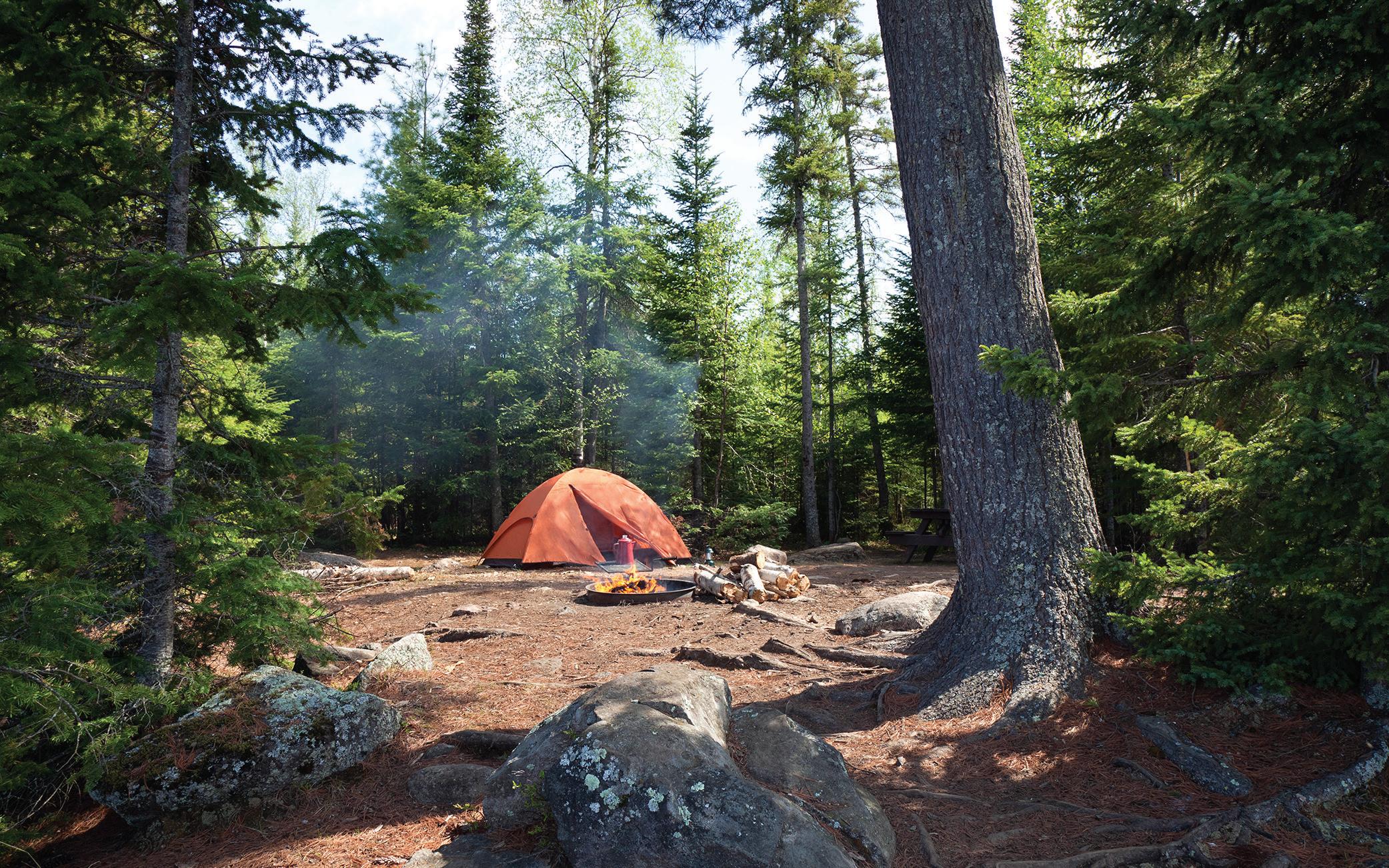
Bring well-cushioned, durable, comfortable boots, whether camping or hiking. A backpack with a bladder and straps may come in handy, as well as a cot. Set up a place where you can stay comfortably but still pack up and leave relatively simply.
Many times, you’ll get what you pay for, though knowing where you can cut costs (as well as weight) is useful. I’ve found relatively inexpensive but quality zip-up hammocks with pockets and mosquito-proof netting. Some are even built for couples to sleep in! If you have a sturdy knife, make sure it’s sharp.
If you’re hiking, be sure to bring plenty of clean water along, as well as foods with iodine, sodium, and magnesium to keep you going. For coffee, cheap instant coffee packets can lessen the mess. Research rocket stoves for cooking. You may also be able to use running water or river stones to keep items cooler longer (or simply use a thermos).

For hygiene, pack some sanitizing hand wipes. You may also want to bring baking soda, vinegar, and lemon juice for basic cleaning. Natural and biodegradable products are ideal, such as pine tar oil or goat-milk soap. I like to use a charcoalbased toothpaste with coconut oil and
peppermint for oral hygiene. You can use running river water for many nondrinking purposes; just remember to be cautious. And position yourself carefully in relation to the river; if it rains, you may have to relocate or wait it out on higher ground in your tent or below a tarp.
If you’re well-prepared with durable equipment and someone knows where you are and when you’ll be back (so they can notify 911 just in case), then you’ll be set up for a pleasant outdoor experience.
Do Your Research
Become familiar with different trees and what they offer. Some trees provide wood that’s good for whittling and making walking sticks and canes. Some wood is good for starting fires, while other wood is good for keeping them going. Other trees may provide nuts and fruits, such as pecans, mulberries, and persimmons. You can use pine needles in tea or rub them on your skin if you’re trying to be stealthy while hunting deer. If you spot elm trees near a creek or river, you may be able to find the famous morel mushroom nearby just make sure you can positively identify the mushroom or are with someone who can!

Savor Nature
Whether you’re hiking, fishing, wading, fossil-hunting, swimming, foraging, or cooking by a warm fire, none of it is boring by any means. I live roughly 2 miles from beautiful Current River, which is fed by cold springs some 40 miles up-
stream. You can fish for trout in the river or fish for smallmouth bass where the water gets warmer, near small tourist town Doniphan, Missouri. The river stays cool pretty much year-round and is refreshing in summer. It also stays relatively cool on the bank, especially in the shade of oak, hickory, and elm trees, among others.
Wherever you live, there are plenty of free areas you can visit. Some places charge a small fee to park or camp or they require conservation fees to keep the area clean. Depending on where you live, you may want to invest in a metal detector or a boat for a bit of additional fun. You can also purchase a fishing license, which helps keep areas clean and lakes and rivers stocked with fish.
I don’t like to hunt or party; I enjoy simply sitting on a sand bar at dawn, watching the mist rise from the water. I see and hear all kinds of wildlife, such as deer, owls, bats, birds, squirrels, and beavers. I listen for the beavers making splashes at night with their wide, flat tails. I hear coyotes howling at night too. I’ve seen cottonmouth snakes and even panther tracks! I love the serenity and the small thrills, the kinds of experiences I wouldn’t trade for anything in the world.
www.MotherearthNews.coM 13
From left: Rocket stoves are an energy-efficient way to heat food or water. Aim for a no-frills camping setup that’s comfortable but easy to pack up.
F ro M le F t : F lickr /M ichael c line ; a dobe S tock d aniel t hornber G
Joseph Neel is a seasoned writer who grew up traveling around the world and now lives in Missouri. He loves nature and the outdoors.
Planning the Plan
to
By James A. “Hoss” Boyd and Kerena Reese
Several months ago, we at TeraVolt Energy had a conversation with Ogden Publications Publisher Bill
to bring a sustainable homestead from concept to completion, it’d present a great opportunity for us to share ideas with readers.
Before building any homestead, it must be planned out. This is the first in a series of articles about what should go into a homestead plan. Plus, expect some firsthand experiences from Hoss’ days on a farm in the Ozarks and from the three years he lived in Alaska.
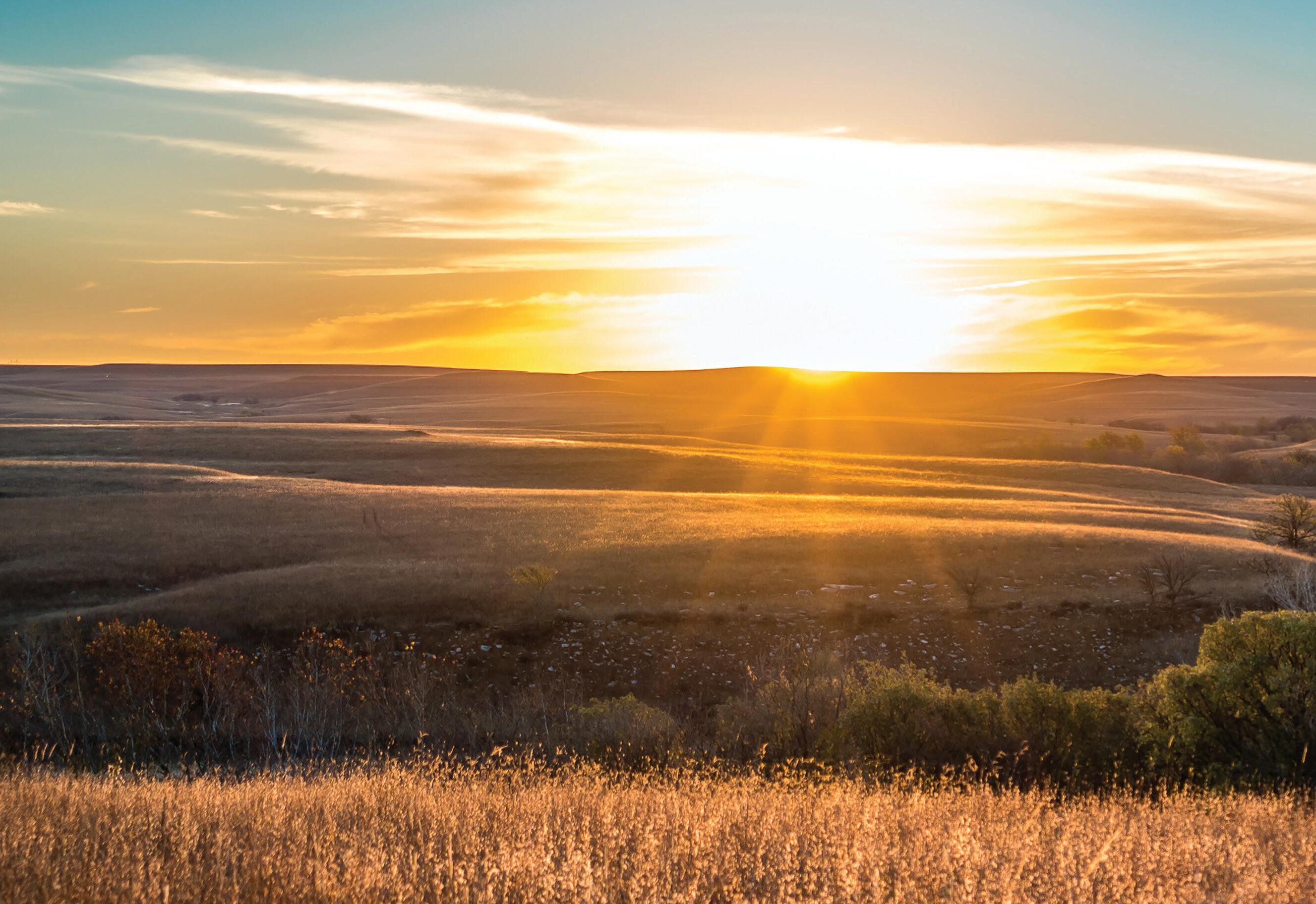
Setting Priorities
Imagine you’re dropped off in the middle of the wilderness. Your only supplies are what you can carry on your back and maybe on a horse or all-terrain vehicle. How do you begin establishing a place to live? In a normal survival scenario, the priorities are water, food, and shelter, and this idea can translate into starting a homestead too.
Uhler
and Editorial Director Marissa Ames about the Mother Earth News Sustainable Homestead project. Ogden
cultivates some vacant acreage behind the company headquarters in Topeka, Kansas. Staff members have discussed different options for using the space, from community gardens to a totally sustainable homestead. For those of us in the renewable energy world, that means living “off the grid.” We all agreed that regardless of how long it might take
In an environment like Alaska, there’s usually plenty of water around, and food can include fish as close as the nearest
14 MOTHER EARTH NEWS April/May 2023
The first step
developing any new homestead is determining how it’ll be done.
A bove : A dobe S tock /A rt
stream. So if you were to start your homestead at spring thaw in Alaska, shelter would be your top priority, followed by food to store for winter. For the Kansas Mother Earth News Sustainable Homestead, shelter will be a priority. But unlike Alaska, where running water is practically everywhere, digging a well must be first priority in Kansas.
Determining water and food resources should fall into the category of site preparation prior to relocating to your homestead. Think about where you live and the types of natural resources available. Are water, food, and shelter easy or difficult to access on the property? Additionally, do you need to clear any of the land to put up a fence, plant a garden, drill a well (with a solar-powered pump), or build an outhouse? Can you choose plants and food sources that are native to the area and resilient to the local climate? It’s much better to know the answers to these questions before moving day arrives.
Determining Your Shelter
How do you quickly establish shelter on your homestead property? Weather can help inform you of your shelter options and limitations. For example, many places in Interior Alaska have bitter winters, but rarely do they have high winds, so a tent may be tolerable as temporary shelter so long as you have a source of heat. But in Kansas, a tent might not be the best option, considering


the high winds and violent storms. There, a permanent structure that can be built and occupied as soon as possible would be necessary.
What are some shelters that you could put up quickly and occupy soon after? Assuming you’re limited to locally sourced materials once you’re on-site, here are a few options.
Pre-built storage building. Any major lumber company has ready-to-build
www.MotherearthNews.coM 15
A dobe S tock /J on
Understand your environment before solidifying your homestead’s water, food, and shelter sources. Alaska (above), for example, has cold temperatures and an abundance of running water.
storage buildings, from the small garden shed to the two-story miniature barn. It won’t come insulated, wired, or plumbed, but it’ll be fully enclosed. If you’re going to camp out, a storage building would be slightly better than a tent. You could certainly use it for sleeping and cooking while you’re making it more habitable. Shipping container. This option might be a more secure approach, but it’ll require some extra effort to set up. Shipping containers come in a variety of sizes and conditions. It’s possible to get a 40-foot “box” for about the same price as a 20-footer. But it’s much easier to offload, move, and set up a 20-foot shipping container than it is to set up the longer and heavier 40-foot version. Most container-home builders prefer the 20-foot version for siting in remote areas. Containers that’ve only been used for a single voyage are called “onetrippers” and come with documentation to prove they didn’t contain hazardous materials. These are the highest-priced container option aside from brandnew. The used ones are a great option for the container-home builder, because they’re much cheaper, and testing labs


can verify the safety if there’s a concern about toxic residue. Although containers have been around the block a few times and may have cosmetic issues, such as dents, holes, and scratches, the builder can easily hide the defects even before delivery to the homestead. In our energy business, a shipping container is also a great option to use as a base for mounting solar panels. Three 20-foot shipping containers side-by-side can support enough solar panels for plenty of homestead electricity and have enough empty space for living quarters.
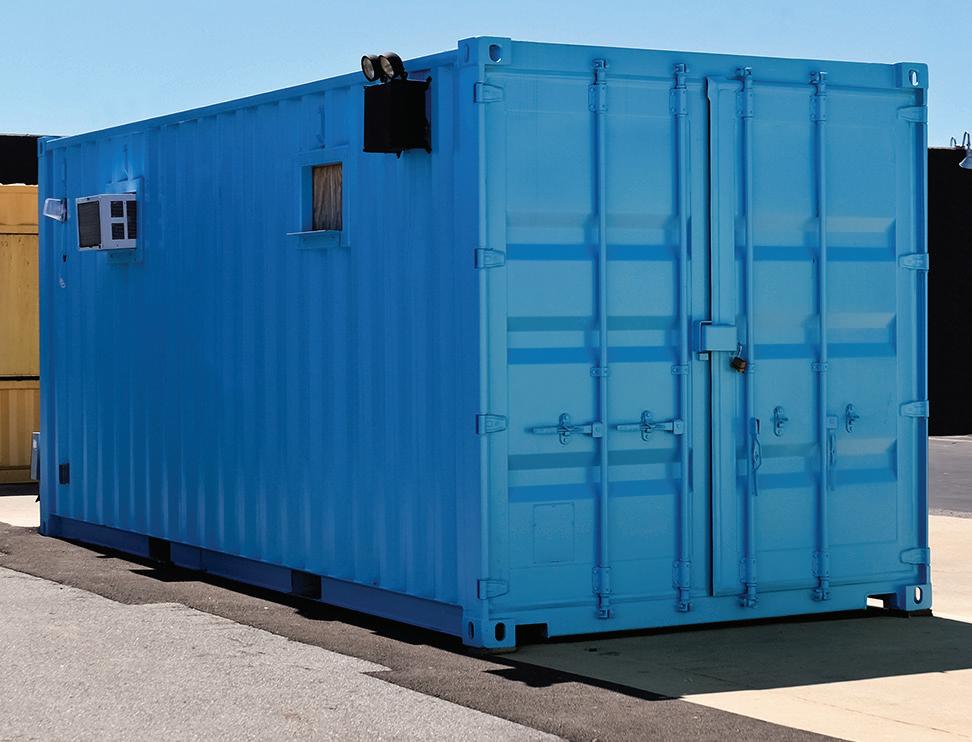
Prefab homes. This is the most expensive approach of the delivered homes but requires the least amount of work. For a sustainable homestead, plan to emphasize efficiency the smaller the dwelling, the less energy it’ll require to maintain it. Prefab homes can come in a variety of sizes and prices. A tiny home can be a doit-yourself project off-site and brought in on a flatbed trailer (like a typical mobile home). The next-largest option is a prefab modular home that’s pre-built and delivered to the site by the manufacturer; this can be comparable in size to the typical stick-built home. In both cases, some

solar can be added to the rooftop; the number of solar panels is limited by the size of the roof. However, if you’re emphasizing energy efficiency in your homestead design, a better energy option may be a ground-mounted solar array.
Stick-built home. For an affordable but labor-intensive option, you can collect natural building materials outdoors to build your home. Or, you can have the materials delivered en masse from the nearest lumberyard. This would be the most expensive site-built option and most difficult to support logistically for out-of-the-way places.
Earth home. Settlers to Kansas and Oklahoma found prairies with a lot of grass and deep soil but few trees and rocks. Their shelter solution was the dugout. This was simply their version of the “earth home.” Hoss’ grandfather grew up living in a dugout in Oklahoma during the 1800s. They were usually dry, could be kept warm in winter, and were a little safer during the tornado seasons than a cabin. So long as they had good drainage and the sod roof didn’t leak (or fall in when the cows grazed on top), they were a low-cost and practical habitat.
16 MOTHER EARTH NEWS April/May 2023
C lo C kwise from top left : A dobe s to C k / lowphoto ; A dobe s to C k / r ed b ridge ; A dobe s to C k / i ryn A l iveo A k ; A dobe s to C k / l A w CA in
Clockwise from top right: Some shelter options for your homestead include pre-built sheds, shipping containers, and prefab homes.
Their wellbeing is at the heart of all we do.

















superior quality of life begins with superior-quality nutrition. Home Fresh® Poultry Feeds provide your chickens with the finest and most wholesome ingredients that they need to stay healthy and happy. Giving your chicks and chickens the best diet
your family
their best lives. Copyright © 2023 Kent Nutrition Group. All Rights Reserved. All trademarks owned by Kent Nutrition Group, Inc. and/or its subsidiaries, af filiates or licensors. SAVE $5 See #12 on page 89
A
helps
lead
Deciding on Food Sources
Once you’ve decided what to do about shelter, next is figuring out how you’ll feed your household from your first day living on-site. If we assume food isn’t available from a grocery store, how do we quickly meet the need for short-term sustenance, followed by sustainable food sources that’ll last indefinitely, especially when conditions are harsh? Hoss lived in Wichita, Kansas, for a short time as a youngster, and Kerena lived in Oklahoma. In Kansas (and its neighbor to the south), weather can be difficult. The summers are hot, the winters cold. Violent storms are common hail, high winds, torrential rains, and tornadoes. Winters are also brutal, with a bitter wind that goes straight through a person. When it snows, drifts can pile up to the rooftops. In these conditions, finding and growing food can be difficult. From livestock and poultry, to vegetable gardens and fruit trees, to wild foraging and hunting, your food sources will depend on what the land can provide and what your household is willing to eat.
Poultry, such as egg-laying chickens, may be a good start for a short-term food supply while waiting on vegetation to mature and produce. If your selected site has naturally growing foods, such as edible wild berries or mushrooms, that’s added convenience and security. Hunting and fishing may also be an option if the land provides the means. Long-term food sources, such as trees and cattle, take time to develop, so make that a lower priority upon first moving in.
You can choose to start several types of gardens, including in-ground, raised, and hydroponic. Conduct a soil test to


determine what’s possible given alreadypresent nutrients, drainage, and microbial activity. Dead soil won’t sustain lively plants. Equipment and upkeep will vary across each farming style, so be realistic about what you’re willing to invest in financially and with effort.
Most seed suppliers will give an average number of days until a plant has reached maturity, which you can use to ensure food production from early on through the end of a growing season. Also, explore summer and winter crop options to keep the garden in use year-round. A good time frame to work with when planning is a single calendar year which foods will you eat right away, and what will need to store and keep until next year’s harvest?
That brings us to food storage and preservation, another key element when deciding food sources. Fresh foods won’t remain safe to eat indefinitely, especially not meat and dairy products. Do your own research (and read our later articles on homestead planning ) to find methods of food preservation that work for you, such as canning, dehydration, and pickling. And remember, utilities like refrigeration and stovetops use electricity that your homestead must provide.
Depending on where you settle, keep in mind some hazards that come with farming namely, critters. Expect some hungry challengers from the surrounding environment, such as bears, deer, squirrels, mice, and crop-eating bugs. Prevention is the best method of keeping unwanted guests away. Fences, watchdogs, and some forms of scarecrow are well-known animal deterrents. To keep a vegetable garden safe from colonizing

bugs, consider companion planting with natural deterrents. You can also welcome beneficial bugs to combat the harmful ones, such as fostering ladybug populations to fight off mealybug populations. Inviting pollinators, such as butterflies and bees, are also important for a plentiful garden. For example, alliums deter pests, such as cabbage worms and carrot flies, while their purple flowers are sure to attract bees. When growing and protecting your own food, start with natural remedies before turning to harsh chemicals or violent alternatives that could do more harm than good.
For the Mother Earth News Sustainable Homestead and your personal homestead decide your best options for shelter, food, water, and energy. The highest priorities are shelter and food. In a future issue, we’ll continue our homestead planning with more indepth shelter options. But for now, begin here to start “planning the plan.”
Hoss is the president and CEO of TeraVolt Energy, a Texas-based solar and energy storage development company. He’s also a regular contributor to Mother earth News and speaker for the Mother earth News Fairs. Kerena Reese is a Texas A&M University engineering graduate, working with TeraVolt Energy on project development and publications. Keep the conversation going with our upcoming column, “Aggie ’ n ’ Arkie Off the Grid.” Send your questions about sustainable energy to Letters@MotherEarthNews.com.
18 MOTHER EARTH NEWS April/May 2023
F ro M le F t : a dobe s tock c har b eck ; a dobe s tock F a M ilyli F estyle
You can start up a poultry flock or garden relatively easily on your homestead. Larger livestock and trees are more long-term food-source options.


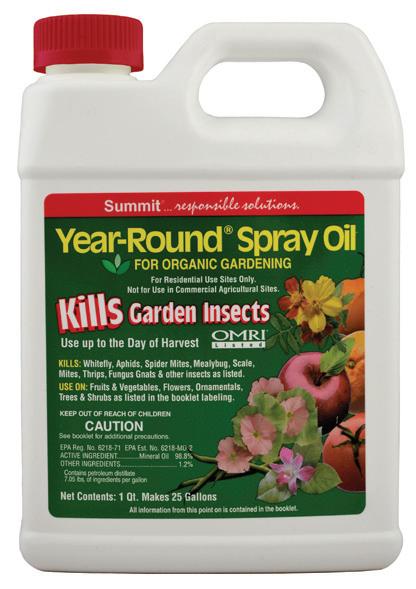











See #33 on page 89
Repair NitrogentheCycle in Your Garden
By Andy Wilcox
Something doesn’t look right in your garden. Maybe your plants don’t have that midsummer vibrancy and look a pale or even slightly yellow. Growth seems slow, and the plants seem weak and spindly instead of

bushy and vigorous. Older leaves keep dying and falling off.
All of these signs are possible symptoms of a lack of nitrogen. Easy, right? Grab the box of blue powder off the shelf, and mix up some instant problem-solving! Not so fast. That temporary fix isn’t doing the good it should.
20 MOTHER EARTH NEWS April/May 2023
Restore your soil’s ability to circulate nutrients by cultivating the intricate and fascinating networks between plants and microbes.
This article is available online in audio form at MotherEarthNews.com
Humans aren’t the only organisms that help plants grow, gather nutrients, and survive. Plants are quite capable of providing for their own needs and have developed intricate relationships with other organisms to do just that. Why do heavy feeders like melons and squash grow so well in a compost heap? Because those complex natural relationships of soil biology and plants are working.
The Dance of Sunlight, Water, Carbon, and Nitrogen
Envision a bright, warm, sunny day in midsummer. Your tomato plants bask in the sunlight. It rained overnight the lovely, gentle, slow dousing that gardeners like to see. In the garden, leaves stretch out to gather sunlight, harnessing its energy via chlorophyll. The stomata in their cells open and collect carbon dioxide. Water is moved up the xylem from the roots to the leaves. The chemical equation you learned in school now plays out in front of you, as carbon dioxide and water molecules are rearranged using solar energy. Sugars, which contain carbon, are created, and meanwhile the plant releases its oxygen “waste.”
You may have noticed that the above process didn’t appear to involve nitrogen, but it did. Nitrogen is behind the scenes of nearly every plant process, a component of the chlorophyll molecule, which is why a lack of nitrogen can appear in a plant as yellowing it’s unable to make enough chlorophyll. Nitrogen is also used in proteins, protoplasm (the clear goo inside the cells), enzymes, plant
hormones, and even DNA. Nitrogen is a part of all living cells. Without nitrogen, we wouldn’t have a plant.
Bacteria and archaea called “diazotrophs” create nitrate and ammonium from atmospheric nitrogen molecules. These organisms can break the triple bond of atmospheric nitrogen molecules and rearrange the nitrogen molecules in ways plants can use; the plants are then able to absorb nitrogen in the form of nitrate and ammonium. Without them, the nitrogen in the atmosphere would be unusable for plants.
Enter Bacteria and Fungi

Plants are pretty much immobile. They can only grow and gather nitrogen, water, and other nutrients where
it by exuding sugars from its roots. Microbes and fungi also break down organic matter in the soil and leave behind the nutrients they don’t need but plants do. In this way, the plant’s “reach” is significantly increased.
Soil organisms bring new nutrients to the rhizosphere (the area immediately surrounding the fine plant roots) to replace the nutrients already taken up by the plant. Thus, the cycle continues in this beneficial partnership between plants and the bacteria and fungi in the soil.
Nitrogen Storage and Availability
they are. If your tomato plants get up at night and go for a stroll, you have different problems. To some extent, plant roots can “search out” more water or nutrients. Roots can grow toward an area of higher moisture and away from a place of lower moisture via a process called “hydrotropism.” But there are limits.
This is where carbon and nitrogen become dance partners. Plants have developed symbiotic relationships (mutually beneficial processes) with bacteria and fungi. These bacteria and fungi like to eat carbon, so the plant provides

Nitrogen and other nutrients can leach out of the rhizosphere and out of reach of plant roots. Leaching occurs when water carries away water-soluble nitrogen (nitrate). These nutrients can also end up in our aquifers and surface waters, polluting them or causing algal blooms that deplete oxygen from the water. The dead zone in the Gulf of Mexico is an example of problems caused by leaching.
Nitrogen can be held, and therefore prevented from leaching, in several ways. Soil organic matter not only contains nitrogen itself, but also contains locations for nutrient ions to attach. Once attached to a particle, they’re not lost through leaching and are available for the plant or its symbiotic partners.
Because microorganisms are composed of living cells, they’re also stores of nitrogen. When the organism dies and
www.MotherearthNews.coM 21
Left: Healthy soil is teeming with microbes and fungi. Right: Nitrates leaching into waterways can lead to eutrophication and dead zones.
FROM TOP LEFT, CLOCKWISE: ADOBE STOCK/WILLIAM; ADOBE STOCK/BENNYTRAPP; OPPOSITE PAGE: ADOBE STOCK/LAST19
Nitrogen is a part of all living cells.
is decomposed by other microbes, that nitrogen is again available for use.
How Artificial Fertilizers Gum Up the Works
When we apply synthetic fertilizers, we attempt to “correct” a perceived nutrient deficiency. We’ve been taught by fertilizer companies that plants “need” regular applications of the stuff. But in most cases, the nutrients are there already, but the soil biology isn’t working. The bacteria and fungi, archaea and nematodes, earthworms and beetles all those good workers were unemployed, so they moved elsewhere looking for work.
A plant that’s given artificial fertilizer seems to thrive temporarily. It may look green and grow large, but it doesn’t develop the symbiotic relationships necessary to be healthy, resilient, and vigorous. It may get all the nitrogen it needs, but lacks other nutrients the living soil biology would’ve provided.
Curing the Wrong Problem
Artificial fertilizers disturb the natural nitrogen cycle in the soil. Often, too much is applied, and the excess is lost, leading to wasted money and harm to
the environment. Carbon exudates aren’t released, so nitrogen-fixing bacteria aren’t attracted to the rhizosphere. Plants that haven’t developed the needed symbiotic relationships are often lacking in the other critical micronutrients that contribute to their ability to resist disease, withstand drought, or even reproduce. They look
Restore the Nitrogen Cycle Stop Tilling
Rototilling smashes and bashes the soil. A freshly tilled bed looks loose and inviting, but tilling actually breaks down soil aggregates. Aggregates are groups of individual soil particles held together by bacterial slime (the beneficial kind), fungal hyphae, glomalin, and organic material. Aggregates allow water, air, nutrients, microbes, and larger creatures to move about in the ground. Tillage destroys those aggregates and causes pore space to be lost. It actually increases soil compaction and has little or no beneficial effect on established garden plots.
Potentially more harmful than compaction is the destruction of the soil microbe community and the soil food web feeding your plants. In healthy, living soil, organic matter is steadily decomposed and mixed with soil particles by beetles, worms, beneficial nematodes, archaea, bacteria, and fungi. The tiller upsets this process; breaks fungal hyphae; and kills many of your arthropods, worms, and nematodes.
But tilling kills all the weeds, right? Tilling may well kill or damage the current weed crop, but it also brings dormant annual weed seeds to the surface, where they become viable again and sprout by the thousands. Grass rhizomes are chopped up and stimulated to each grow a new plant. You’re creating more work for yourself with that tiller.
Increase Your Soil Organic Matter

green, but their health is in jeopardy.
For gardeners, food harvested from plants grown in fertile soil with high levels of soil organic matter and proper symbiotic relationships is more nutrient-dense than food from its artificially nourished counterparts. The produce tastes better, stores better, and contains more benefits, such as antioxidants.
Soil organic matter is magical. It’s composed of material that breaks down relatively quickly (say, a couple of years) and humus, which is resistant to decomposition and can last for decades or longer. Easily decomposed substances are broken down by the soil food web, providing nutrients for plant growth. Humus sticks around practically forever in garden terms and stores charged ions from minerals and nutrients, such as ammonium. Humus also holds water and helps create soil structure. It’s the jack-ofall-trades in soil health. Many of our agricultural soils in the United States have lost
22 MOTHER EARTH NEWS April/May 2023
Aggregates allow water, air, nutrients, microbes, and larger creatures to move about in the ground.
ADOBE STOCK/GOJALIA
Plants depend on a complex symbiotic relationship with soil microbes for essential nutrients.







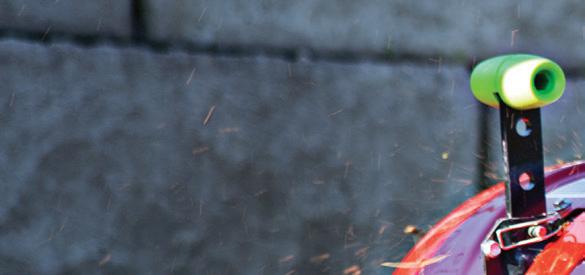






















































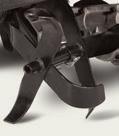

Earthquake-Print-Ad-7500x1000-123022a-ol.indd 1 12/30/22 11:30 AM See #4 on page 89
most of their soil organic matter. Soils that were 7% to 8% soil organic matter before the industrial age of agriculture are now less than 2% and sometimes less than 1%. Nutrient cycling, water storage, and soil biology have all suffered immensely.
Restoring soil organic matter levels may be the best way to improve your soil and increase your garden’s productivity, resilience, and beauty. Try these three methods for two growing seasons and watch the change.
1 Compost, compost, and more compost. Gardeners know compost is good stuff. Not only does it increase soil organic matter, but if it’s fresh and active, it can also supply all those active bacteria, fungi, and other microorganisms that create healthy, fertile soil full of nutrients.
2 Plant cover crops. A cover crop is planted to be left in place, not harvested and removed. Cover crops create soil organic matter and pump carbon into the soil to continue feeding the soil food web. Some even fix nitrogen for an added boost. You can plant a cover crop in any season when the ground isn’t frozen. Some common cover plants will winterkill for ease of spring planting, while others can be crimped or flattened. They also choke out annual weeds.
3 Use soil cover. Keeping your garden soil covered is critical to restoring, enhancing, and maintaining your soil’s health. An avid mulcher already knows how beneficial a mulch layer can be for plant growth, since the mulch retains soil


moisture and creates more soil organic matter as the layers break down. Even some problems, such as fungal wilts and some tomato diseases, can be reduced by mulch, which prevents soil from splashing onto the lower leaves. Keeping the ground covered reduces erosion, moderates the temperature, and prevents hard soil crusts from forming. Rarely in nature do we see bare, productive soil. Follow nature’s lead. Keep something there.
A Web of Life
Parking your tiller, working to increase soil organic matter, planting cover crops, and quitting artificial fertilizers may sound radical to some. However, these actions will do much to restore your soil food web. Your garden or field plot will
begin to cycle nitrogen all on its own. An army of a trillion helpers will work to restore your soil while you sleep, pick beans, read Mother Earth News, or take a vacation.
Our soil can be healed much more quickly than we used to think. Pick a few actions to try and start working toward a healthy soil food web. Once you do, you’ll never go back.

Andy Wilcox is a freelance writer and flower farmer, who’s passionate about gardening, horticulture, and forestry, and who believes healthy soil leads to healthy people. He can be reached at Andy@ThatGardenWriterGuy.com

24 MOTHER EARTH NEWS April/May 2023
Left: Cover crops, such as clover, help create organic soil matter. Right: Mulching can prevent soil erosion and retain moisture in the ground.
Composting your food waste is an excellent way to recycle nutrients back into the garden soil.
FROM TOP RIGHT, CLOCKWISE: ADOBE STOCK/HOPSALKA; ADOBE STOCK/SALARKO; ADOBE STOCK/ZHENYA
''My neighbors laughed wh en I ordered... now they ALL want a tomato garden like mine!''
Introducing a gardening planter that automatically grows your vegetables for you - simply, naturally and without any work. The Award-Winning GrowBox combines 45 years of USDA research and University field trials into a patented planter that makes sure your plants thrive - every time, year after year.
Look How Easily You'll
1 The P.atented Nutrient Grow Tomatoes PatchM cover releases

1 Just fill your GrowBox with comm?n potting mJX.
2 Lay the patented Nutrient Patcti" cover on the top and plant by the numbers.
3 Add water to the reservoir and ... Watch 'Em Grow!
Brown Thumb? It's EASY being green! Simple instructions show you when and what to plant. Then The GrowBox automatically adds the right amount of water and fertilizer for you. No guessing, no schedules, nothing to learn. Works perfectly - even for 1st timers.

Perfect for Patios and Decks
Great for busy homemakers, seniors and budget-minded people who want to save money on safe, clean produce. NEW Organic Fertilizer now available.
The EASY way to Garden You'l'e been Waiting For.
Enjoy a constantly producing garden anywhere you have sunlight. Pick FULLSIZE vegetables and salads daily for months - then simply re-plant year after year using the same soil.
premium fertilizer at the right time, properly spaces your plants and keeps the soil warm.
2 Uses simple potting mix for green-house quality results. No weeds or digging. You '11 never grow in the ground again!
3 Water constantly moves upwards to the roots. Stores 4 gallons for easy maintenance and it's impossible to over-water.
4 Just plant it and forget it! The indoor/outdoor GrowBox is portable, neat, easy to use and is re-usable for years and years.
"I own 5 o_f them and they're the greatest ...I am the envy o_f our neighborhood!"
Ruth M. Mother Earth News Magazine subscriber
Grows ALL plants with the same ease
Try Our GrowBoxes RISK-FREE This Spring
Order yours now and grow perfect tomatoes, peppers, 'cukes, salads and more. TAKE AN ENTIRE YEAR TO DECIDE that you love your new garden. If for ANY REASON, you're not completely satisfied, simply return them for a 100% refund - including your initial shipping.fee. You have nothing to lose with this no-risk offer. TRY 3 GROWBOXES'"THTS SEASON and say good- r=, r=, t bye to high produce costs. Your satisfaction is 100% guaranteed.
Toll-free (866) 947-5705 Visit our website for lots more information

www.a gard enpa tch .com

The GrowBox comes complete with planter, fertilizer,
Just add 32 quarts of potting mix and plants
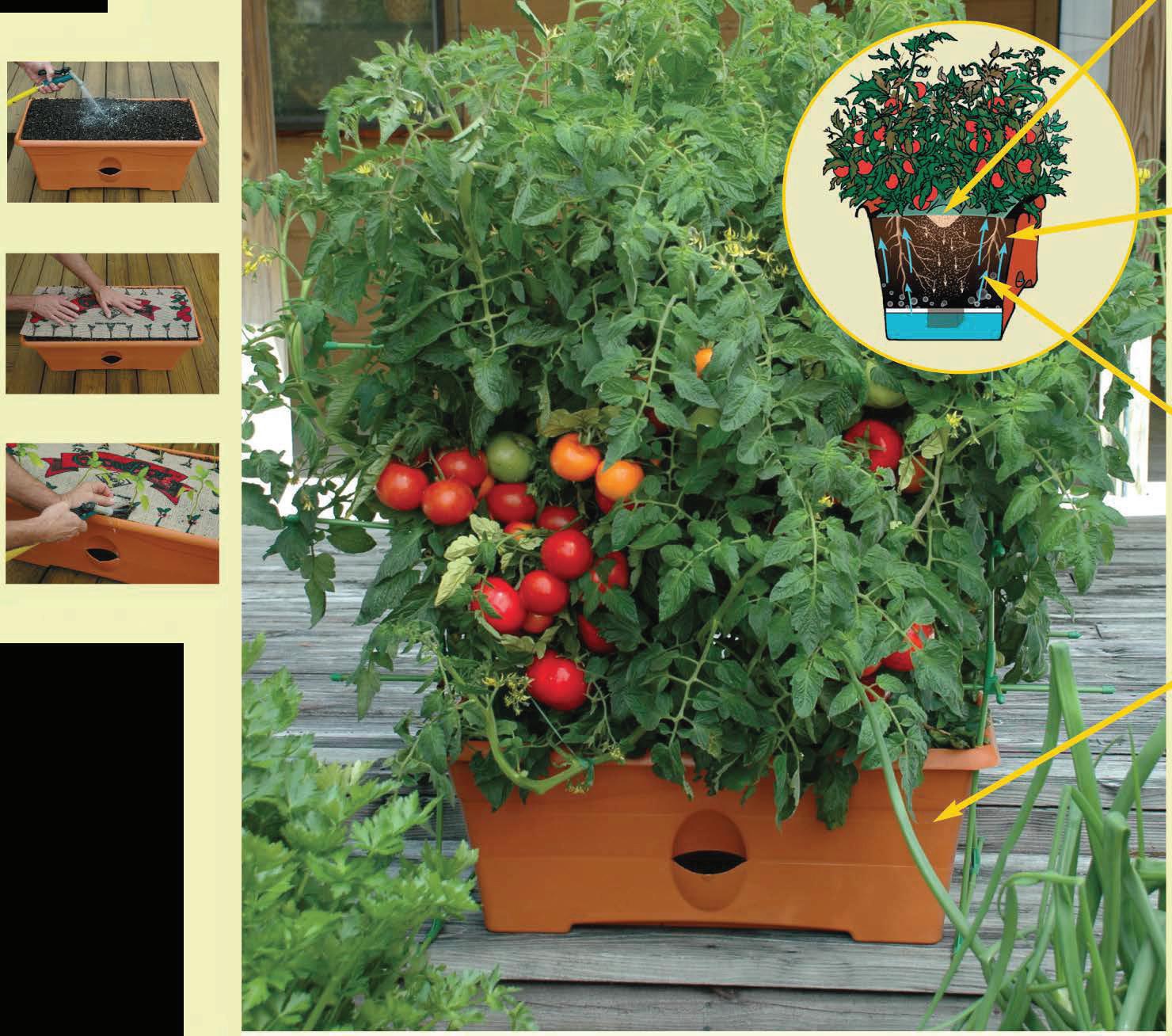
��
"Outstanding New Gardening Product �\,,- Awa rd for Ea se and Innovation"
L!J
L!J
•
•t■
cover,
instructions and a planting
simple
guide.
seeds. Measures 28" long , 14" wide and 12" tall. © 2022 The Garden Patch ™ Grow Box™ Key Code: 2MEN3CA
or
Suited to Solar
Go to the Pros
By John Moore
Some websites claim they can calculate how many solar panels you’ll need for your home or property, but switching to a solar electric system isn’t that simple. Before buying whatever equipment a website recommends, you should first assess whether your location can accommodate solar, gather data on your household’s electrical usage, and find a reputable certified installer.

My wife and I live in a rural area of East Texas, where wind and thunderstorms can easily knock out our electricity. Significant weather events have downed
the grid in our region for days. When we decided to install a solar electric system in 2014, we’d reached the age when dragging around a generator and cables was no longer feasible.
Soaring energy prices are the reason many people consider producing their own electricity. (See “Average Electricity Rates by State” on Page 28.) Others, like us, want to be prepared for outages. Regardless of your reason for installing a home power plant, be sure to choose a properly designed system that meets your needs, goals, and budget. A solar electric system is a significant investment and should last for decades.
Before you start pricing panels, conduct a home and land assessment to discover how well your location works for solar. Whether you plan on hiring someone or installing a system yourself, free online sites, such as Google’s Project Sunroof (Sunroof.WithGoogle.com), will give you a great overhead view of your home and property. Study your property from above to get a true picture of the available space for solar panels. Determine whether your property has enough open, unobstructed area facing south the direction offering the most access to the sun.
The latest software offered by reputable installers can give an almost perfect picture of how many panels you’ll need, where they should be placed to produce the most electricity, and what actions you should take on your property to maximize energy production. You can

26 MOTHER EARTH NEWS April/May 2023
Pondering whether you can generate enough power for your household needs? Here’s some advice for assessing your place’s place in the sun.
A dobe S tock / myphotob A nk com A u ; o ppo S ite p A ge , from top : A dobe S tock / no W r A photogr A phy ; J ohn m oore
do your own computations, but software designed specifically for solar installation is hard to beat. Although professional advice can be expensive, I’ve found it’s typically worth paying an expert for information. We’re glad we hired someone to ensure we bought the right panels and equipment and that our calculations were accurate.
Look for a solar contractor who’s local, thorough, and experienced. My wife and I also wanted someone who was certified in solar, so we used the professional directories offered on the website of the North American Board of Certified Energy Practitioners ( www.NABCEP. org ), a national solar installer network. I recommend having at least one certified person on your installation team.
We interviewed two local solar installers. One sold three packages from which customers could select either a small, medium, or large system. The company made no visits to our home nor offered any assessment of our usage. We chose the second installer because he met with us and evaluated everything about our home and land. He had 10 years of experience, guaranteed his work, and
was available for questions, repairs, and upgrades. His pre-assessment included examining one year’s worth of our electrical consumption, calculating how much sun we received from the southern sky, and recommending whether we needed to remove any trees to ensure we’d generate the amount of electricity we wanted.
Functional Facts and Figures
Even when you trust an installer’s recommendations, you should also do your own homework. Begin by assessing your electrical usage. A good starting point

can be arrived at by dividing your total billed kilowatthours (kWh) for one year by 12 to obtain your average monthly use.
The equipment that ties into your panels and operates your solar electric system should be selected based on whether you wish to be grid-tied (that is, your panels work in conjunction with the electrical grid maintained by utility companies); gridtied with battery backup; grid-tied with batteries and a generator; or completely off-grid. If you choose to go off-grid, the number of panels and batteries you’ll need will double (or more), and so will maintenance and costs. Also, paying for an experienced installer will be more critical, as your goals will become more complex.
We chose a grid-tied system with batteries and a generator because we wanted power in all situations. Since we opted to not rely on our panels to operate our HVAC system (which is powered separately), our installer was able to fit a battery backup system within our budget that kept the appliances, lights, computers, and other critical smaller loads running when needed.
 Professional installers will evaluate your home and land for solar.
The author’s 2014 solar electric system installation included 26 ground-mounted panels.
Professional installers will evaluate your home and land for solar.
The author’s 2014 solar electric system installation included 26 ground-mounted panels.
Our goal was to produce as much electricity as our household used.
If you’ll be installing your own solar electric system, you should approach panels and equipment the same way a professional would. Determine your southfacing access to the sun. Although you can install panels on any roof that faces due east or west, you’ll lose about 10% to 20% of your annual yield compared with south-facing panels.

Solar panels vary by quality and efficiency. Buy the most efficient panels
your budget allows. We chose the best available at the time 15% efficient, meaning that each panel converts 15% of the energy it receives from the sun into electricity. Today, the best panels on the market convert about 23%.
Average Electricity Rates by State
Also, consider durability. Most panels are built to withstand bad weather, including a degree of impact. Ours have survived hailstorms that our roofing shingles couldn’t. Our installer did all the design work to calculate what our available installation areas would bring us in kilowatt-hours. These calculations figured in our local weather, hours of peak sun in our city, and shade losses. Then, he divided the number of kilowatts by the performance of the panels we chose and how many hours a
Some states saw a huge jump in average electricity rates in the year preceding November 2022. These included New Hampshire (44.9%), Hawaii (26.4%), and Rhode Island (25.44%). Overall, rates per kilowatt-hour in the U.S. during this period increased by 11.16%. Few states decreased their rates. Here’s the list of U.S. states with the average price of electricity to residential customers by cents per kilowatt-hour in November 2022, the rate as of November 2021, and the percentage of change.
28 MOTHER EARTH NEWS April/May 2023
State Nov. 2022 Nov. 2021 Difference Alabama 14.96¢ 13.30¢ 12.48% Alaska 23.07¢ 22.56¢ 2.26% Arizona 13.11¢ 12.31¢ 0.5% Arkansas 12.20¢ 11.68¢ 4.45% California 26.14¢ 23.87¢ 9.51% Colorado 14.69¢ 13.77¢ 6.68% Connecticut 23.92¢ 21.40¢ 11.78% Delaware 16.22¢ 13.86¢ 17.03% District of Columbia 15.81¢ 14.07¢ 12.37% Florida 14.00¢ 12.49¢ 12.09% Georgia 13.51¢ 12.27¢ 10.11% Hawaii 43.91¢ 34.74¢ 26.4% Idaho 10.01¢ 10.19¢ -1.77% Illinois 17.27¢ 14.33¢ 20.52% Indiana 16.33¢ 14.27¢ 14.44% Iowa 12.49¢ 12.22¢ 2.21% Kansas 14.64¢ 13.37¢ 9.5% Kentucky 13.80¢ 12.49¢ 10.49% Louisiana 13.59¢ 11.66¢ 16.55% Maine 22.36¢ 18.19¢ 22.92% Maryland 15.42¢ 13.65¢ 12.97% Massachusetts 28.10¢ 23.33¢ 20.45% Michigan 17.72¢ 17.61¢ 0.62% Minnesota 14.05¢ 13.54¢ 3.77% Mississippi 13.62¢ 12.23¢ 11.37% Missouri 11.94¢ 10.92¢ 9.34% State Nov. 2022 Nov. 2021 Difference Montana 12.27¢ 11.38¢ 7.82% Nebraska 10.74¢ 10.83¢ -0.83% Nevada 15.27¢ 12.67¢ 20.52% New Hampshire 30.66¢ 21.16¢ 44.9% New Jersey 16.25¢ 16.13¢ 0.74% New Mexico 14.12¢ 13.52¢ 4.44% New York 23.66¢ 20.09¢ 17.77% North Carolina 12.32¢ 11.44¢ 7.69% North Dakota 10.57¢ 10.91¢ -3.12% Ohio 14.78¢ 13.06¢ 13.17% Oklahoma 12.46¢ 11.65¢ 6.95% Oregon 11.44¢ 11.43¢ 0.09% Pennsylvania 17.49¢ 14.13¢ 23.78% Rhode Island 28.65¢ 22.84¢ 25.44% South Carolina 14.32¢ 13.78¢ 3.92% South Dakota 12.05¢ 11.94¢ 0.92% Tennessee 12.94¢ 11.61¢ 11.46% Texas 14.82¢ 12.78¢ 15.96% Utah 10.68¢ 10.21¢ 4.6% Vermont 20.95¢ 20.13¢ 4.07% Virginia 14.48¢ 11.81¢ 22.61% Washington 10.32¢ 10.22¢ 0.98% West Virginia 13.84¢ 12.89¢ 7.37% Wisconsin 15.59¢ 14.70¢ 6.05% Wyoming 11.07¢ 10.93¢ 1.28% Source: www.VaultElectricity.com/average-electricity-price-by-state
A dobe S tock / chri S ti A n bitz AS
Study your property from above for a picture of available space for solar panels.
17-ft tall Tomato Plant - produced over 200-lbs of fruit. NO pestic ides were used, G MO-Free, NO added Chemicals

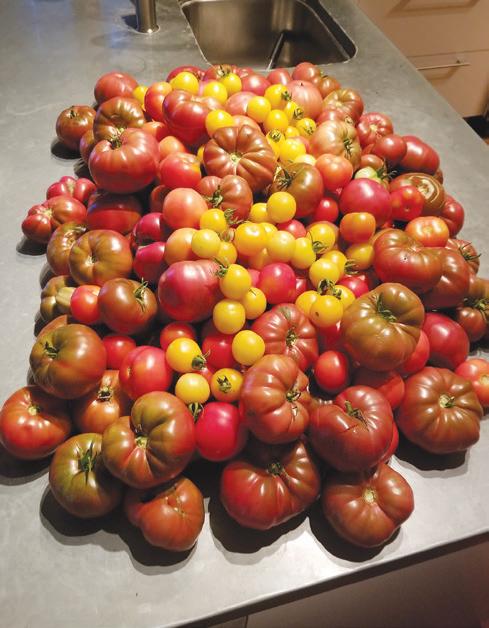

Prepare For Spring Planting & Use Dr. Jim Z in 2022!



Be More Successful In The Garden & Use Dr. JimZ in 2023!

B es t N a t u r al F e r t i li z e r O n E a r t h
$34.95











See #9 on page 89
Claiming the Federal Solar Tax Credit

The federal residential solar energy credit is a dollar-for-dollar reduction in the amount of federal income tax you’d otherwise owe, and it covers a percentage of the cost of a solar electric system you paid for.
Solar electric systems installed in 2020 and 2021 are eligible for a 26% tax credit. The credit increases to 30% for systems installed between 2022 and 2032.
You might be eligible for this tax credit if the solar system was installed at your residence in the United States; the installation was completed during the tax year; you own the system or you purchased
day he projected they’d generate power. Based on these figures, we needed just over 12 kilowatts, which could be generated by 50 solar panels.
The size of your system will depend on the average number of hours of sun you receive each day defined by where you live geographically and your goals and climate. A common misconception is that locations with long winters and short summers won’t

an interest in an off-site community solar project; and the solar system is new or being used for the first time. Eligible expenses include solar photovoltaic (PV) panels or PV cells; contractor labor costs; wiring, inverters, and mounting equipment; and energy-storage devices, among other things.

This information is summarized from the U.S. Department of Energy’s website. Visit www.Energy.gov for more details, including information on how the federal tax credit is affected by state tax credits and rebates from electric utilities and state governments.
support a solar panel system. Solar panels work fine in cold climates, but heat and cold do affect their efficiency. Extremely hot temperatures can impede productivity, so factor this into the equation.

We had room for 24 panels on the roof of our home, and we groundmounted the remaining 26 behind our house. Where you place your panels could be a matter of necessity or
of preference. Panels can be mounted on your roof or on the ground. The ground-mounted cost premium is only about 20%. The ease of snow removal from the ground mount and the ability to track the sun across the sky as its angle changes throughout the seasons may be important considerations if you live far from the equator.
Supply chain issues may affect which panels are currently available, so if you decide you only want solar panels from a specific company and in a specific quantity, you may have to wait and pay a bit extra.
Whether you install your panels or hire an installer to do it for you, buy the best equipment you can afford so you’ll enjoy the fruits of your solar labor for many years to come.

John Moore and his wife, Terry, live on a 10-acre homestead in East Texas. He’s a syndicated newspaper columnist and book author.
Install Your Own Solar Panels

Labor and related costs account for more than half the cost of the average home solar installation. But homeowners can save thousands of dollars with this user-friendly manual, which follows the same process used by professional contractors. Through detailed directions and step-by-step photos, veteran solar installer Joseph Burdick and seasoned builder Philip Schmidt will teach you how to determine the size, placement, and type of installation you’ll need. This comprehensive DIY guide covers everything from assembling rooftop racking to setting up the electrical connections to making a battery bank for off-grid systems. This title is available at Store.MotherEarthNews.com or by calling 800-234-3368. Mention promo code MMEPANZ5. Item #8284.

30 MOTHER EARTH NEWS April/May 2023
Check with your utility on net metering options that would allow you to sell surplus power to the grid. A dobe S tock /V ector M ine



SPECIAL OFFER: 1 @ $20 plus $9.85 (s&h) 3 @ $60 plus $14.15 (s&h) 5 @ $100 plus $18.45 (s&h) 10 @ $175 plus $27.00 (s&h) Yields a bountiful harvest of 10 – 20 gallons of blackberries per plant! To order by phone call 812-254-2654 Thomas E. Doyle “Blackberry Man” • Adapts to patios and small yards • Great for Commercial growers • One Doyle plant yields more than 20 ordinary plants! • Grows from Alaska to Florida – All 50 States & Canada Simple to order! Mail this completed form with method of payment to the address below: I’ve enclosed $__________ for #_____of bushes. Doyle Blackberry Inc. • 1600 Bedford Road • Washington, IN 47501 • Phone 812-254-2654 www.fruitsandberries.com • tomdoyle@fruitsandberries.com All Blackberry plants guaranteed for nineteen months. (last 3 digits on back of card) World Famous Doyle’s Thornless Blackberry® LARGE, SWEET, JUICY BERRIES — SO GOOD! Name: Phone: Address: City: State: _______ Zip: _________________________ Preferred Ship Date: _______________________________________________________________ Payment form: ❒ Check ❒ Money Order ❒ Cash ❒ Credit Card ( o a r ) Card #: Cards Expiration Date: Signature: FREE! Rose Doyle cookbook with order of 5 or more plants Now is your chance to own the Doyle’s Blackberry, discovered by our founder, Thomas “Blackberry Man” Doyle and perfected over the course of his lifetime. Blackberry plants have a 19 month guarantee. Doyles_MEN_DJ23.indd 1 10/18/22 8:42 AM See #8 on page 89 10% OFF GET USE COUPON CODE:MEN23
Big Burns
Setting a pasture ablaze might sound like a wild idea, but a controlled fire can boost nutritious spring grass while curtailing troublesome weeds.
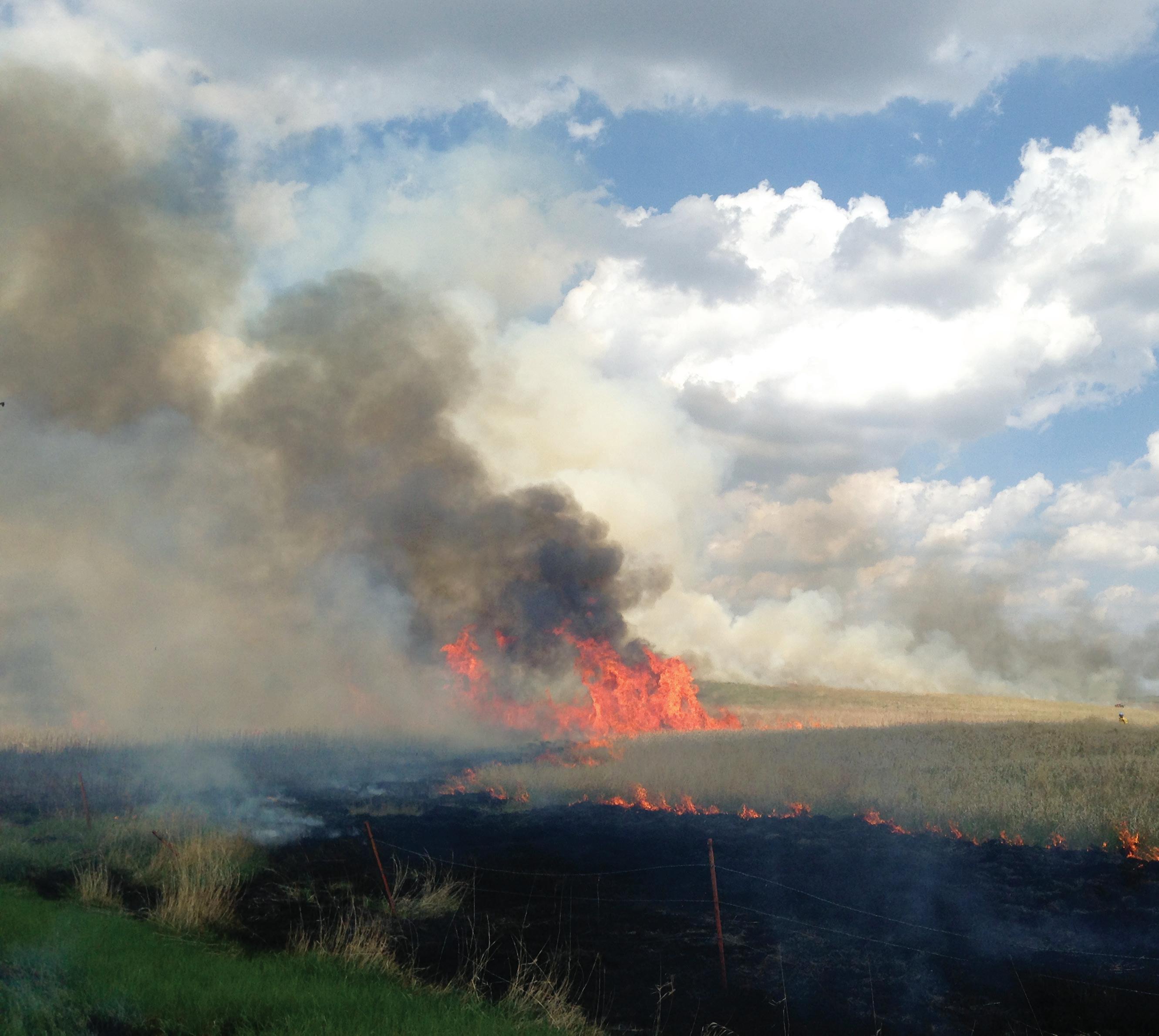 By Ashleigh Krispense
By Ashleigh Krispense
Tall bluestem grass sways gently in the breeze against a brilliantly blue sky as I watch local Kansas ranchers gather to plan the day’s controlled burn. Not a cloud is in sight as pickups and all-terrain vehicles loaded with water-filled spray tanks rumble down a dusty gravel road.
I overhear laughter and mild conversation as these graziers embrace the
32 MOTHER EARTH NEWS April/May 2023
F lickr /A my c o FF m A n /USFWS; P A ge 33: A dobe S tock / A len A 0509
camaraderie and teamwork awaiting them over the next few hours, but their discussion quickly turns serious as the schedule is laid out. If everything goes according to plan, the ranchers will work together with another nearby crew to burn a large acreage of grassland in a single day.
Lighting a tallgrass prairie on fire might seem contrary to common sense, because it’s almost like starting a wildfire. But if carefully planned, controlled fires are quite beneficial.
While there’s always an element of risk when setting an intentional fire, prescribed burning helps reduce the danger of wildfire by removing excess fuel in the form of dead grass and debris.
Benefits of Fire
About 82,000 acres of the world’s tallgrass prairie extend across Kansas and into north-central Oklahoma. The largest portion falls in the Flint Hills region of Kansas. Natural wildfires, and now prescribed burns, are essential to this ecosystem’s preservation. Grazing cattle prefer the fresh green grass that grows following a burn, and removing the previous season’s thick, dead thatch promotes nutritious new growth for livestock forage.
The deep roots of prairie grasses remain undamaged by the intense heat, while the fire removes parasites that may have overwintered in the dead grass. Fire can also destroy the seeds of noxious weeds and other unwanted plants, such as the invasive eastern red cedar on the Great Plains. An added benefit is the lowered risk of eye infection in the herd caused by scratching from tall blades of grass.
Burning Pasture Safely
Flint Hills rancher Todd Krispense shared with me the ins and outs of pasture management and burning practices. Not every patch of prairie needs to be burned every year, he pointed out.
Studies on the Great Plains have shown the optimal cycle to be every three years. Burning sections of prairie grass on a rotational schedule preserves habitat for native insects and the threatened greater prairie chicken, among other animals.
If you have a grassy pasture and want to practice prescribed burning, you should first evaluate the patch. Sufficient soil moisture is one factor to consider. Burning too early in spring can increase surface evaporation. Generally, the soil’s surface should be damp when you conduct a prescribed burn. Also, the soil below the surface should be moist to the depth of the grass roots, meaning you can squeeze excess water from a handful of soil. This is especially true for sandy soils. Also, consider the air’s relative humidity, and aim for a reading between 30% and 55%.
The timing of your pasture burn can affect the growth of different grasses; however, a long-term study conducted in the Flint Hills didn’t find any significant effect on grass production when burns were done in either fall, winter, or spring.

Perhaps most important for safe burning is to evaluate the wind on the day you plan to burn. The fire direction should always be against the wind and conducted in maximum wind speeds of 15 mph. Line up adequate help and plenty of water in spray tanks, and get the appropriate permit from authorities. Contact neighbors of the land you’re burning so they’re aware of your plans.

www.MotherearthNews.coM 33
Burning off the previous season’s thick, dead thatch helps promote the fresh growth cattle crave.
Before you strike the match, establish a fireguard around the perimeter of the burn area. Fireguards are obstructions that can be natural (such as a river) or human-made (pre-burned grass).
To create a fireguard, you can light a backfire along the downwind side of the pasture generally where you want the main fire to stop burning. This smaller patch of pre-burned ground will prevent the main fire from roaring into an adjacent pasture, as fires don’t respect fences or boundary lines, and you don’t want to destroy a neighbor’s property.
Decide on the best location for a backfire strip and then establish a water line, also known as a “wet line,” as a firebreak for stopping the backfire. To make a water line, spray water 1 to 3 feet wide, soaking the grass along the backfire strip on the side you don’t want the bigger fire to burn. Many ranchers do this with a spray tank on the back of a flatbed pickup truck. They spray the grass and then drive down the wet strip with a truck to compact the tall grass before lighting the water line on fire. The water line should be allowed to burn slowly
Managing Problems
Along with prescribed fires, other important factors in a successful pasture-management plan include controlling noxious and invasive weeds and trees, using appropriate stocking and grazing rates, taking proper care of fencing, and keeping a watchful eye for erosion.

Native grasslands are made up of a mixture of cool- and warm-season perennial grasses (such as big and little bluestem and gamagrass), legumes (alfalfa, clovers, and more), and forbs (flowering, broad-leafed plants). Burning doesn’t hurt perennial grasses, and it helps control invasive weeds and small trees.
Noxious weeds in native pastures vary by location. In many areas, musk thistle (Carduus nutans) and sericea (Lespedeza cuneata) are considered a problem and should be removed if found in a pasture. Other unwanted plants include staghorn sumac (Rhus typhina), buckbrush (Ceanothus cuneatus), and bull thistle (Cirsium vulgare). Untended trees, such as Osage orange (Maclura pomifera), honey locust (Gleditsia triacanthos), and eastern red cedar (Juniperus virginiana), can present a problem if left untended, but they’re usually controlled through a schedule of prescribed burns.
and thoroughly to avoid partially burnt stems that can give the fire a means to jump across the line.
Exercise caution, because fire can jump a water line. Station your helpers with spray tanks along the line, and make sure truck-mounted sprayers are available to stop the fire in case the wind changes direction. To lessen the risk, you can also mow a strip along one side of the water line to remove excess fuel but remain vigilant.
The Main Event
After the backfire is under control and has burned in the right direction a bit, you can light the main fire. A homemade device called a “fire stick” is the tool of choice in the Kansas Flint Hills. This is a length of steel pipe filled with gasoline and capped at both ends. The pipe’s working end is lit and dribbles fire as it’s pulled behind an ATV. When the ATV operator is ready to pause, they simply lift the stick in the air to stop the fuel from continuing to leak. No oxygen enters the closed system, so explosion isn’t a risk.
The main fire should be lit against the wind so the person lighting it won’t be caught in a corner. Continue to double back throughout the burn event to make sure no sparks or burning manure piles have blown into a patch of grass and flared up.
34 MOTHER EARTH NEWS April/May 2023
A shleigh K rispense ; p A ge 35, cloc K wise from top left : A dobe s toc K w AK r 10; A shleigh K rispense ; A dobe s toc K d A nit A d elimont
Ranchers on ATVs patrol a backfire started along the fence row.
A successful pasture burn is often an amazing sight to behold as huge billows of smoke form clouds in the sky. And when you appreciate the risks and understand the benefits, this sight can spark wonder instead of fear.

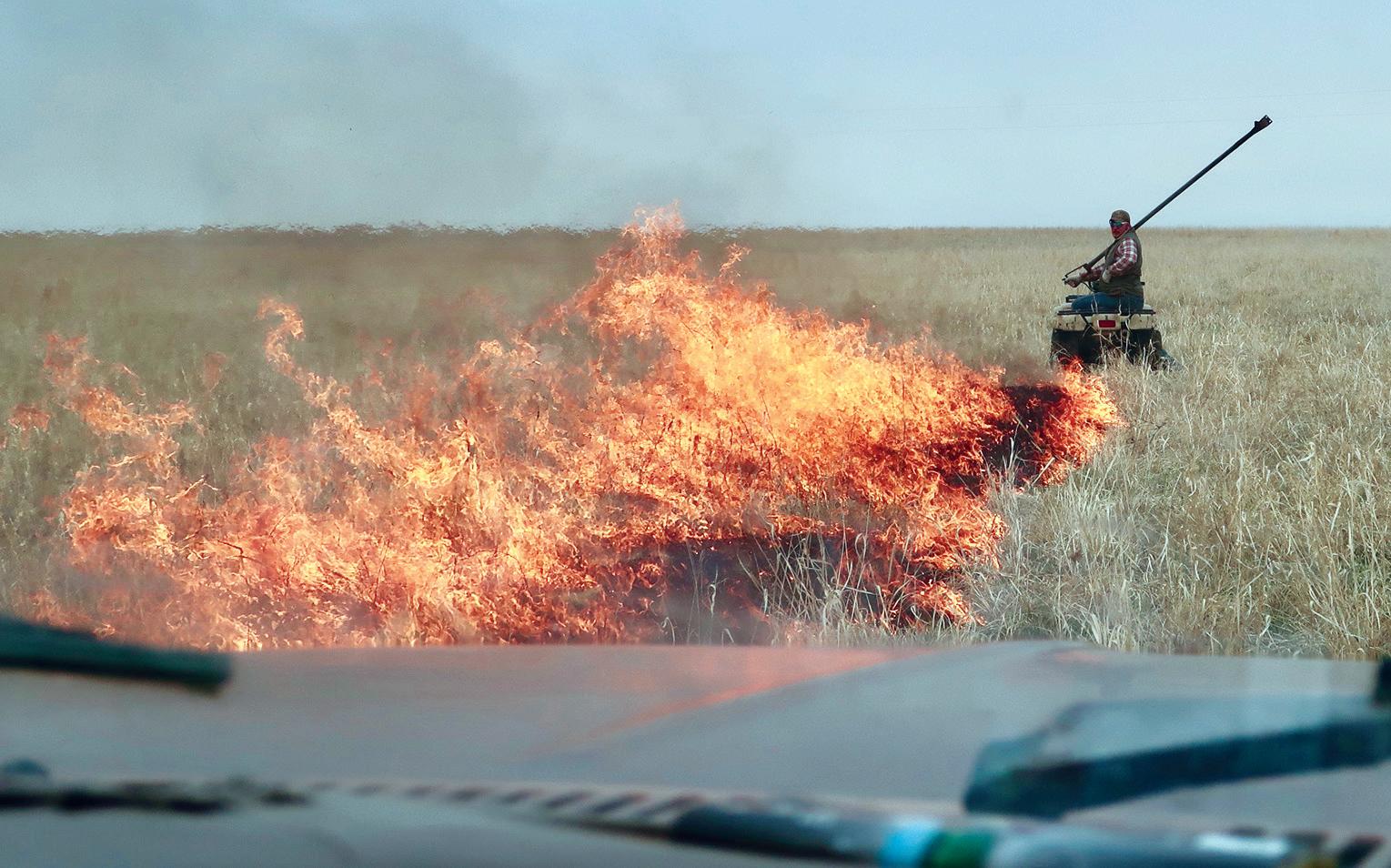

Ashleigh Krispense enjoys baking, gardening, and raising chickens with her husband on their central Kansas farm. Follow her at www.PrairieGalCookin.com

Fences Make Good Sense
A solid, dependable fence is essential when grazing stock on your pasture. Conduct a thorough check of all fences in each pasture at the beginning of the grazing season, and then continue to check on the fence and the electric fence charger, because repairs and battery replacement could be needed at any time.
A five-strand barbed-wire fence is most common in the Flint Hills, sometimes in combination with an electrified fence. Cattle tend to wear a path inside a fence, working the ground away from the posts and causing them to fall over. For this reason, some ranchers like to set up an electrified fence several feet inside the barbed wire to prevent their animals from walking next to it.
Erosion can sometimes occur around ponds and spillways. You can install a fence to keep cattle from grazing these areas bare.
Some ranchers burn their pastures at night, when humidity levels are highest.
From left: Be sure to notify neighbors before burning pasture. Grass is set ablaze with a fire stick, a capped pipe filled with gas and lit on one end.
Edible Blossoms to Spice Up Your Cooking


Look no further than your garden for these pretty pops of color and flavor.
 By Kami McBride
By Kami McBride
Edible flowers are becoming more popular, but the spicy ones aren’t as well-known, and they can add a revelatory amount of flavor to your meal.
Elegant with a touch of whimsy, a garnish of edible blossoms will elevate any dish. But will the flavor of the blooms live up to their visual appeal? For these six often-overlooked, spicy edible flowers, the answer is an enthusiastic yes. Far from the expected floral notes, their pep
will likely astonish anyone who hasn’t tasted them before. And best of all, these multitasking blossoms deliver a healthful surprise that rivals their flavor.
While many of the plants on this list will be familiar to gardeners, working with the blossoms instead of the leaves will bring a twist to your cooking. You can use edible flowers in salads, soups, and even on toast. A great way to start is by mixing the spicy flowers with butter, and you’ll find one of my tried-and-true recipes on Page 38.
Before we begin, there are a few things to know about edible blooms:
1 Not all flowers are edible. In fact, some are poisonous. Have a 100% accurate identification of the flowers you use. The blooms covered here are common in gardens, but when in doubt, consult someone with experience in plant identification.
2 Harvest from clean areas. If you’re wildcrafting, be aware of what’s nearby. For example, don’t harvest near roads, golf courses, or dog parks. Don’t use flowers from a bouquet or arrangement, unless you’re certain they haven’t been treated with pesticides. Practice responsible foraging: Harvest thoughtfully and leave the majority for others.
3 After harvesting, leave your flowers outside in the shade in a basket, colander, or plate for 30 minutes to give the insects time to crawl away. That way, there’s no need to wash the flowers.
4 Some flowers will keep for a day or two in the refrigerator, but I usually eat them the same day I harvest them.
Thyme
Flavor: Spicy and pungent. Some varieties may have a citrus flavor.
Use: Garnish just about any savory dish, soup, or stew. Sprinkle atop rice, millet, or quinoa for added flair. Thyme flowers are delicious in a flower-infused butter, and they can really enliven potatoes or your morning toast routine.
Identify and harvest: While there are hundreds of varieties of thyme and all are edible, you’ll have the most success with one that has relatively large flowers and even these will be small. Look for tiny white, pink, or purple flowers that bloom in spring and summer. Common thyme (Thymus vulgaris) is low-growing, reaching 6 to 12 inches in height, with tiny leaves that grow in clusters on square, often woody stems. Thyme releases a distinctive aroma when the leaves are brushed or crushed. To harvest, clip the flowering tops and remove the flowers from the stem.

Health benefits: Thyme is full of trace minerals, including iron, and is a wonderful carminative herb that enhances digestion by stimulating the movement of blood and oxygen to the digestive tract. It’s a warming and drying herb, and in higher doses, it offers support for ailments associated with the lungs and throat, speeding recovery from sore throats, sinus infections, and bronchial infections.
Nasturtium
Flavor: Spicy, piquant flavor that leaves a hot, biting aftertaste.
Use: These bright blossoms are a vibrant, peppery garnish for any savory dish or salad. Put whole nasturtium flowers on a sandwich as you would lettuce or pickles. For an appetizer or side dish, stuff the largest flowers with quinoa pilaf, tabbouleh, or tuna salad. These can also be eaten as finger food.
Identify and harvest: All varieties of nasturtium (Tropaeolum majus) are edible. Look for shield-shaped, almost circular leaves with white, spoke-like veins and orange, yellow, or red flowers with five petals. Gently harvest the flowers with scissors when they’re first budding or fully opened.

Health benefits: The flowers are a good source of vitamin C, calcium, copper, iron, magnesium, phosphorus, potassium, and zinc.
Society Garlic
Flavor: Pungent with a kick, and often compared to garlic.
Use: Add society garlic flowers to any food in which you’d add raw onions. Try mixing society garlic flowers with golden mustard flowers to garnish a green salad. Society garlic adds a delicious kick to sandwiches, wraps, spring rolls, and kale salads. I love to snack on them while working in the garden.
Identify and harvest: Society garlic (Tulbaghia violacea) is in the same family as garlic and onions, Amaryllidaceae, though not in the same genus. Growing about a foot tall, society garlic is often planted as a border or ground cover. Look for a starburst bloom with six
www.MotherearthNews.coM 37
FROM TOP LEFT, CLOCKWISE: ADOBE STOCK/EMILIO100; KAMI MCBRIDE; OPPOSITE PAGE: KAMI MCBRIDE
Left: Look for relatively large flowers when selecting thyme blossoms. Right: Nasturtiums bring a bright, peppery flavor to any savory dish or salad.
Flower-Infused Butter
An infused butter is a wonderful way to start using spicy edible flowers in food. The flavors of the flowers work well with many of the foods we love to eat with butter, from toast to root vegetables. And people are much more willing to try something new when it involves butter.
If you want an even easier start, simply mix thyme flowers into softened butter. Make what you think you’ll eat in one day, adjusting the ratios in the recipe. I like to use this butter up in a couple of days. The water in the fresh herbs tends to make the butter go rancid if it sits around.
1 Let the butter soften.
2 Add all ingredients to the butter and mix well.
Ingredients
• 1 stick butter
• 1⁄4 cup minced thyme flowers
• 1⁄4 cup minced red onion
• 2 tablespoons minced fresh rosemary
• 1⁄4 teaspoon black pepper
points from midsummer to fall. The flowers are typically purple, though some varieties may produce white or pink flowers. Harvest the flowers with scissors.

Health benefits: Society garlic contains the same general constituents as garlic. Adding them to your diet can help maintain good health and protect against colds and flu. Early research suggests society garlic may reduce the risk of blood clots, and that a compound in society garlic, methyl alpha-D-glucopyranoside, may help protect against cancer.
Wild Mustard
Flavor: A spicy zip similar to fresh arugula or mustard seed.
Use: Mustard flowers are an excellent garnish for savory breads, cornbread, any kind of potato dish, or creamed soup. Cut all the flowers away from the stem and sprinkle the yellow flowers all over the dish, so each bite has a little pep to it.


Identify and harvest: Often considered a weed, wild mustard (Sinapis arvensi s) is actually a brassica. The leaves are oval-shaped with irregular lobes. Wild mustard blooms in spring, and new plants may sprout and bloom in fall. Look for small blossoms with four yellow petals in a cross shape. The flowers grow in clusters at the ends of the stem, resembling broccoli in the budding and flowering phases. Snip or pluck in bunches from the tops of the plants.
Health benefits: This hardy plant might not be a welcome sight to all
38 MOTHER EARTH NEWS April/May 2023
Left: Society garlic flowers are distinctly starburst-shaped. Right: Wild mustard flowers offer a pop of color to bread and soup dishes. FROM TOP LEFT, CLOCKWISE: ADOBE STOCK/WIERT; ADOBE STOCK/HANSTOGRAPHY; KAMI MCBRIDE
gardeners, but it has benefits similar to other brassicas. It’s a good source of antioxidants, vitamins A and E, calcium, iron, magnesium, potassium, zinc, selenium, and manganese. Antioxidants may help reduce systemic inflammation in the body. Spicy mustard flowers also help clear the sinuses and lungs.
Wild Radish

Flavor: Spicy and pungent, with a peppery bite like the raw radish root.
Use: Invigorate your salad with freshly picked wild radish flowers. Elevate brunch by sprinkling the blossoms atop an egg dish, or garnish a rice dish for dinner. Wild radish blooms are a great candidate for a flower-infused butter.
Identify and harvest: Wild radish ( Raphanus raphanistrum ) is another brassica with large, lobed leaves and petals that form a cross or an “X.” Look for paper-thin flowers in hues from white to pink or purple, and any shade in between. The blossoms are delicate and don’t really last more than a day once picked. Wild radish is considered an invasive weed in some places; check with
your state’s agricultural extension office before planting.
Health benefits: Wild radish blossoms may help improve digestion. Like other brassicas, wild radish is rich in nutrients: calcium, vitamin C, potassium, magnesium, and beta-carotene.

Common Oregano
Flavor: Hot and spicy. Just a few of these small flowers will add a zing to any dish.
Use: Use common oregano flowers to garnish any dish that calls for oregano. They’re great with savory soups and salads, hummus, or atop a burger. Mix 2 tablespoons of fresh oregano flowers into a stick of softened butter, and use it on corn or bread, to top steamed vegetables, or as a base for sautéing onions.
Identify and harvest: Like other herbs in the mint family, common oregano ( Origanum vulgare ) has a square stem and distinct aroma. The leaves are small and ovate, and the small blossoms range from white to pink or purple. Look for these blooms from midsummer through fall.

Health benefits: This joyful and tenacious herb has carminative properties that enhance digestion and nutrient absorption. It also nourishes the central nervous system. Similar to society garlic, adding oregano and its flowers to meals regularly may help the body keep infections at bay.
Flower Power
Spicy edible flowers are a delightful, easy way to add interest to a dish. When we work with them, not only do we upgrade a meal’s flavor, but we also boost the health of loved ones and ourselves. Enjoy your nibbling, and my hope is that your meals will be topped with more spicy edible flowers!
Kami McBride is an herbalist whose courses and bestselling book The Herbal Kitchen have helped thousands of people learn how to use common kitchen herbs and spices in delightful ways. Connect with Kami at www.KamiMcBride.com or on social media @KamiMcBride.

250-Plus Recipes Empowering You to Take Control of Your Health
Herbs are a gift from nature. They not only help create aromatic and delicious food, they also support overall health and wellness on a daily basis. The Herbal Kitchen will help you recognize the extraordinary pharmacy that probably already exists in your own kitchen. With 50 easy-to-find herbs and spices; information and tips for preparing, storing, and using them; and over 250 simple, flavorful recipes, this book will empower you to care for your health. Whether you’re already familiar with herbs or are just starting out on the herbal path, Kami McBride offers recipes for everyone. Mix up refreshing drinks; infuse oil, vinegar, and honey; and learn how to make tinctures and cordials, salts, sprinkles, and more. This title is available at Store.MotherEarthNews.com or by calling 800-234-3368. Mention promo code MMEPANZ5. Item #11343.
www.MotherearthNews.coM 39
FROM
Left: Wild radish flowers go beautifully in salads or in herb-infused butter. Right: Oregano flowers can garnish any dish that calls for the herb.
TOP LEFT: ADOBE STOCK/DIANE N. ENNIS; ADOBE STOCK/DACHUX21

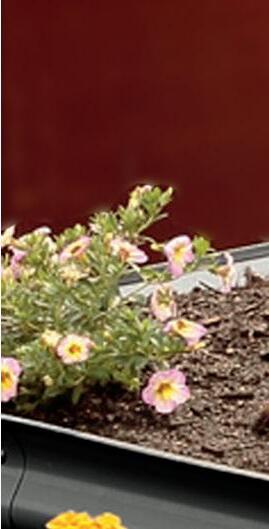

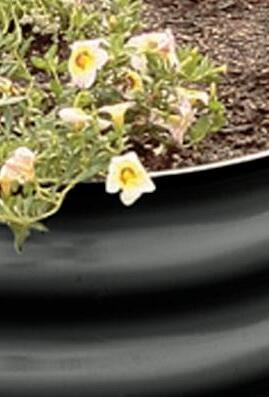


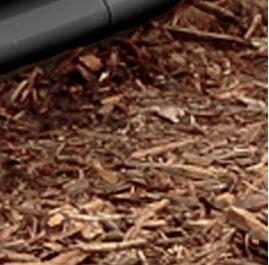






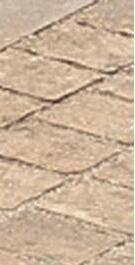









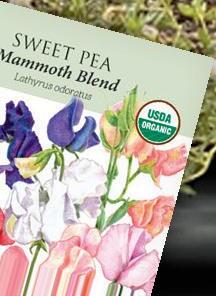








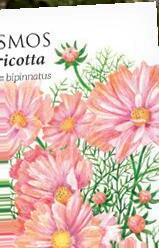

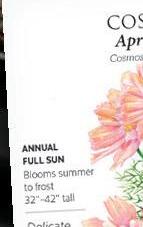


































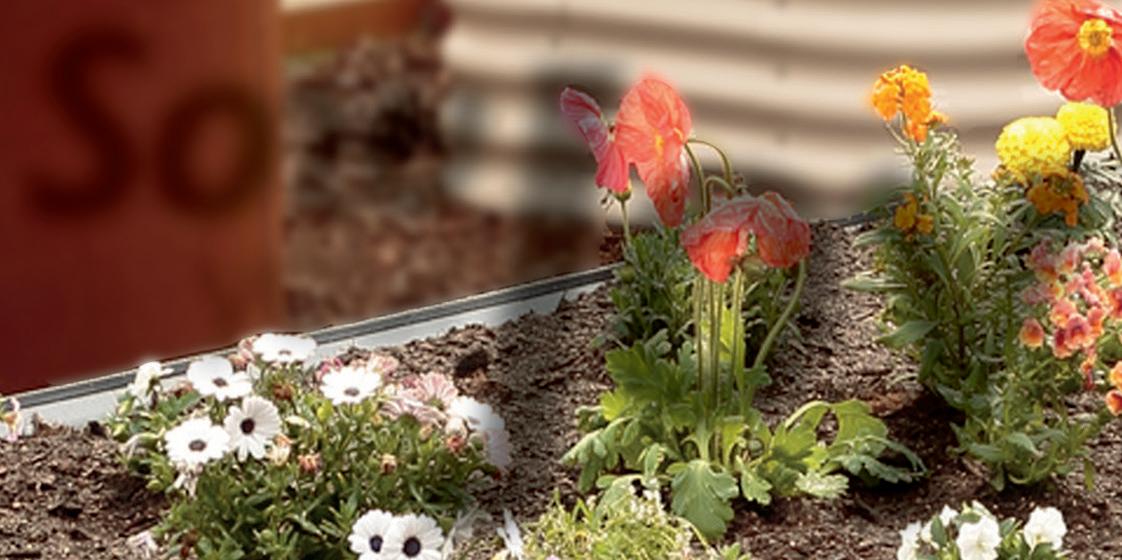








Shop over 650+ non-GMO seed varieties in your local store or online at botanicalinterests.com. Get FREE SHIPPING on your next order over $50* Use promo code: MOEFS EW ARRIVALS Birdies Raised Metal Beds SowJoy your *Free standard shipping on online orders $50+, excludes HI & AK. Offer expires 5/31/2023. This offer may not be used with other offers. See #21 on page 89 See #6 on page 89
Wild Baby Birds How to Help
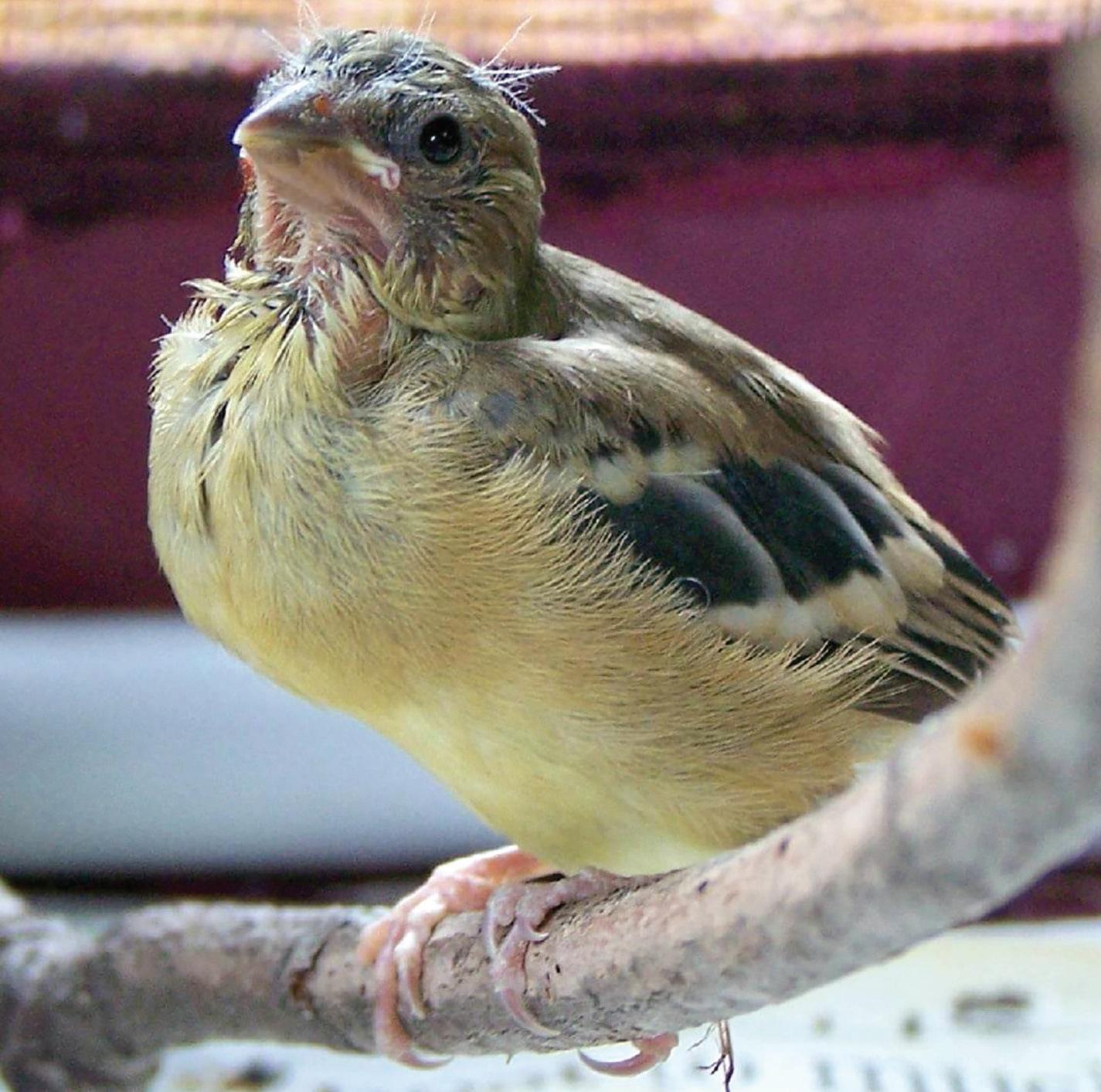 By Linda Bowen
By Linda Bowen
Finding a baby bird or wild bird egg seems to bring out the parental instincts in many people. People often use anthropomorphism to understand the natural world. Anthropomorphism is the human tendency to project human characteristics and thinking onto animals or other nonhuman beings. In other words, when people see a lone baby bird in the wild, they may think of it as just as helpless and abandoned as a human infant would be in that situation, and thus feel an overwhelming urge to “save” it.
Wild Birds and the Law
Most wild birds are protected by the Migratory Bird Treaty Act of 1918. This means no one should be in possession of wild birds, including their eggs, feathers, skins, bones, and nests, unless they’re bringing an orphaned or injured bird to a wildlife rehabilitator for care. This doesn’t include hunters, who must comply with other laws and permits for possessing certain animals, dead or alive.
If the animal lives in the wild, it’s generally considered wildlife, regardless of whether it’s invasive or native. If a bird isn’t protected by the Migratory Bird Treaty Act for example, invasive species, such as house sparrows, mute swans, and starlings then the bird and anything related to it aren’t restricted from handling or possessing unless that state has laws regarding a particular species. Some states may have a generalized law that “no one shall be in possession of any wildlife,” which usually includes eggs, feathers, skins, bones, and nests. Each state may have different laws and interpretations.
Avian Life Stages
To understand a lot of what’s occurring in the bird world around us, it helps to know basic avian biology. At hatching, there are two types of birds: precocial and altricial.
When precocial birds are hatched, they’re up and walking around within a very short period, often 24 hours. They’ll start pecking at the ground for food and they’ll be fully covered with down. These birds tend to nest on or close to the ground. Examples of precocial birds include wild turkeys, ducks, geese, quail, and killdeer.
Precocial birds are sometimes found alone, because of separation from their parents or flock. These birds can find food and feed themselves, but they haven’t yet fully learned the art of predator avoidance. Separation from the flock or parents often happens at road crossings or when a predator chases the birds. The birds scatter but then don’t always manage to find each other once the threat has passed. In many cases, the flock or parents are nearby,
www.MotherearthNews.coM 41
With a little knowledge of bird biology, you’ll be prepared if you encounter a wild bird egg or baby bird this spring.
CONNIE BLACK This article is available online in audio form at MotherEarthNews.com
Baby birds require specialist care to ensure they’re receiving the appropriate diet.
so give the orphan bird a chance to reunite with them. These young tend to remain quiet when a human is nearby, but if given space, it’ll call loudly in hopes of being found by its parents or flock.
Conversely, altricial birds hatch helpless, usually naked, and are dependent on their parents for survival. These species usually nest a few to several feet above the ground so most land predators can’t get to them. Some of the more commonly seen altricial birds in the U.S. are the American robin, the black-capped chickadee, and several sparrow and finch species.
Altricial birds go through a series of growth stages, starting with the “hatchling” stage, which immediately follows the hatch and may last 1 to 3 days. During this time, the parents may not feed their young, since the chicks are still receiving nutrition from the yolk sac inside them. This gives the hatchlings time to build up strength to be able to sit up and beg for food. Once the hatchlings begin to be fed by the parents, it’s known as a “nestling.” This stage can last for a few to several days, depending on the species.
Knowing when a bird has moved from the nestling stage to the fledgling stage is a bit more complicated. Not all birds in a nest will fledge at the same time, nor is it clear if they belong in the nest or on the ground. When they fledge from the nest, which can be as simple as merely jumping out of the nest onto the ground, they’re still dependent on their parents for food and protection. They’re usually not ready to fly but are quite adept at hopping and jumping. Some species may be able to flap their wings and jump into a low bush, but the parents are always nearby, keeping watch. At this stage, the parents may be looking out for 4 to 6 fledglings, each of which has gone in a different direction. The parents rotate between each of their offspring and are aware of where each fledgling is.
This is often the time when observers find the bird and feel the need to “rescue” it. The observer doesn’t see the parent fly away; they just see that the bird doesn’t have adult plumage and, most of all, that there’s no parent nearby. Rather than picking the bird up, step a good distance
away, around 40 to 50 feet from the area, and give the parents enough time and space to come down and feed the fledgling.
The Risks of Misinformation
The nestlings are extremely difficult to tell apart, so if the rescuer makes an identification, it may be the wrong one, leading to incorrect care and food. Many altricial bird parents feed their young carefully chosen insects, even though the adult diet may be much more diverse. Some avian species feed predigested and regurgitated seeds to their young. Adult birds may have completely different diets than their young, and feeding those adult foods to a young bird would likely mean disaster.
Misinformation online about appropriate food for young birds runs the gamut from milk-soaked bread to applesauce, cat and dog food, and everything in between. No young bird will survive to live a healthy life with these diets, even if only fed that way for a day or two.
Resources for Finding Wildlife Rehabilitators

Animal Help Now: www.AHNow.org
National Wildlife Rehabilitators
Association: www.NWRAWildlife.org
In most cases, the damage isn’t reversible, and the bird will quickly die or will be euthanized because of deformities caused by the inappropriate diet. While an adult black-capped chickadee might be able to eat sunflower seeds, that doesn’t mean those seeds will provide adequate nutrition for their young.
Finding Wild Bird Eggs
Imagine someone has found an egg on the ground and no nest is visible in the area. The three most important features of making a correct identification of an egg are the egg’s physical details (size, color, and shape); which materials the nest is made of; and where the nest is located. If the egg isn’t in or near the nest, then two of the three features used to identify the egg aren’t there. Eggs from smaller species of birds are often quite similar, which can make correctly identifying them extremely difficult, if not impossible.
Hatching the egg is against the Migratory Bird Treaty Act. If the egg wasn’t viable to start, the parents may have discarded it to conserve resources. Some rehabilitators

42 MOTHER EARTH NEWS April/May 2023
If you find any wild bird eggs, leave them alone.
FROM
Contact a rehabilitator before rescuing a wild baby bird.
TOP: ADOBE STOCK/KONSTANTANT; CONNIE BLACK
Dangerous Stress Bars

Untrained rescuers fed an inappropriate diet to a rock dove, causing stress bars to develop on its wings and tail. Birds grow quickly, and feathers become a diary of what’s happened in a young bird’s life. The tips of this bird’s feathers show that initially, the bird was receiving proper nutrition from its parents in the wild and its feathers were forming normally. The stress bars appeared after it was fed an inadequate diet, probably for a handful of days. After that, more normal growth is seen from when the bird was brought to licensed rehabilitators, who fed it an appropriate diet. The stress bars appear as deformities across the feather shafts, and they’ll likely cause the feathers to break off, rendering the bird mostly flightless and susceptible to predator attacks. This bird won’t be able to grow new feathers until all the damaged feathers are molted out, a process that can take several months.

Note the smooth and well-formed feathers of this leucistic (anomaly) acorn woodpecker. The well-groomed and precisely aligned feathers allow this bird to perform many of the aerial feats necessary for survival. Such feathers are the result of an appropriate diet.
or wildlife centers may choose to incubate wild bird eggs, but the hatch rate for songbird eggs can be quite low, and the rehabilitator’s resources are few. Furthermore, caring for the tiny hatchlings is difficult at best. As a result, many rehabilitators don’t accept wild bird eggs.
Tragic outcomes occur when people illegally incubate and hatch wild bird eggs. Imprinting occurs during the first 24 hours after a bird emerges from its egg. Imprinting is how the newly hatched bird learns to identify what it is as a species. This is different from habituating, which is generally food-related and develops when animals become accustomed to humans providing food. In far too many cases, habituated animals end up being tormented or killed because they approach a human looking for food and their behavior is interpreted as aggressive and dangerous.
Imprinting is just as deadly, since the hatchlings that imprint on people have a mental image of a human as their identity and as what they’ll look for when joining a flock and selecting a mate. Once imprinting takes place, it can’t be undone, whereas a habituated animal can sometimes be “wilded up,” which takes a long time and isn’t easy to do.
Helping Wild Birds
No matter how well-intentioned, untrained people won’t be able to give a rescued bird the species-appropriate care it needs. Please don’t attempt it: It’s illegal and most likely to end in tragedy. Instead, contact a licensed rehabilitator who works with the species you’ve rescued. A general category of songbird, waterfowl, or raptor will be sufficient for your initial inquiry. Not sure if a bird needs rescue? Before you pick it up, take some pictures and contact a licensed rehabilitator to find out if it really does. Each state will usually have a webpage with contact information for specially trained and licensed wildlife rehabilitators.
Above: Stress bars indicate that this rock dove has received poor nutrition. Below: The healthy feathers of this leucistic woodpecker enable it to take flight.

Caring for wild birds is much more complicated than many realize. Wildlife rehabilitators must be licensed in their state, and if they work with migratory birds, they must also have a rehabilitation permit from the U.S. Fish and Wildlife Service. These dedicated volunteers are required to study for many hours and sometimes years before they can become licensed to care for our wildlife.
Linda Bowen is a wildlife rehabilitator licensed by the Connecticut Department of Energy and Environmental Protection, specializing in bats. She’s also licensed by the U.S. Fish and Wildlife Service to rehabilitate migratory birds, specializing in waterfowl, particularly wood ducklings and other difficult-to-care-for species. She has published articles in state and national rehabilitation journals and has lectured at wildlife conferences across North America.
www.MotherearthNews.coM 43
FROM TOP: KATHLEEN ST.
CLAIR MCGEE; ELLIE DELGADO
Dead-Tree Delicacies
By Bruce Ingram
Recipes by Elaine Ingram
“Stop the car, stop the car!” I shouted as my friend Jamie Gold and I were returning from a fishing trip in the Virginia mountains.
“What is it, did I hit something?” Jamie asked. As he hit the brakes, I bolted from the vehicle.
“There’s a chicken of the woods on that tree,” I said.
“What’s a chicken doing in the woods?”
My friend’s confusion was understandable. But if you’re a fan of edible fungi, then you can understand my euphoria at glimpsing what many people including my wife, Elaine, and me consider the best-tasting wild mushroom. Chicken of the woods is classified as a polypore, which, as a group, tend to grow on dead
Explore mushroom foraging by getting to know these edible favorites.
or dying trees or over underground wood, especially hardwoods such as white and red oaks, ashes, and maples. Another tasty polypore is hen of the woods. And, although they aren’t polypores, other edible varieties exist that are likewise saprobic ( just like most polypores), meaning they break down dead or dying organic matter to make energy and meals for those of us who are gatherers. Here’s a closer look at seven of these edible fungi.

44 MOTHER EARTH NEWS April/May 2023
A dobe S tock /M A k S y M ; o ppo S ite : b ruce i ngr AM (4)
Chicken of the Woods (Laetiporus sulphureus)
Chicken of the woods not only tastes sublime, but it’s also a spectacularly beautiful mushroom, with bright yellowishorange hues, a fan-shaped appearance, and wavy edges. They frequently grow up to a foot wide or so, but most of the ones Elaine and I have found have been 7 to 8 inches across.
My earlier anecdote took place over Memorial Day weekend, which is the soonest I’ve found chickens. Gatherers are most likely to encounter them during summer months, though I’ve come across them early in November. This species does taste something like chicken and remains “meaty” after stir-frying. (It may cause swelling for some people, so try a small amount at first.) Chickens are widespread, appearing from Canada to
Florida, across the Midwest, and from Washington state to California.
Cauliflower Mushrooms (Sparassis spp.)
If you spot from a distance what looks like a cauliflower in size, shape, and color growing on or nearby the base of a tree, chances are you’ve found a cauliflower mushroom. Two species of this mushroom exist in America: the Eastern cauliflower (S. spathulata), which, true to its name, grows in the East; and the rooting cauliflower (S. radicata), which thrives west of the Rockies. A member of the coral fungus family, these white mushrooms have flat, leaf-like “branches” that close up look nothing like the rounded lobes of the namesake vegetable. A cauliflower mushroom often weighs several pounds, so discovering one can lead to many meals.

I’ve found the Eastern cauliflower from July through September, and the rooting cauliflower’s season is September through November. The former tends to grow best in open hardwood stands composed mostly of oaks; the latter associates with conifers. We especially like cauliflowers in soup and egg dishes because of their firm, meaty texture.
Beefsteak Polypore (Fistulina hepatica)

If you encounter a 6-to-10-inch-wide mushroom that looks like someone jammed a fan-shaped slab of red meat into the side of an oak or other hardwood, then you’ve likely located beefsteak polypore. Most all wild mushrooms should be cooked before eating so gastrointestinal issues won’t occur, but this is the only mushroom covered here that can be

Rules for Foraging
Most wild mushrooms aren’t edible or toxic; they’re just too tough, slimy, or poor-tasting to consume. But making a mistake on identifying a mushroom can lead to a trip to the hospital or worse. Here are some rules for gathering.
• The first few times you search for mushrooms, go with an expert who can positively identify various species.

• Never consume a new-to-you mushroom until an expert has positively identified it.
• Even choice edible mushrooms can cause gastrointestinal problems for some people. Eat small amounts at first.
• Buy and study mushroom field guides. My two favorites are National Audubon Society Field Guide to North American Mushrooms and Appalachian Mushrooms: A Field Guide by Walter E. Sturgeon.
www.MotherearthNews.coM 45
• Join local mushroom clubs to learn from mushroom enthusiasts near you.
From left: Some wild mushrooms the authors have gathered include chicken of the woods, cauliflower mushroom, and beefsteak polypore.
Elaine gathers a choice cauliflower mushroom.
Wild Turkey Breast with Wild Mushroom-Dill Sauce
This recipe combines two of our favorite foods: the breast of a wild turkey and wild mushrooms. Domestic turkey and chicken can be substituted for a wild bird. Yield: 4 servings.
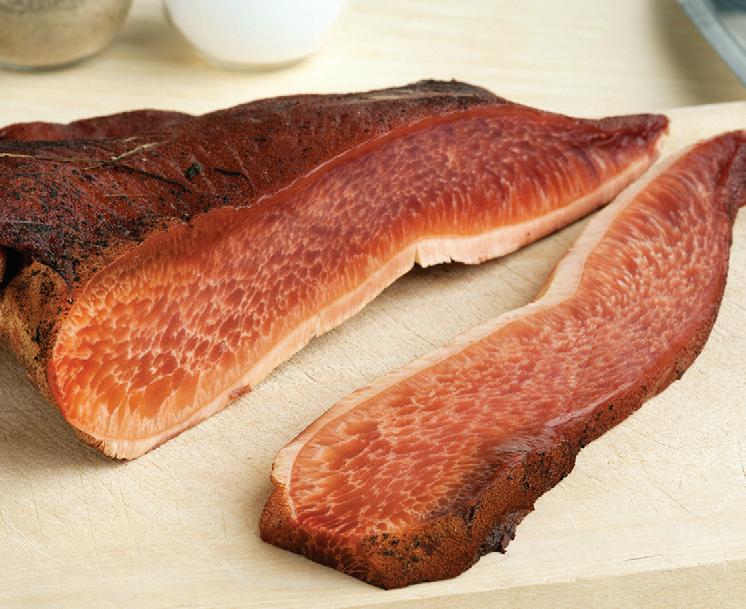

1 Slice turkey breast into pieces and place in a shallow dish. Cover with buttermilk (buttermilk enzymes will help tenderize breast). Marinate turkey breast for at least 12 hours before cooking.
2 Remove breast meat from buttermilk and rinse. Place in a slow cooker and cover with 2 cups broth, or more if necessary. Cover slow cooker and cook on low for 6 to 8 hours until tender. Remove turkey meat and shred with fingers (a good chance to discover any hidden pellets, if the bird is wild). Reserve 11/2 cups broth.
3 Clean mushrooms by soaking in cool salt water for 15 to 30 minutes. Drain and rinse.
4 Heat a skillet over medium heat. Add olive oil and then onions, and cook 3 to 4 minutes.
5 Once onions have begun to get tender, add mushrooms and cook for another 3 to 4 minutes. Add garlic and cook 1 minute more.
6 Pour on reserved broth, white wine, and dill. Stir in 3 cups cooked shredded turkey meat. Heat through. Then, stir in yogurt and oregano. Taste broth and add salt and pepper, to taste.
Ingredients
• 1 wild turkey breast
• 2 to 3 cups buttermilk
• 21⁄2 cups chicken or turkey broth
• 1 cup chopped wild mushrooms (we use chicken of the woods, but any edible variety is good)
• 1 tablespoon olive oil
• 1 cup diced onion
• 2 cloves garlic, minced
• 1⁄2 cup white wine
• 1⁄4 cup chopped fresh dill fronds, with extra for garnish
• 1⁄2 cup plain Greek yogurt
• 1 teaspoon dried oregano
• Salt and pepper, to taste
• 3 tablespoons cornstarch
• 2 tablespoons butter
7 As this heats, combine cornstarch with 1/2 cup additional broth in another bowl to make a slurry. Stir half of this into turkey mixture in pan. Let heat and thicken, adding more slurry as necessary to get mixture to desired thickness. Then, stir in butter, letting it melt into the sauce.
8 Serve over polenta, rice, or prepared stuffing. Garnish with dill.
eaten without cooking and, interestingly, when a raw beefsteak is squeezed, it emits a red liquid. Nevertheless, we always at least stir-fry beefsteaks before consuming them, as they flaunt a strong acidic taste when uncooked.
When cooked, I’d describe the flavor as lemony, which makes this an enticing mushroom to add to fish dishes, as a topping on burgers, or as a part of any egg entrée. We’ve also used it in gravy. Beefsteak polypore is found throughout much of North America; in the United States, it’s more likely to be found east of the Rockies.
Oyster Mushroom (Pleurotus ostreatus)
One memorable January morning in our woodlot, Elaine and I discovered eight oyster mushrooms growing on a downed ash tree an epic haul of a fungus that’s rated as a choice edible. Oysters can be up to 7 inches wide, but the majority of the ones we’ve come across run about half that size. Appropriately enough, their fan-shaped appearance

46 MOTHER EARTH NEWS April/May 2023
Oyster mushrooms found in January.
C lo C kwise from top right : A dobe s to C k / p C ture p A rtners ; b ru C e i ngr A m (2)
Beefsteak polypore does, indeed, look meaty!


See #20 on page 89
Venison Tenderloin with Oyster Mushrooms
This is a simple entrée to prepare, yet it delivers a satisfying, filling meal that goes great with sweet potatoes and mixed vegetables. Yield: 4 servings.

1 Place venison tenderloin fillet in a shallow dish. Cover with marinade and chill for at least 30 minutes to as long as 5 hours.
2 Clean mushrooms by soaking them in cool salt water for 15 to 30 minutes. Soaking can help draw out any insects in the mushrooms, especially oyster mushrooms. Drain and rinse mushrooms, and then sprinkle with garlic powder.
3 When ready to prepare dish, pour olive oil into a large cast-iron skillet over medium heat.
Ingredients
• 1 pound tenderized venison tenderloin (chicken or beef can be substituted)
• 1⁄2 cup Allegro Original Marinade (or marinade of choice)
• 2 cups chopped oyster mushrooms or another edible mushroom

• 1⁄4 teaspoon garlic powder
• 2 to 3 tablespoons olive oil
• Salt and pepper, to taste
4 Add venison. Brown on one side for about 2 minutes. Flip and brown other side for an additional 2 minutes.
5 When browning second side, add mushrooms to skillet. Cook until tender, about 2 minutes. Add salt and pepper, to taste.
6 Serve tenderloin with mushrooms on top.
Note: If desired, stir-fry mushrooms beforehand and freeze. Then, warm them in the pan after you turn the tenderloin.
makes them look something like oysters. Their margins can be smooth or wavy. Most of the ones we’ve found have been grayish-brown, but they can also be darkbrown, tan, or even creamy-white.
Elaine and I disagree about what oysters smell like. She believes they possess an unappealing fishy smell, while I like the scent and think that same odor has hints of fruit or anise. Interestingly, one of the ways to identify this mushroom is the presence of fungus beetles (they sport red heads on their black bodies and lay their eggs on fungus). We’ve only found oysters during winter, but they can appear in all four seasons and live throughout much of North America.
Summer Oyster (P. pulmonarius)
Summer oyster is a close relative of the oyster mushroom. It doesn’t grow as large as P. ostreatus, topping out at about 5 inches across, but it has the same general shape, can sport the same smooth or wavy margins, and emits a fishy or anise-like odor. Conversely, summer oyster doesn’t have as much variety in its coloration; it’s typically either white or light-brown. Fungus beetles are attracted to this species too.
We’ve found summer oysters in late spring and throughout summer, but they can also appear in autumn. The species lives in eastern North America, but other closely related choice edible oysters thrive throughout most of the U.S. Many of these oysters shine in a wide variety of entrées.
48 MOTHER EARTH NEWS April/May 2023
B ruce I ngram (2)
Find summer oysters from spring through fall.












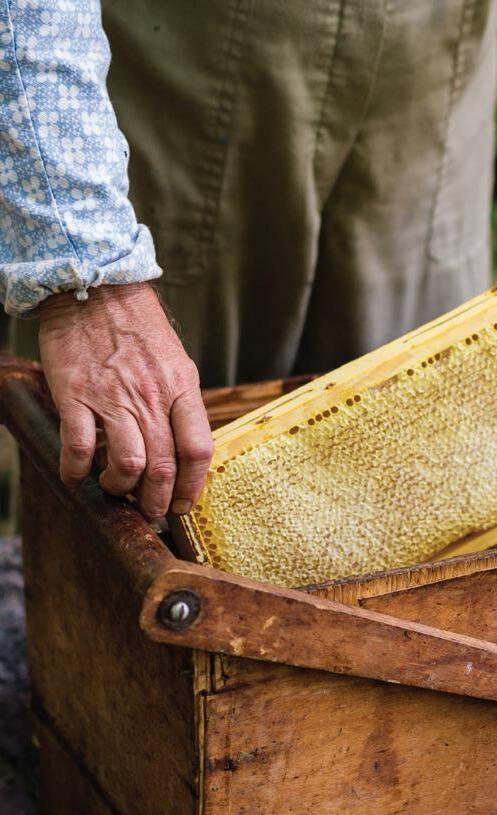

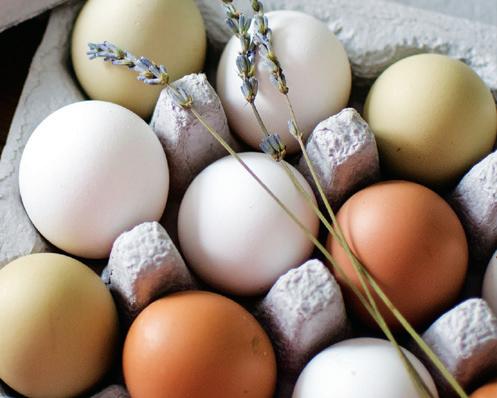
To order additional gifts, call us at (800) 234-3368 (promo code GMEBNN43) or visit us online at www.MotherEarthNews.com/EarthDay2023 4 AE R S AN STILL GROWINGSTRONG Let’s Make Every Day Earth Day! First 1-year subscription: $14.95 (58% off) 2 or more subscriptions: $10 each! (72% off) Give a Gift Subscription to Your Friends and Family! U.S. only It’s Up to You to Make A Difference! Make a big difference in one person’s life that will in turn make an impact on everyone. Give a gift subscription to MOTHER EARTH NEWS this Earth Day so others can take positive steps toward sustainable living. If each one of you gives one gift, think of the impact that we all will make on this planet. Plus, you’ll be giving the gift of feeling better, being healthier and living wiser to others — and they can share their ideas with us to grow the movement even more.
Avoid Non-Edible Look-Alikes
Some of the best-tasting mushrooms have look-alikes that are dangerous to consume. For example, angel wings (Pleurocybella porrigens) look a lot like oyster mushrooms and summer oyster mushrooms, but this species is toxic and perhaps even deadly to consume. While oysters and summer oysters grow on hardwoods, angel wings appear on conifers. Learn little facts like these before you begin your fungi-gathering career.
Lion’s Mane (Hericium erinaceus)

I’ll never forget the first time I glimpsed lion’s mane. While turkeyhunting in late October, I encountered a round, white glob with yellow, hanging spines (which look more sharp than they are) that was growing on a standing dead oak. I immediately knew what a find this was. This distinctive species can be as large as 10 inches long and wide, but this particular mushroom was about a fifth of that size.
Lion’s mane doesn’t feature a distinctive smell in the field, but it boasts the
taste and smell of shrimp in the pan. Because of those traits, a vegetarian friend of mine treats them as seafood when pairing them with veggies. Two other close Hericium relatives exist (H. americanum and H.coralloides), and, as a group, they cover most of the lower 48 and provide summer and autumn gathering opportunities.
Hen of the Woods (Grifola frondosa)
Hen of the woods ranks as a sublime find not only for its taste but also for its immense size up to 2 feet wide. This


polypore boasts brownish-gray overlapping layers, which are fan-shaped with wavy margins. Some folks believe hens emit a nutty odor; others can’t detect a smell at all.
Hens are a fall mushroom and are widespread throughout the East and Midwest. Last October, I found one growing on an oak stump along our driveway, but I discovered it when it was past its prime. Hen of the woods mushrooms often appear in the same places for several years, and this autumn, I’ll closely watch that stump.
Let the Foraging Begin!
Dead or dying hardwoods can make excellent firewood, but they can also host some of the best-tasting wild mushrooms. Learn to recognize these seven edibles and others and provide your family with many scrumptious meals.
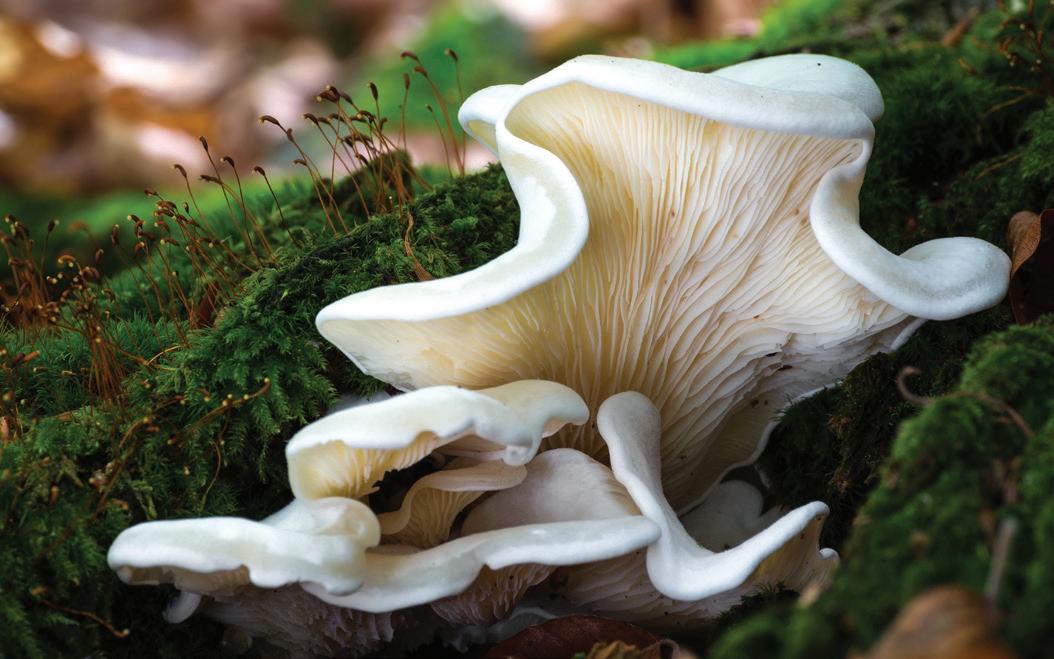
Bruce and Elaine Ingram are the authors of Living the Locavore Lifestyle, a book about hunting, fishing, and gathering for food. For more information, email them at BruceIngramOutdoors@Gmail.com.
Safe to Pick, Good to Eat
With Edible Mushrooms in your backpack, you’ll know to pick only the safest, most delicious chanterelles, truffles, morels, and more. Author Barbro Forsberg presents 40 edible species and reveals how, when, and where to find the knowledge gained over the course of four decades spent mushrooming in the woods. All content has been verified by a professional mycologist. Plus, nature and educational photographs illustrate how mushrooms grow, the environments where you can expect to find them, and the ways in which the same species may vary from one sample to the next. So, whether you’re an experienced mushroom hunter or a novice to the art, you can confidently recognize the tastiest wild mushrooms with Edible Mushrooms. This title is available at Store.MotherEarthNews.com or by calling 800-234-3368. Mention promo code MMEPANZ5. Item #7123.

50 MOTHER EARTH NEWS April/May 2023
Angel wings is a toxic mushroom.
C lo C kwise from top : A dobe s to C k / A m 13 photo ; A dobe s to C k /A lex A nder k urlovi C h ; A dobe s to C k / k A rel
From left: Lion’s mane and hen of the woods are both mushrooms you can find in fall.
EQUIPMENT FOR SUSTAINABLE LIVING







Live the wood life sustainably and get the most out of your natural resources by sawing your own logs into lumber with a Wood-Mizer portable sawmill. Sawing is an easy and fun way to save on the rising cost of lumber. With 15 models, we have the perfect sawmill built just for you.







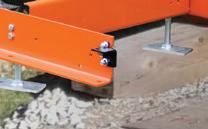


I have always wanted to build a greenhouse to extend my growing season. All western red cedar trees were harvested on my property and cut on my Wood-Mizer sawmill. It was very satisfying to build something from lumber I had milled myself.








 – Stan Kujala, British Columbia
– Stan Kujala, British Columbia



Financing Available! 866.344.1329 woodmizer.com © 2023 Wood-Mizer LLC *Price subject to change without notice. Live the Wood Life® is a registered trademark. ” SAW YOUR OWN LOGS INTO LUMBER! 15 SAWMILL MODELS
with the
$4,395*
starting
LX25 at
See #16 on page 89 See #38 on page 89
Butterfly Group Organize a Local
Protect pollinators by building relationships with your neighbors and exchanging plants and information.
By Kurt Jacobson
Pollinators are getting a lot of buzz lately, and “butterfly groups” are burgeoning across the U.S. These groups are formed to support monarch butterflies, bees, and other pollinators. With monarchs holding on to just a fraction of their original numbers, there’s no time to lose.
If you don’t already have a local butterfly group near you, why not form your own? You can trade seeds and plants, share information, count and track populations, and organize field trips all while building community with your fellow pollinator enthusiasts.
Let’s look at some existing butterfly groups, how they got started, and what they do to protect pollinators.
The Monarch Alliance
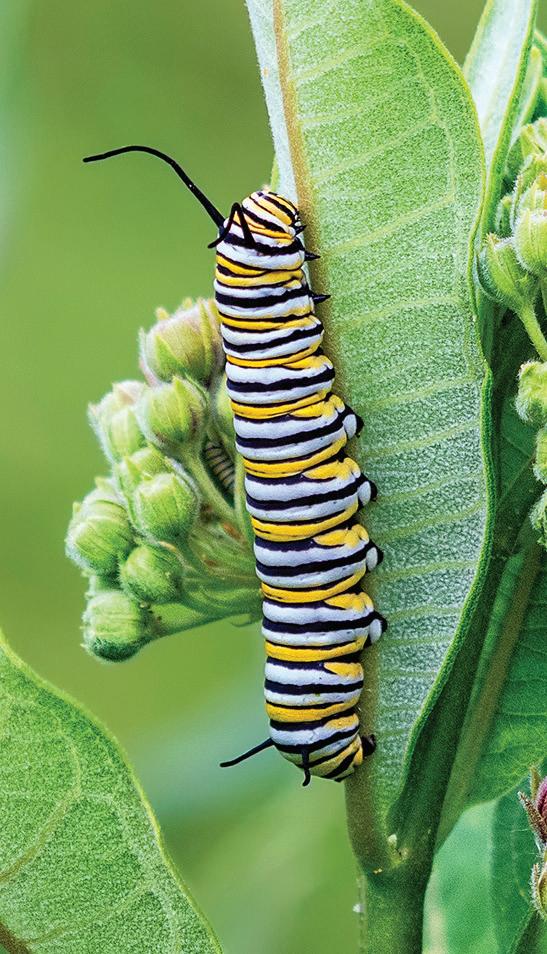
In 2014, Sandy Sagalkin visited the Mexican monarch reserves. After he returned home, he took a course on how to start a monarch garden, and in 2015, he formed The Monarch Alliance (TMA) to serve western Maryland and West Virginia.
The next year, TMA convinced Hagerstown, Maryland, to plant a monarch garden in Kiwanis Park. It also started a biannual


milkweed sale in partnership with a local nursery to fund a grant program to help create butterfly gardens and monarch waystations. Vouchers awarded through the program can be used to purchase plants at the biannual sale. TMA prefers to award grants to schools, nature centers, and other applicants who plan to educate the public about monarchs or involve students in outdoor learning.
TMA members also work to educate the public on plant and insect identification, and they’ve taught individuals, cities, schools, and businesses how to plant native gardens to help monarchs and

52 MOTHER EARTH NEWS April/May 2023
The Monarch Alliance’s biannual milkweed sales (left) fund the creation of butterfly gardens and monarch waystations.
Without milkweed, monarch caterpillars wouldn’t develop into butterflies.
other pollinators. TMA has partnered with local museums, Master Gardeners, and the local Parks and Recreation Department to engage a wide array of people. And some of its outreach is celebratory as well as educational: It hosts Monarch Discovery Days events in September to mark the area’s peak monarch migration.
To learn more about TMA, visit www.PotomacAudubon.org/ Monarch-Alliance.
The Beautiful Monarch
Holli Hearn started The Beautiful Monarch (TBM), a Facebookbased butterfly group, in 2014. Holli’s mission has changed over the years; what began as a desire to share photos morphed into an aspiration to start her own group for sharing information on monarch diseases and teaching members about the monarch’s growth stages. Many new members joined and chimed in with questions about everything monarch-related.
TBM’s Facebook page has dozens of excellent photos, a discussion page, and topical sections to help members learn to care for monarchs. Having a member base of 93,000 gives this group a lot of experience and knowledge to share. Though Holli’s group was recently paused, you can still peruse the albums and files by searching Facebook for “The Beautiful Monarch.”
Donna’s Monarch Butterfly Sanctuary
Donna’s Monarch Butterfly Sanctuary began when Donna Thompson decided other groups didn’t fit her needs. She wanted a group dedicated to monarchs, with a social media platform that
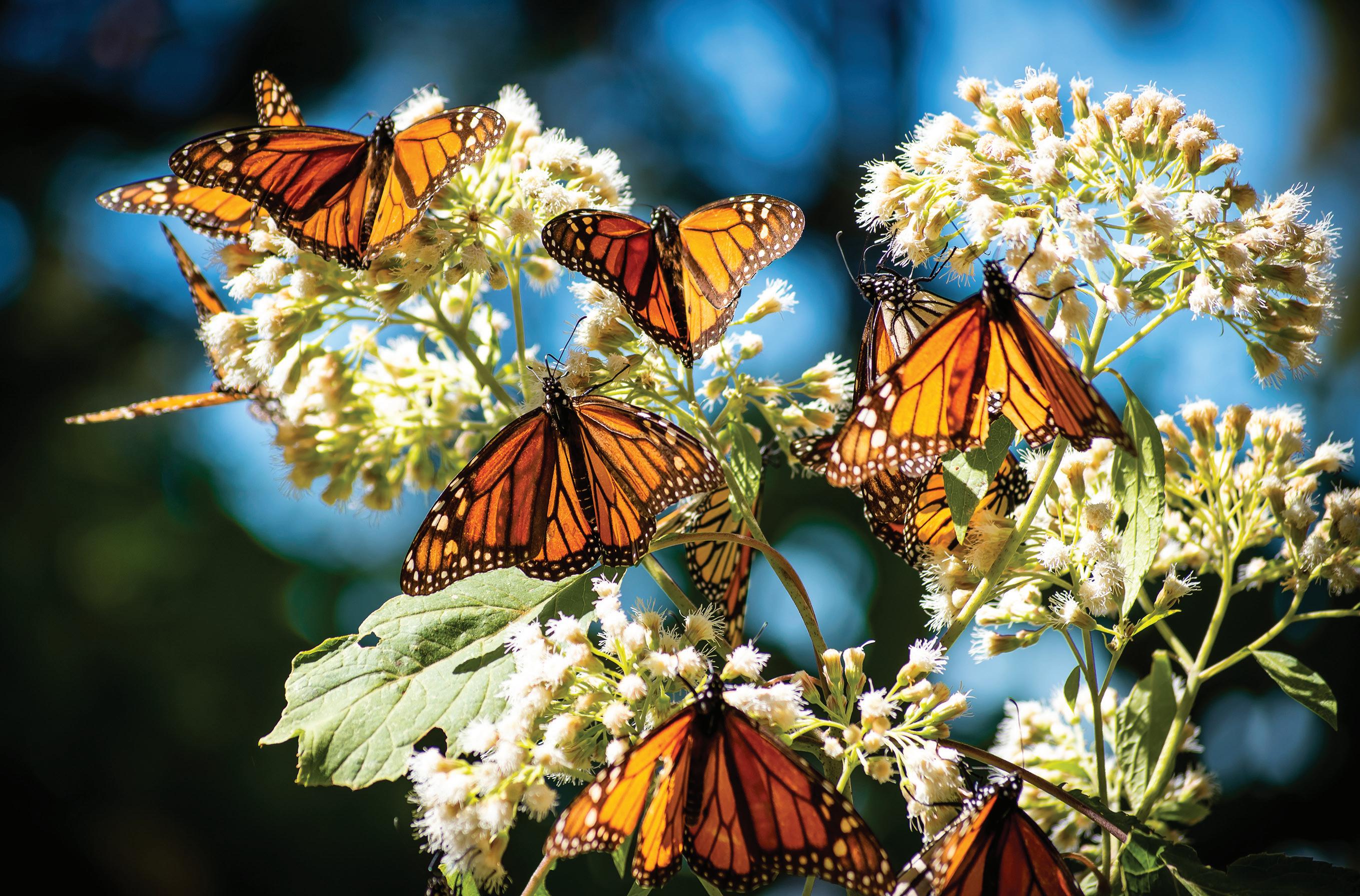
had strict rules no trolls and an open mind to allowing some non-native plants in butterfly habitats.
Donna started her Facebook group in 2021, and after just a year, it had almost 2,000 members. That year, Donna grew and distributed 1,700 free milkweed plants in Harford County, Maryland, and in 2022, she upped that number to 3,500. Donna’s mission is to share milkweed and knowledge to support monarchs, and to that end, she’s become a local expert on these butterflies and their preferred plants. While Donna began by planting nothing but native plants in her monarch habitat, she found the native milkweed soon began to spread aggressively. Now, she plants non-native tropical milkweeds, and her favorite type of milkweed is balloon plant milkweed (Gomphocarpus physocarpus), aka “hairy balls,” due to its high cardenolide content, which is important in a monarch caterpillar’s development. The butterflies that visit appear to prefer it, and most of the eggs Donna finds are on the hairy balls milkweed. Plus, Donna says these tropical milkweeds thrive through the monarchs’ peak season in August. Then, in October, she removes the plants so they won’t harbor parasite spores in winter.
As they pull into her driveway, visitors to Donna’s Monarch Butterfly Sanctuary will see two central butterfly gardens lush with butterflybush, joe pye weed, chaste tree, coneflowers, and more, with monarchs fluttering from plant to plant. Near her garage are several tables with dozens of potted tropical milkweed plants in various stages of growth. After giving a free tour, Donna sends many visitors home with a milkweed plant or two.
www.MotherearthNews.coM 53
A dobe S tock / S ergio ; p A ge 52, clockwi S e from top left : A dobe S tock /N NA ; A dobe S tock / leekri S ; flickr / l A ur A g ilchri S t ; t he m o NA rch A lli AN ce
In fall, massive groups of monarchs migrate south to hibernate.
On her porch are large and small caterpillar tents, aka “habitats.” On my first visit, I saw more than 40 monarchs in the chrysalis stage and witnessed five eclose (emerge) in just 10 minutes. Donna releases about 800 monarchs every season; members of her group collectively released more than 6,000 monarchs in 2022.
Donna’s Monarch Butterfly Sanctuary is adding members rapidly; Donna’s daughter, Jamie Lee, says the group gains 50 members daily. To join Donna’s group, search Facebook for “Donna’s Monarch Butterfly Sanctuary.”
Baltimore County Butterfly Gardening Group
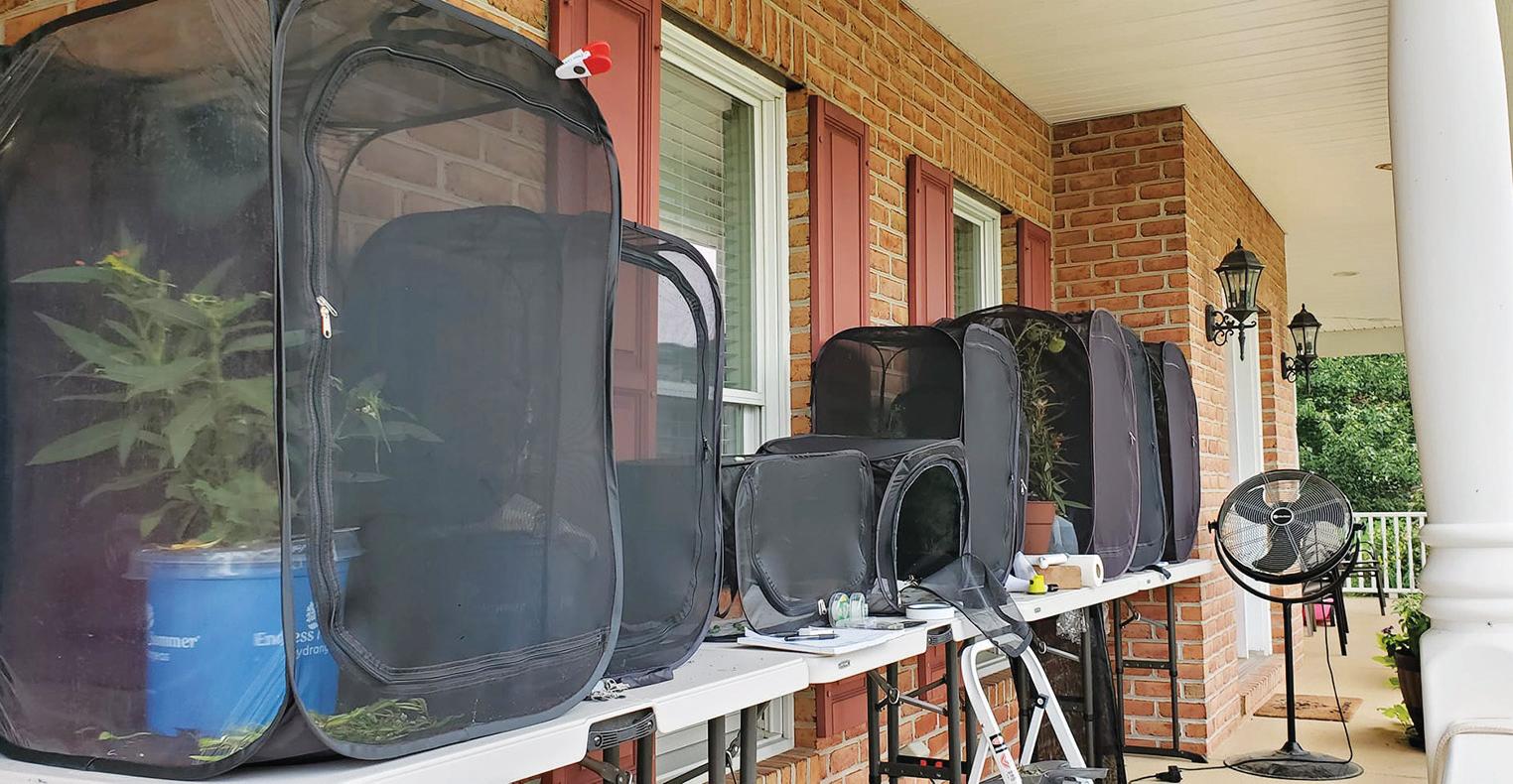


The Monarch Alliance motivated me to form my own butterfly group, the Baltimore County Butterfly Gardening Group (BCBGG). Founded on Nextdoor. com in April 2022, this group’s mission is to help my neighbors learn from each other and share knowledge and plants. Unlike the above groups, BCBGG will stay small and local. My group seeks to support all pollinators and nature in general. In just four months, the group has grown to a comfortable 65 members. Several of us have visited one another, shared milkweed, and swapped plants. One member gifted me gorgeous mountain mint. These connections strengthen our mission to increase butterfly habitat and reduce lawns in our area.
Build Your Butterfly Group
For your group to be effective, you’ll need members. Social media is one way to attract them. The Monarch Alliance gained some members due to its partnerships. We also reached out to a local magazine, which published a story about our group; you could do the same with your local media.
The group you form can support any butterfly you want. You get to choose, and then include the host plants your chosen species needs to support its caterpillars and butterflies. The U.S. Fish and
Wildlife Service website (www.FWS.gov) has a native plant finder feature that can help you locate host plants for the butterflies you’re seeking to help. No matter which butterflies you seek to support, you and your group’s members will enjoy turning your own yards into enthralling pollinator plots.
Kurt Jacobson is a freelance travel, food, wine, and organic farm writer. He and his wife live in Perry Hall, Maryland, with a German Shepherd, two Maine Coons, and a
Explore the Life Journey of One of the Winged Wonders of the World
With easy-to-read text and colorful, engaging illustrations, Monarch Butterflies presents young readers with rich, detailed information about the monarch’s life cycle, anatomy, and the wonders of the butterfly’s signature migration, as well as how to raise monarchs at home. As the book considers how human behavior has harmed monarchs, it offers substantive ways children can help make a positive difference. Children will learn how to turn lawns into native plant gardens, become involved in citizen science efforts, and support organizations that work to conserve butterflies. This title is available at Store.MotherEarthNews.com or by calling 800-234-3368. Mention promo code MMEPANZ5. Item #11359.

54 MOTHER EARTH NEWS April/May 2023
lovely backyard full of native wildlife, butterflies, veggies, and flowers.
D onna T hompson (2)
Donna Thompson grows plants for monarchs at her home, including “hairy balls” milkweed (top), and she keeps tents on her porch to provide habitat for caterpillars in the chrysalis stage (bottom).
• Best e ciency, highest Btu rating - At 92% overall e ciency (LHV), the Classic Edge 960 HDX provides the highest e ciency of EPA-certi ed stick wood burning appliances and delivers the highest Btu rating of cord wood appliances, with a rating of 400,000 Btu/hr.**
• Easiest to operate - Industry-exclusive FireStar® controller takes all the worry and guesswork out of wood heating. Works with any heating system and any rewood.


• Easiest to maintain - Full-access design and patented Easy View® Heat Exchanger with hinged door.


Apply for Financing Now at CentralBoiler.com > Explore > Financing/Incentives This IS Energy Independence. Outdoor Wood Furnace Remote monitoring on your smartphone with industry-exclusive FireStar Controller
is no better way to heat with wood. Payments as low
$137/mo 2000 UP TO TAX CREDIT* $ Must be installed in accordance with all applicable codes and regulations. *On quali ed models and installation. US Internal Revenue Code Sec. 25(C) e ective Jan. 1, 2023, for heating a residence. Consult a tax professional with any questions. **At participating US dealers only. Loans provided by EnerBank USA, Member FDIC, (1245 Brickyard Rd., Suite 600, Salt Lake City, UT 84106) on approved credit, for a limited time. Repayment term is 144 months. 9.99% xed APR, e ective as of November 2022. Minimum loan amounts apply. The rst monthly payment will be due 30 days after the loan closes. Payment shown for Classic Edge 360 Titanium HDX. ***As of 1/30/23, compared to outdoor appliances with a maximum output greater than 300,000 Btu/hr. ad7879
There
as*
Simple. Fast.






























Take the hassle out of backyard chicken processing. Plucking a chicken by hand can take as long as 30 minutes.



Yardbird has revolutionized this painstaking and messy process. With the Yardbird Chicken Plucker, you can fully defeather two birds in 15 seconds or less!





























Visit www.yardbirdpluckers.com | 1730 Industrial Avenue | Cumberland, WI 54829 | 800-345-6007 Scalding Gloves • 100% Waterproof • Heavy Duty Neoprene Coating • Extra Long Cu s Protect Forearm Adjustable Restraining Cones • Heavy Duty Composite Material • Adjust Size to Fit Your Birds • Fits Birds 2-10 Pounds Butchering Apron • 100% Waterproof • Long sleeves with elastic cu s • Knee length or longer on adults Lung Removal Tool • Stainless Steel Angled Head • Textured Plastic Handle • Ergonomic Design More from Yardbird...
Chicken Plucker Yardbird-Ad-7500x1000-122922e-lt.indd 1 12/29/22 2:09 PM See #5 on page 89
All About the Heat
By Marissa Ames
Can you list the five things you need to raise healthy chicks in a brooder? Food, water, bedding, grit, heat. The first four are simple, but the fifth gets complicated. Mimicking the warm protection of a mother hen means keeping babies at an optimal temperature, which changes week by week until they’re ready to stay outside for good. And adding supplementary heat isn’t optional, no matter the time of year. From hatching day to
that first night spent in the coop, monitoring and providing the right temperatures for chicks makes the transition smooth and keeps babies healthy.
Only chicks, not chickens, need supplemental heat in winter, and only for a short time. Comfortable human homes are 20 to 30 degrees Fahrenheit too cold for chicks. The ideal temperature for chicks that are 7 days old or younger is 95 degrees, and then 90 degrees in the second week and

85 degrees in the third. Each week declines by 5 degrees until chicks are ready to live outside. To help you learn more about heat and temperature for chicks, we’re diving into some FAQs about them.
Why Can Mother Hens Bring Babies Outside, Even in Freezing Weather?

Because they don’t have feathers to self-regulate temperature, newly hatched chicks depend on mothers to keep them warm. A hen’s internal temperature ranges from 105 to 107 degrees. Darting beneath their mother’s wings when they’re cold, and emerging only to eat and drink, babies thrive on the mother-to-chick relationship. It may look like babies are constantly outside, but they take short trips and then hurry back to warm up.
You must provide your brooder chicks with appropriate heat sources and closely monitor them with thermometers and good judgment.
Thanks to Brinsea, this article is available online in audio form at MotherEarthNews.com A dobe S tock /L o S t in tr A n SLA tion
These answers to FAQs will help you learn how to keep chicks warm and healthy and when to transition them to outdoor coop life.
How Do I Keep Chicks Warm Enough Without a Mother Hen?
When planning hatchings or chick purchases, plan the brooder as well. Avoid waiting until babies arrive; have a full setup — which includes food, water, grit, bedding, and a heat source — ready when you bring chicks home. That way, you can immediately place them in a comfortable environment and help them recover from travel shock. Each moment a baby chick is too cold is another moment its health declines.
Purchase heat lamps from feed or pet stores. Experts recommend red bulbs because they’re not as bright as clear ones, allowing chicks to have natural day and night cycles. Red bulbs also discourage chicks from picking at each other. Reptile bulbs aren’t hot enough; 250-watt varieties are most recommended. Always use a lamp setup made specifically for heat bulbs, as heat levels and higher wattage can damage desk lamps or painter’s lamps. Secure the
lamp well; if it falls into a brooder, results could be tragic. Always keep bulbs at least 2 feet from combustible materials.
Many companies now offer safer options, such as brooder plates. These sit inches from the brooder floor, just far enough for chicks to run underneath when they get cold and go exploring when warm enough. Brooder plates never get hot enough to burn the babies, and they adjust to rise off the brooder floor as chicks grow.

You can also use heated pads that lie beneath bedding, providing warmth from below. If you choose these, be sure they’re rated for baby chicks. And read reviews! Cheaper knockoff brands can be dangerous, shorting out or creating hot spots. Don’t use seed-starting mats or heating pads intended for humans. And always monitor temperatures, no matter what you use.
If you just brought chicks home, keep them in an area near 95 degrees while you
How to Measure Relative Humidity
find a heat lamp or brooder plate. And don’t waste time — get an appropriate heat source before the day ends.


How Do I Know If Chicks Are Warm Enough?
For starters, install a thermometer in the brooder to monitor temperature. But determining whether chicks are warm enough (or too warm) isn’t difficult. If they huddle together directly in the heat lamp’s beam, they’re colder; lower the lamp closer to the brooder. If they move away from the beam to sleep, they’re hotter; raise it up. And if you see chicks panting, that means they’re overheated and need cooler temperatures quickly.

A well-set-up brooder will have warmer and cooler areas; that way, chicks can sleep under heat and water can sit at the edges, where it won’t evaporate so fast.

If your home temperatures range around 75 degrees, you won’t need to supplement heat past four weeks. But in
Relative humidity is the most common measurement used in incubation, and it’s a percentage of how much moisture the air can hold at a given temperature. Most modern incubators measure relative humidity, but if you have an older unit, you can calculate relative humidity by using two bulb thermometers in your incubator. Place one end of a cotton wick over the bulb end of one, and place the bulb end of the other in water. Note the difference between the wet and dry thermometer bulb readings, and use one of the many charts available online to calculate your relative humidity.
58 MOTHER EARTH NEWS April/May 2023
C LOCKWISE FROM BOTTOM : B RINSEA ; A DOBE S TOCK ACCEPTFOTO ; A DOBE S TOCK / PLINSBOORG
From left: Set up your brooder with warmer and cooler areas. A mother hen can provide all the warmth chicks need, especially outside.
barns or garages, which may run 60 degrees or cooler, chicks will need supplementary heat until they’re fully feathered at 6 weeks of age. Consult the chicken heat table (below) when determining whether your chicks still need heat and, if so, at what temperature they need it.
Can I Hold the Babies or Take Them Outside?
Though mother hens let hatchlings roam freely, their warm, feathery bodies are waiting close by. A balmy 70-degree spring day can quickly chill a brooder baby. Keep this in mind when you remove chicks from brooders to hold them. Wait until little ones are older before you remove them from brooders for more than a few minutes. Chicks that are 4 weeks old can’t handle temperature fluctuations much better than 4-day-old babies.
When Can Chicks Go Outside for Short Trips?
Though they’re not old enough to live outside, chicks living in brooders can enjoy short “field trips” starting around the third and fourth weeks. If you take them onto the lawn to peck at grass and



chase bugs, stay wary of weather, outside temperatures, and the chicks’ ages.



These field trips will allow chicks to exercise and expand their diets. Exposure to the elements, at appropriate temperatures, will toughen and acclimate them so the first night out isn’t such a shock. It’ll also allow you to bond with brooding chicks as they grow, which will create a gentler and more human-friendly hen or rooster.
When Can Chicks Go Outside Permanently?
“Fully feathered” is the point when all fluff has been replaced by true plumage. Chickens self-regulate temperatures by fluffing their feathers and creating air layers. If even just the neck still has fluff, a brooder baby isn’t ready to sleep outside.







Until then, use the rule that newly hatched chicks need ambient temperatures of 95 degrees; each week after, reduce that by 5 degrees. They can spend all day outside if temperatures stay within the right range for their ages. But remember, even if it’s warm enough, wind and water will chill a chick. The more chicks in the flock, the more they can huddle for warmth, and you won’t have to rush them inside as fast.




Chick Age Temperature (°F) Considerations














0 to 7 Days 95 degrees







Now isn’t the time to let babies stay outside the brooder for more than a couple of minutes.
Week 2 90 degrees




Week 3 85 degrees
Week 4 80 degrees
Week 5 75 degrees
Week 6 70 degrees
Babies start flying early! Be sure the heat lamp is secure and can’t be reached.

Chicks can make short trips outside if the weather is nice and warm.
Let chicks enjoy more time outside, but keep a close eye on them.

Is your house 75 degrees? Turn off the heat lamp.



Start acclimating the chickens, letting them spend all day outside, unless the weather is cold and rainy.




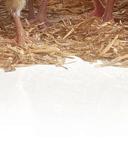

After 6 weeks Ready for outside! Fully feathered chicks can endure 30 degrees and lower. Acclimate them before putting them outside for good. Be sure coops are draft-free.
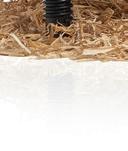
Incubation Specialists For more information www.brinsea.com or call 1-888-667-7009 Brinsea the world leading incubator manufacturer has a full line of incubators, brooders, egg candlers, starter kits and much more! All with 3 year warranty. Free Color Catalog Hatching your own chicks is fun, easy and reliable with Brinsea Ifahencould choose… See #7 on page 89
Outside “playpens” should be fully enclosed, with all openings too small for chicks to squeeze through. Always cover the enclosure’s top, because birds this small are vulnerable to cats and other predators. Even blue jays can enter topless enclosures and terrorize chicks. Smaller wild birds may bring diseases.
Keep food and clean water available as well as shade and shelter — which can simply be a box lying on its side.









Bring chicks inside if it rains or if you see them huddling together instead of exploring their surroundings. Also, if their daytime playpen is unsecured against predators, bring them inside anytime you can’t supervise.

Try carrying them one by one, out to the playpen and back in, instead of hauling a pet carrier full of babies. This will get them used to being handled and make them more trusting. It’ll let them know that being grabbed by their human owners isn’t something to fear.
As babies near that 6-week mark, turn the heat lamp off when ambient conditions allow. Let them experience days and nights within your house or garage and acclimate to cooler temperatures.

Remember, adding heat to outside coops is dangerous! Gradually transition from a heated environment to unheated but comfortable and then to outside and sheltered rather than going straight out at Week 6 to brave the elements.





This six-week timeline has exceptions. Coccidiosis is more common when baby chicks spend time outside, because protozoa can be spread by wild birds. But coccidiosis is easy to avoid with medicated chick feed and probiotics. If you see pink, meaty-looking, or bloody stools, stop the field trips for a few days and treat the babies. Wild birds also spread viruses and bacteria, and some are highly contagious. If your chicks have been sick, keep them inside a while longer after they stop showing symptoms, especially if you have older birds they could infect.


Whether chicks are outside or in, always ensure they have clean bedding, food, and water to reduce stress and risk of infection. Watch how they act: Do they huddle to keep warm, are they lethargic, or do they happily flap around and peck the ground? Whether fully feathered or still wearing fluff, that happy flapping and pecking are your best signs of healthy, warm babies.


Marissa Ames is the editorial director for Ogden Publications. She and her husband teach sustainable farming to Zambian rural villages and schools, where they’ve partnered with villages to trial saffron as a potential cash crop that doesn’t compete with local farmers. Currently, she’s working on sustainable methods for battling devastating armyworm infestations without purchasing pesticides. Marissa works to save a critically endangered American breed by keeping rare San Clemente Island goats. Her small homestead has a large vegetable garden where she studies and develops drought-tolerant crops, and she makes her own cheese, bacon, soap, bread, and much more.

B RINSEA KozGro Treated Untreated B O O S T W O R M P O P U L A T I O N I M P R O V E G E R M I N A T I O N I N C R E A S E N U T R I E N T U P T A K E I M P R O V E S O I L F E R T I L I T Y B O O S T S T A L K & L E A F Q U A L I T Y B R E A K D O W N R E S I D U E w w w . K o z G r o O r g a n i c s . c o m P L A N T & S O I L B U I L D E R GardenGro Lawn & Landscape House Plant Elixir Agricultural Field Blend See #13 on page 89
A brooder should have bedding, food, water, grit, and heat, such as a brooder plate, pictured here.




















See #1 on page 89
DIY Greenhouse
Learn how to build a low-cost, portable greenhouse.

Story and photos by
Karl Thorup
Over the years, I’ve often wished for a greenhouse to grow plants through winter. I didn’t want to spend too much money to build a greenhouse that later failed, and purchasing a pre-built greenhouse was a bit too pricey for my pocketbook.
After a little research, I found the four basic principles necessary in making a functional greenhouse:
1 A clear wall is required for sunlight to pass through.
2 The clear wall should have the ability to trap heat inside the greenhouse and keep cold outside. In other words, the “clear” wall should have a high R-value.
3 There should be dark-colored objects inside the greenhouse to absorb the incoming sunlight and re-radiate it into the space. This radiative heat can’t escape the greenhouse very well; it can’t go back out through the clear wall.
4 There should be something in the greenhouse to store the heat, such as water. The ability of a material to store heat is called “specific heat,” and water has a high specific heat.

Frame
I took apart a “9 Square” volleyball game I’d built to get 1-inch PVC pipe parts to build the greenhouse, which would be 5.5 feet cubed (see Figure 1).
Door
I wanted the door to be low-cost. I bought a larger PVC pipe and placed it over a smaller PVC pipe, and then I had the beginnings of a swinging door. I did have to get different sizes of PVC pipe for the door portion, but it worked (see Figure 2).
The design required me to add a PVC pipe in the middle of a wall, and I liked the resulting structural strength, so I also placed an additional pipe on the ceiling and on the opposite wall of the door.
Tools and Materials
• 15 pieces 1-inch PVC pipe, 5.5 feet in length, with the appropriate adapters
• Miscellaneous PVC pipe and adapters, for the door
• Bubble wrap
• Stretch film
• Packing tape
• Plastic and vinyl floorboard molding
• Pipe insulation
• Self-tapping screws to hold the molding around the door
• 27 gallon tubs (10)
• Black spray paint
The entire cost was approximately $200, counting the cost of the materials used, but not leftover material, with about half the expense being the large tubs.
Hometown Hacks Projects From Our Readers
62 MOTHER EARTH NEWS April/May 2023
Figure 1: The basic PVC pipe frame is 5.5 feet cubed.
I could’ve placed additional PVC pipes on the remaining two walls, but I didn’t to minimize cost, and the structure didn’t really need it. If you live in a place with strong winds, the greenhouse would benefit from the added structure strength.


Walls and Ceiling
I considered what could be used for the walls and could only think of the rigid, clear, double-wall plastic sheets I’d used on a previous build. Then, my wife gave me a great idea: Plastic wrap. This made me think of the stretch film used to wrap pallets for shipping. Then, while considering packaging materials like stretch film, I thought of bubble wrap! Bubble wrap can be purchased in assorted sizes. The bubbles give the plastic R-value because of the trapped air inside them. Plus, it’s cheaper than hard, double-wall plastic sheets.
I chose bubble wrap with 1-inchdiameter bubbles. I decided to use stretch film around the outside of the bubble wrap for better insulation. The bubble wrap would have some insulation, but adding the stretch film on top of it created more air pockets, so the walls and ceiling had better insulation properties. I probably could’ve skipped the stretch film and used two layers of bubble wrap with the bubbles facing each other, but I feared less visible light would get into the greenhouse, and that it would cost a little more because bubble wrap is more expensive than stretch film.
Assembly
Unfortunately, I didn’t document the initial building of the greenhouse. My son told me I ought to test the design before considering the greenhouse a success. So, the pictures in this article were taken as I disassembled the greenhouse after a successful winter of proving the design.
Here are the steps I took to construct the greenhouse.
Frame. I built the PVC cubic frame using the appropriate corner connectors and didn’t use glue. I wanted the capability to disassemble the greenhouse in spring and build it back up in fall. Once or twice in winter, a PVC pipe came out of its connector (usually after a strong wind), but even with the bubble wrap installed around the frame, it was easy to put the pipe back into its connector because I had full access to the frame inside the greenhouse.
Walls and ceiling. With the door closed, I began wrapping the outside of the frame, ignoring the fact that the door was there, at first. I used
packing tape to hold the bubble wrap to the frame at the start and whenever I felt it needed it. I started at the lowest level and wrapped the bubble wrap all the way around the frame, with the bubbles facing outward. Then, I started a new bubble wrap row higher up, allowing about a 6-inch overlap of the layers. I continued the process until I got to the top of the frame.
For the ceiling, I cut strips of the bubble wrap to a good length and taped them to the already installed bubble wrap using packing tape, and I used packing tape to hold one piece of bubble wrap to another. After the bubble wrap was installed, I did the same thing all over again with the stretch film on top of the bubble wrap.
At this point, the door was enclosed in the plastic wraps. So, I used a utility knife and carefully cut the plastic along the door seams, using packing tape to hold the wraps to the PVC door frame and door. This worked but resulted in the plastic wraps not being tight to the door when I opened it. I was okay with that, because the plastic wall would tighten up again when I closed the door.
Door gaps. I did have air gaps around the door that I felt were unacceptable. Those gaps would let cold air into the greenhouse in winter and compromise the insulation. I pondered how I could cheaply seal the gaps but still be able to open and close the door regularly. I went to a home improvement store and found vinyl and plastic floorboard molding and foam pipe insulation that would fit around the door frame. I purchased both items and installed them around the door using the
www.MotherearthNews.coM 63
Figure 2: The greenhouse door is made of PVC pipe and adapters.
In winter, the greenhouse temperature would rise up to 30 degrees above the outside temperature.
Figure 3: Plastic floorboard material and foam pipe insulation seal up the door.
self-tapping screws (see Figure 3). See Figure 4 for the door latches I made.
Water-storage tubs. I then prepared the water tubs to go inside the greenhouse. While the tubs themselves were black, which is what I wanted for absorbing heat in the greenhouse, the lids were yellow, so I spray-painted the lids black. I didn’t wait more than a day or two to put them into the greenhouse, so most of the winter, the greenhouse smelled a bit like paint. It didn’t affect the greenhouse or plants at all, it just wasn’t a pleasing smell. Next time, I’ll wait longer for the paint smell to dissipate before I put the tubs into the greenhouse.
I filled each tub with about 25 gallons of water, leaving room at the top of each tub so when I put the lid on, water wouldn’t come out. With 10 tubs, I had 250 gallons of water to absorb the heat generated during the day.
The more water you place in the greenhouse, the more temperature averaging will happen, but you’ll start to lose room in the greenhouse and the cost will increase. I found this amount of water to be good enough for my purposes. See Figure 5 for the tub placements.
Summary
I monitored the greenhouse throughout winter, and it would get up to 30 degrees Fahrenheit above the outside temperature during a sunny day and stayed above freezing at night.

The packing tape seemed to hold fine until spring, when it warmed up and began to lose its stickiness. So, I had to add new tape to the greenhouse here and there along the way. The bubble wrap, stretch film, and PVC all held up fine through winter and will be reusable next year.
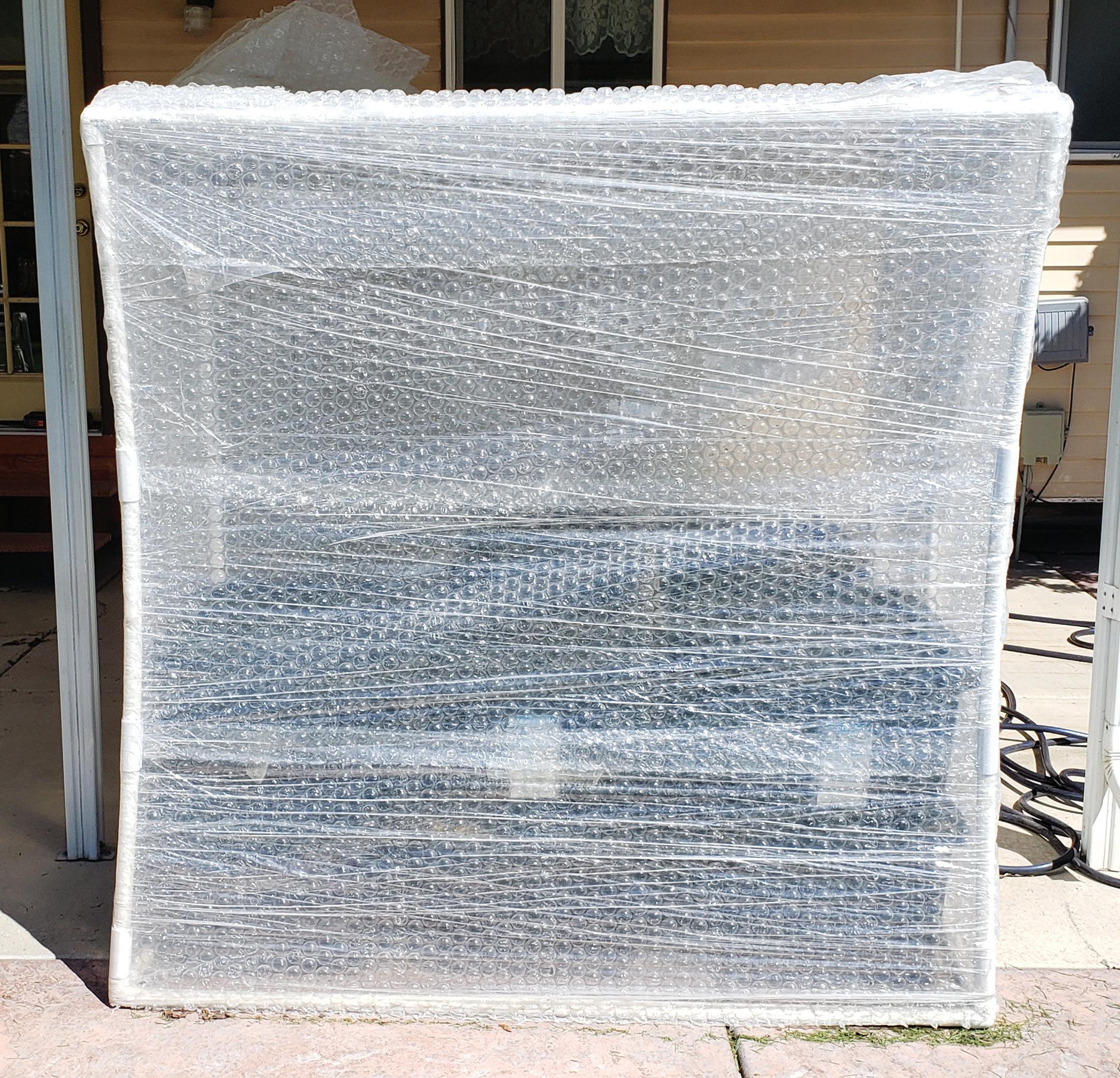

Karl Thorup is a Utah native and enjoys outdoor life and creating new things. He has a bachelor’s in physics and a master’s in electrical engineering. Karl has eight children and 16 grandchildren, and his wife is the gardener of the family while Karl is the facilitator.

64 MOTHER EARTH NEWS April/May 2023
Figure 4: The door closes and latches shut with a homemade latch.
Figure 6: The greenhouse from the outside, wrapped for insulation.
Figure 5: Black water tubs inside the greenhouse absorb heat and keep the greenhouse warm.
MOTHER NATURE’S MOSQUITO CONTROL
Here’s the natural way to control the most dangerous insects on the planet
all-natural, nonchemical way to keep mosquito populations under control.
BTI and Mosquito Control

Mosquitoes lay their eggs in standing water. So, eliminating standing water has long been an important part of mosquito and disease control.
It is impossible to eliminate all standing water. But that’s where BTI comes in. When BTI is present in water, mosquito larvae feed on the BTI and die—long before they can grow up to become flying, biting, disease-spreading adults.
BTI is the active ingredient in Mosquito Dunks®, the bestselling sustained release natural mosquito larvicide. When a donut-shaped Mosquito Dunk® is placed in water, the BTI will kill mosquito larvae in up to 100 square feet of surface area for 30 days or more.
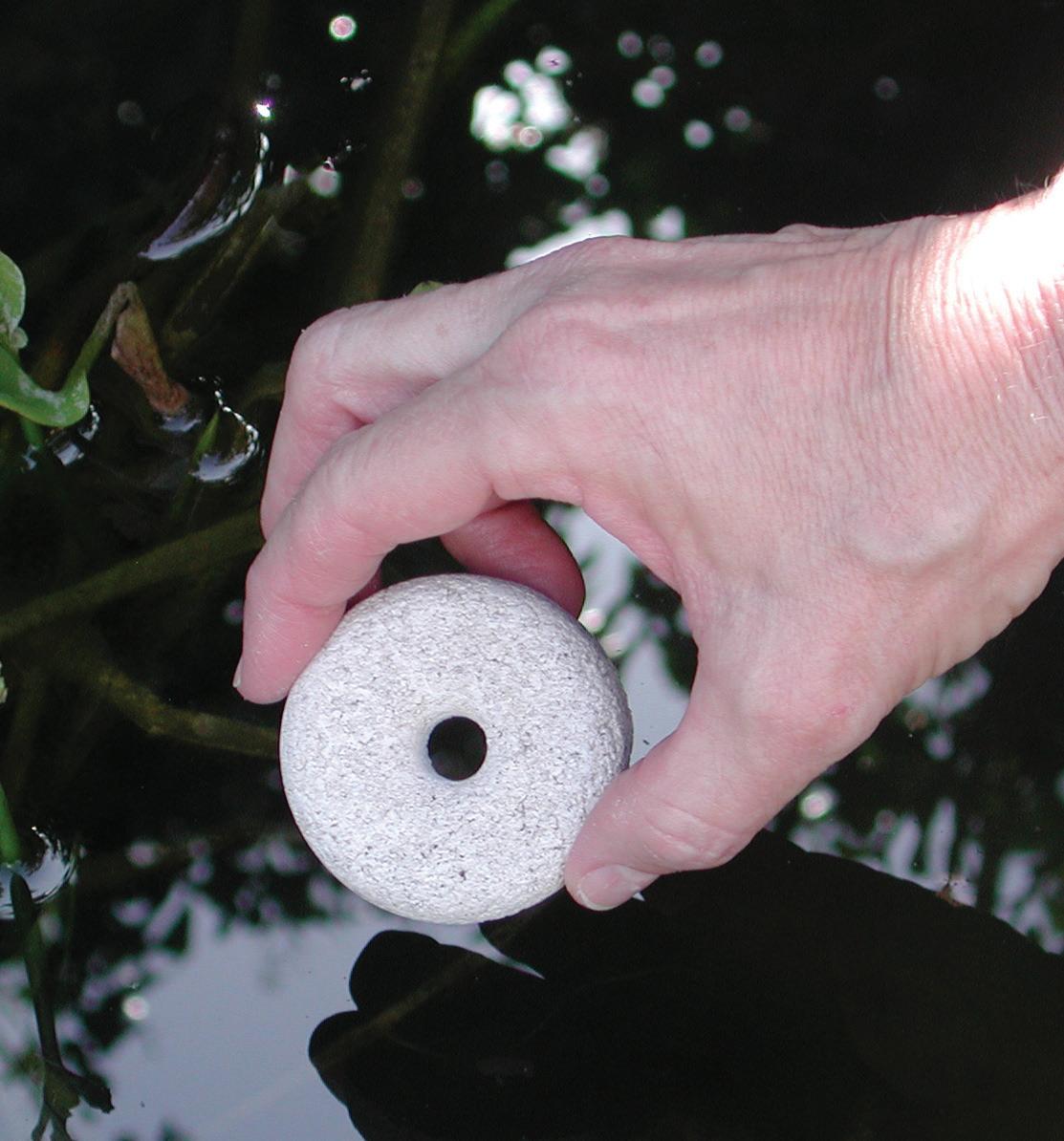
To kill mosquito larvae in ponds, animal watering troughs, stock tanks, and neglected swimming pools, simply drop in a Mosquito Dunk®. In smaller amounts of water, such as birdbaths and rain barrels, smaller Mosquito Dunk Chunks® can also be used.
When it comes to controlling mosquito populations, Mother Nature has an ingenious solution. That’s why a growing number of gardeners, homesteaders and public health professionals are following nature’s lead by using a naturally occurring bacterium to kill mosquito larvae before they can become disease-spreading adults.
Many scientists call mosquitoes the most dangerous insects on the planet. That’s because mosquito bites transmit deadly diseases including malaria, West Nile virus, and dengue fever.

But Mother Nature has a natural way to control mosquitoes. It’s called Bacillus thuringiensis israelensis (commonly known as BTI), which is a species of naturally occurring bacteria that lives in the soil. The microscopic BTI bacterium makes a protein called cryprotein, which targets and kills mosquito larvae. When mosquito larvae eat the toxic protein, it breaks down their gut and the larvae soon die of starvation.
The Discovery of BTI
The BTI bacterium was discovered in 1976 in a stagnant pond in the Negev Desert of Israel. Testing showed BTI was toxic to mosquito, black fly and fungus gnat larvae. Further testing demonstrated that BTI is not toxic to humans, mammals, birds, fish, beneficial insects, or plants.
The discovery of BTI proved that Mother Nature had an
To eliminate mosquito larvae fast, quick kill Mosquito Bits® are the right choice. Mosquito Bits® are granules coated with BTI that releases immediately in water. Frequently used to cover large swampy areas or areas that are difficult to treat with Mosquito Dunks®, they provide a quicker kill but need to be reapplied every 7 to 14 days.
How Safe are Mosquito Dunks?
Mosquito Dunks are approved for organic production and organic gardening, under National Organic Program guidelines. The EPA has registered Mosquito Dunks for use in animal watering troughs and fish habitats. A pet or a wild animal could conceivably eat a Mosquito Dunk or drink water treated with BTI. When that happens, the animal essentially gets a large dose of protein and calcium—which is not harmful to the animal.
Summit® Mosquito Dunks®, Mosquito Dunk Chunks®, and Mosquito Bits® are available at garden centers, hardware stores, and home centers. Visit www. SummitResponsibleSolutions.com for more information.
See #33 on page 89
ADVERTISEMENT












NL INE Garden Planning Course Pam Dawling Soil Building Master Course Leah Webb Maple Syrup Production Amyrose Foll Featuring: Mother Earth News Fair Online is a learning platform featuring more than 50 courses with more than 200 workshop videos. Plus, new courses are added monthly. Get access to all courses and prerecorded webinars with an AllAccess Subscription for just $35/year! Mastering the Money-Saving Art of Sustainable Living Has Never Been Easier! Today! REGISTER www.MotherEarthNewsFair.com • Soil Building Master Course • Brooding Chicks Master Course • Real Food Course • Natural Health Course • Fuller Field School Series • Introduction to Raising Pigs • Self-Sufficiency Series • Climate Victory Garden Series • Pasture Management Course COURSE Topics See the Full List of Courses Online! Pasture Management Course Hank Will Productive Growing from Home Nicky and Dave Schauder Introduction to Raising Pigs Pork Rhyne






















APRIL 29-30 LAWRENCE, KS NEW For more information on our in-person events — including tickets, exhibits, and sponsor inquiries — as well as our online courses and webinars, please call 800-234-3368 or visit www.MotherEarthNewsFair.com All programming, dates, and locations subject to change. JULY 15-16 ERIE, PA APRIL 29-30 Douglas County Fairgrounds LAWRENCE, KS 50+ WORKSHOPS Learn Money-Saving Skill Sets from the Pros 100+ EXHIBITORS Gardening Tools, Energy-Savers, Natural Body Care, Handmade Goods, You Name It! FAMILY-FRIENDLY FUN Demos, Food Trucks, and ... ... LIVESTOCK! Goats, Chickens, Cattle, & More! RegisterNow! PORK RHYNE • Pasture Pig Q&A LEAH WEBB • Seven Steps to Homesteading JANICE COX • Beautiful Lavender IRA WALLACE • How to Grow Perennial Onions, Leeks and Other Unusual Alliums KEITH ARKENBERG • DIY Farm Tools Tickets Available Now! www.MotherEarthNewsFair.com Kids 17 & Under Get In Free! And More! SEPT. 16-17 WEST BEND, WI LEARN MORE AT www.MotherEarthNewsFair.com/Voices We’re excited to introduce our inaugural 2023 M OTHER E ARTH N EWS Voices!
Simple Homemade Body Care
Some people think of home-based crafts as fancy hobbies rather than attributes of self-reliant living, but it all depends on the context. Whenever you do things simply, you can save money.
I’ve made wonderful homemade soap with old oil, and candles from otherwise useless paraffin drippings. I’ve unraveled old sweaters and used the recycled yarn to make new things. Most of the time, I can’t afford hobbies that cost money, so I get creative with whatever I have on hand.
Proficiency in traditional skills is a kind of security fund: Today, it may be easy to buy whatever you fancy in a store, but tomorrow, you may be glad to know how to make your own.
A good place to start is making natural body-care products. They’re usually quick to make and great for personal use or as hostess gifts when packed in pretty jars. They’re even a potentially profitable home-business venture. And they’re a lot healthier than commercially available products!
Here are a few of my favorite easy-to-make recipes for body care.
Super-Simple Salt Scrub
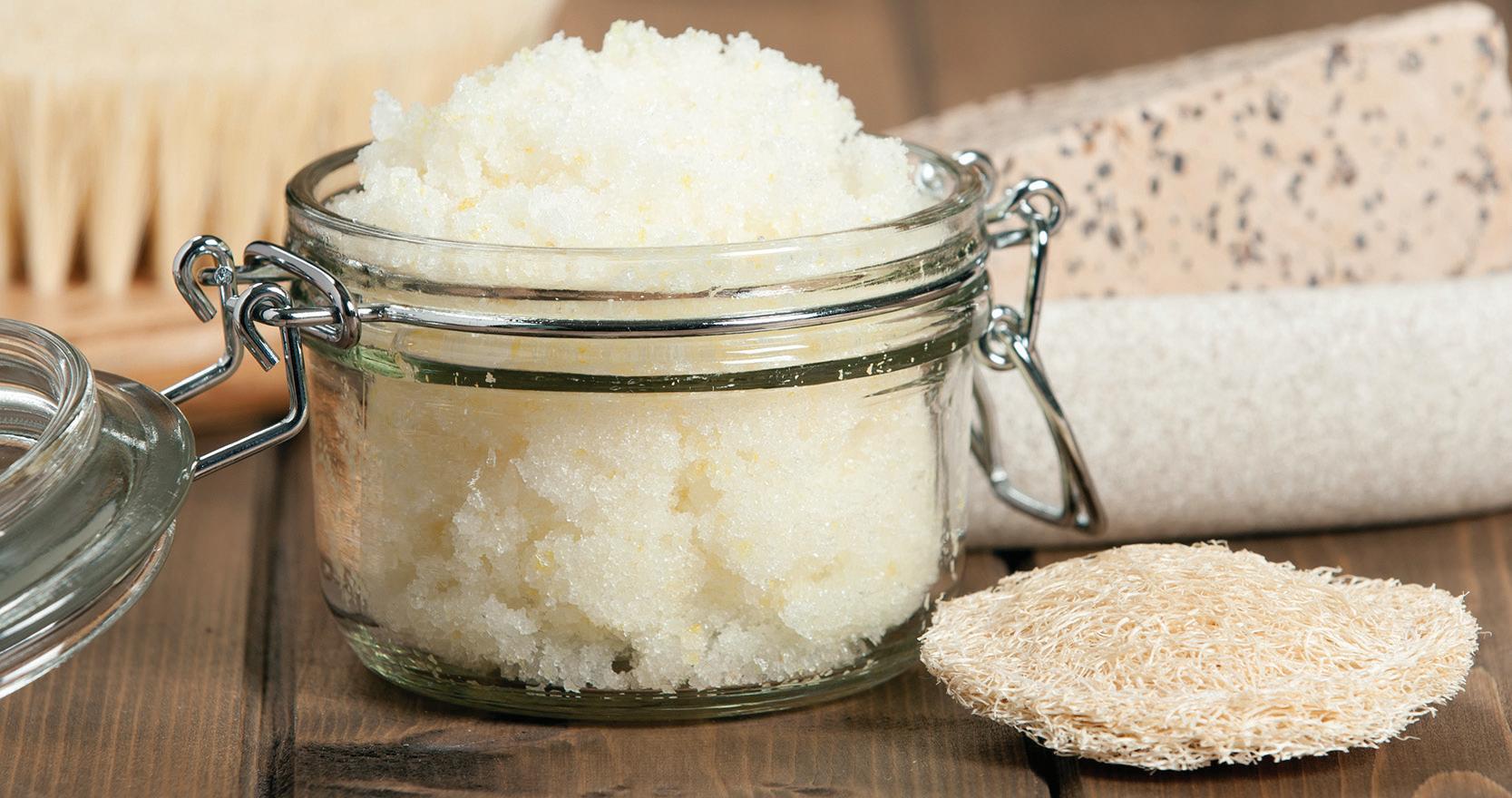
• 1 cup sea salt
• 1⁄2 cup almond, coconut, or grapeseed oil

• Several drops of essential oil (optional) Mix together all ingredients, place in a glass jar, and use in the shower for gentle exfoliation and moisturizing.
Coconut Sugar Scrub
• 1⁄2 cup coconut oil
• 1⁄2 cup sugar
• Dash of lemon zest, vanilla, or crushed dried herbs (optional)
Mix together all ingredients, place in a glass jar, and use in the shower.
Oatmeal Honey Facial Scrub
• 1⁄2 cup finely ground oatmeal
• 1⁄4 cup honey, preferably raw
• 1⁄4 cup olive, almond, or coconut oil
Mix together all ingredients. To use, gently rub into skin, let sit for a couple of minutes, and then wash off.
Anna Twitto Afula, Israel
Deer-Proof Garden

After retiring in spring of 2020, I eagerly prepared our garden area. Into our nearly 1-acre plot, I planted a variety of vegetables, including several types of pumpkins and gourds.
About 20 deer live nearby and, as you might expect, they ate every plant all the way down to the ground. My first impulse was to kill them, but I couldn’t eat that many. Don’t worry this story isn't lethal to deer. Instead, I chose to build a deer-proof fence. Over about 20 years, an area near my barns had become overgrown. The sizes of the hedge branches I removed from this area ranged from 1 to 8 inches in diameter, and up to 14 feet long.
Using a chainsaw and a pneumatic nailer, I constructed a branch fence averag-
ing 10 feet tall and 183 feet long (pictured at left). For support, and to save on nails, I used the back of one barn, the side of a second barn, and the back of a third barn to connect the fence. My only cash outlay was $27.50 for nails. All other materials and tools were already stored in the barns or growing nearby.
Inside the fence, I built 10 raised beds, one 10-foot-diameter circular bed, one seating area, and a 5-by-12-foot deck.
It’s been two years since deer have eaten my garden plants.
John Mclocklin Statham, Georgia
It's Curtains for Birds
When my blueberries and raspberries start producing, I drape them with old sheer
Country Lore Readers’ Tips to Live By f rom top : a D o B e s to C k / sunny B unny ; J ohn m C lo C klin
68 MOTHER EARTH NEWS April/May 2023
curtains to deter birds from eating the fruits before I can. This method allows sunlight and moisture to reach the shrubs. I cover them as soon as the berries begin to ripen.
Dona Snider Bloomfield, Kentucky
Sitting in the Shade
The three-season room at the rear of our house can get quite hot because of the summer sun. Closing the blinds helps, but I hate to block the light and view. To solve this problem, we built this square arbor (pictured below) about 2 feet away from the south-facing windows, and attached it to the sunroom roof for stability. Every year, we weave organic twine in different patterns and plant scarlet runner beans at the base of each string.
In early spring, we enjoy the solar heat that comes through the windows. As the

Sweet, Sweet Cuttings

Last year, sweet potato plants cost $3 a pot in my area, and slips were unavailable. So, I decided to experiment by starting some cuttings in water, some in garden soil, and some in potting soil. It didn't seem to matter which way I tried, they all did well, so I didn’t need to start slips the regular way from the tips of the sweet potatoes we ate. I rooted a Roma tomato cutting at the same time, and it also did well. I plan to root backup cuttings for the garden this same way every spring.
Karen Deichman Riverton, Illinois
growing beans climb up the strings, they shade the room and keep it much cooler. As an added bonus, the bees and hummingbirds love the bean plants’ flowers. The arbor’s distance from the windows makes it easy for us to pick the beans from either side.

At the end of the season, we just cut down the strings with the bean plants still
Her Upcycled Garden
attached, and we throw everything into the compost bin.
Jane Onspaugh Mentor, Ohio
Natural Tick Control
My Miniature Schnauzer and I average about five hikes in the woods weekly, battling ever-present ticks and gnats that
I find it wasteful to throw out clear, heavyweight shower curtains after they’ve become worn enough to warrant replacement. I wash each curtain in the washing machine in hot water with mild detergent and a cup of distilled white vinegar to cut the soap film. After the shower curtain has air-dried, I use it to cover transplants in spring, or to protect crops from frost. The sun shines through the durable curtain, providing light and warmth.
Here's another tip: I’ve had success using a laundry basket as a planter. I lined the interior sides and bottom with paper weed barrier I cut to fit. Then, I added potting mix; this kept the paper snug against the holes in the basket. The laundry basket was less costly than the metal and ceramic planters sold by garden centers, and I used it to grow a squash plant with good yield.
The photo shows how I keep my sunflowers upright as they grow tall enough to need support. One windy day, I’d forgotten to roll down the umbrella over the glass-topped patio table. The breeze caught the umbrella and tipped over the table, which shattered the glass. The circular metal frame never made it to the recycling center, because I repurposed it by scattering sunflower seeds below the frame. The sunflowers grew to a height of 8 to 10 feet and were supported by the frame.
 Melissa Ball Enfield, New Hampshire
Melissa Ball Enfield, New Hampshire
C lo C kwise from top : k aren D ei C hman ; m elissa B all ; J ane o nspaugh
www.MotherearthNews.coM 69 Country Lore
FAST & EASY STUMP REMOVAL
SmoothCutTM PTO Powered Stump Grinders
• Efficient PTO powered stump grinder makes stump removal easy.


• Easy operation from the seat of the tractor using existing tractor hydraulic controls.

• Cutting wheel design provides a smoother cutting action for higher productivity.




• Models designed for tractors 22 -50 PTO HP and 45- 100 PTO HP.
Country Lore


Awesome Blossoms
I’ve grown chives for many years, and I recently started hand-picking the blossoms for various uses. I pick them when they’re fully open, but before they start to wither. I rinse and air-dry them, and I lightly pack them into glass canning jars until the jars are half-full. Then, I fill the jar with apple cider vinegar. I let this steep in the refrigerator, shaking the jars gently once a day, and then I strain the mixture after a week or two.

I pulse the strained blossom pulp in the food processor to make chive-blossom bacon jam, loosely following an onion bacon jam recipe but substituting the blossom pulp for diced onion. The result is amazingly delicious. As an added bonus, the strained vinegar is nicely flavored (and beautifully colored) and works great as a dressing or marinade. Many people don’t know the flowers are edible, so I thought I’d share this tip that yields dual results!
Michelle Turtschin Cicero, New York
is, until my holistic vet passed on this tip for a homemade repellent made without harmful chemicals. I mix together 2 cups of water, 10 drops of clove essential oil, and 10 drops of lavender essential oil in a small spray bottle. I shake the bottle and then spray my shoes, legs, clothing, hat, and the dog (avoiding its eyes). The mixture hasn’t stained any of my clothing, probably because the essential oils are diluted with the water, and by the end of the day the scent has dissipated. One application of a slight mist keeps the gnats at bay and, as of yet this season, neither the dog nor I have had a single tick. I leave the spray bottle in the car, ready to use when we hit the trails.
Debra McNally Leominster, Massachusetts
Anti-Ant Admixture


This is a quick way to stop ants in their tracks — and it’s nontoxic. I’m happy that I’m not spraying chemicals my pets can get into.
I mix 1 tablespoon borax with enough honey to make a paste. Wherever I see ants, I put down a small square of waxed paper with some ant bait mixture on top. I’ve found putting a drop of water under the waxed paper will help it lay flat. (The less resistance for the ants, the better.) After the bugs have taken the bait, I soon see a trail of them as they carry the bait back to their nest. In a few days, they’re gone. Works like a charm!
Marisa Phillips Meadville, Pennsylvania
Brilliant Bee Boats
I noticed that bumblebees and honeybees kept drowning in my goat water tubs while trying to get a drink. So, I put small, thin pieces of cedar into the tubs so bees could land, get a drink, and take off again. These “bee boats” have greatly reduced the number of drownings!
 Trish Robbins Bonners Ferry, Idaho
Trish Robbins Bonners Ferry, Idaho
F ROM TOP : M ICHELLE T URTSCHIN ; T RISH R OBBINS DESIGNED. ENGINEERED. REMARKABLE VALUE.
Worksaver, Inc. Litchfield, IL Phone: 217.324.5973 WORKSAVER.COM See #39 on page 89
A Yarn About Yarn




















I salvaged some cotton yarn in varying lengths from a warehouse, and I use it to support pole beans in my garden. I simply tie one end of the yarn to the bottom of the bean plant’s stem, and the other end to an arbor. The yarn leads and supports the plant as it climbs to the top of the arbor.
After the growing season has ended, I take down both the yarn and bean stem and lay them down on the soil. Since it’s made of cotton, the yarn will be digested into dust. Everything returns to Mother Earth.

 Sammy Yu
Port Moody, British Columbia
Sammy Yu
Port Moody, British Columbia
Strong as an Oak

Thrifty Veggie Beds

I cut a leaky old metal water tank into 18-inch-high sections with a reciprocating saw. After filing down the rough edges and sanding off the rust, I sealed the sections with a couple of coats of paint. They’ve made fine raised beds for my garden.
Tim Wooten Cypress Mill, Texas
Meshes Well with Milkweed








































My garden is certified by the North American Butterfly Association, because it “provides resources that increase the world’s population of butterflies.” I’m 90 years old and raise monarch butterflies, but I also find I have to protect small milkweed plants and seedlings in my garden, because just one caterpillar will eat 20 leaves before progressing into the chrysalis stage.
To protect the small milkweed plants until they can get established, I cover them with mesh baskets I bought at the dollar store. The baskets fend off the monarchs so they can’t deposit eggs on
We wanted to plant food in our small front yard; however, many people walk their dogs on our street and the inevitable happens. A fence would solve this problem.

We found a free source of the oak flavor slats that vintners place in wine barrels to impart flavor to wine. Many of these beautiful wooden strips are stained a deep-purple from wine. They measure about 3 inches wide, 3 feet tall, and are an inch thick. Each already has a hole drilled about 3 inches from the top. They make perfect fence slats.
To build our fence, we used the oak flavor slats, short T-posts (found in a free pile), and heavy-gauge wire. The latter was the only item we bought. We drove the T-posts into the ground at regular intervals. Next, we threaded the flavor slats onto the wire through their existing holes, and then wove a second wire back and forth through the holes in the slats. This project produced an attractive, functional fence for a grand total of $16!
Karen Dawson Santa Rosa, California
Country Lore
F rom top : t im W ooten ; K aren D a W son
Lehman’s has the tools you need to plant your garden, plate your meals and preserve the harvest in your pantry. Shop anytime at LEHMANS.COM Kidron, OH • 800-438-5346 From Plant to Plate to Pantry
MotherEarthNews 1970-2022 Archive











Get unlimited access to all of our magazine content from 1970 to 2022 — no internet connection needed!

Packed with information about gardening, raising livestock, homesteading, and more, this will quickly become your favorite resource! Includes articles published in the magazine and online, plus blog posts.
the plants. The butterflies can still deposit eggs on my established plants, where the hatched caterpillars are free to eat all they want. Sometimes, I relent and let a caterpillar strip the leaves off a seedling. One caterpillar traveled 20 feet to a milkweed plant protected by a mesh basket. Bighearted Dominic removed the basket and let him eat.
Dominic Grillo Dunedin, Florida
Raindrops Keep Falling in His Troughs
CLASSIC
CLASSIC USB DRIVE ARCHIVE




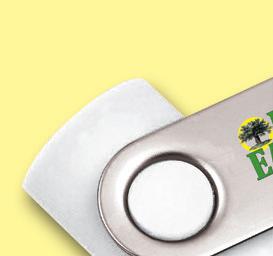

$59.95 Item #11850
Access content on Mac or PC! Conduct advanced searches and view content from the entire 53-year archive simultaneously.
MULTIPLATFORM
MULTIPLATFORM USB DRIVE ARCHIVE


Access content on desktop and laptop computers, smartphones, and many portable reading devices. Content can only be viewed and searched year by individual year.
Our large garden needs lots of water, so I avoid overburdening our well by collecting rainwater from the roof of the barn. As shown in the photo above, I set up a series of 150-gallon water troughs. Auto siphoning is used between each trough to keep the water at the same level. One pump dispatches water into the garden via a hose. As the water drops from the pumping trough, the water from the other tanks will refill it, keeping a balanced level of liquid in all tanks.

A 30-gallon tank is located on each end, with a drain faucet in case additional water
Looking Cute to Boot
is needed for summer. At the end of the season, I drain the tanks to avoid freezing over winter.
Rich Schaefer Freeburg, Illinois
We Pay for Top Tips
Do you have handy home, farm, or garden advice? We’ll pay you $25 for each tip we publish, plus another $25 if we use your photos. So, send your niftiest tips to us at Letters@MotherEarthNews.com.

Don’t toss those old boots! I’ve found an easy way to give new purpose to a worn-out pair of rain boots. Instead of tossing them in the trash, I give the boots a second life as flower planters. Upcycling in this way keeps the boots out of the landfill, and they look cute to boot (pun intended).
I used my son’s monster-themed rain boots for the pictured project. Faded and cracked from exposure, they no longer kept his little feet dry. Here’s how I turned them into flower planters.

1 I drilled a few small holes into the sole of the boots for drainage.
2 I added a thin layer of rocks and pebbles inside the bottom of the boots.
3 I filled the boots with potting soil and planted them with small, colorful flowers.
Boots make smaller planters, so the soil dries out fairly quickly. Be sure to water yours regularly. I planted mine with orange and yellow marigolds, and I watered them nearly every day. They made a nice addition to my porch!
Kristina Bouxsein-Hearn Davenport, Iowa
Promo code: MMEPANZ1





Price does not include shipping and handling.

Country Lore
F rom top : r ich S chae F er ; K ri S tina B oux S einh earn
Call
Store.MotherEarthNews.com
Order Today!
800-234-3368 or visit













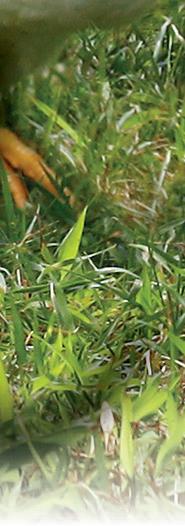
















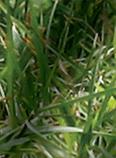




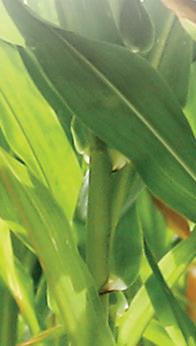





































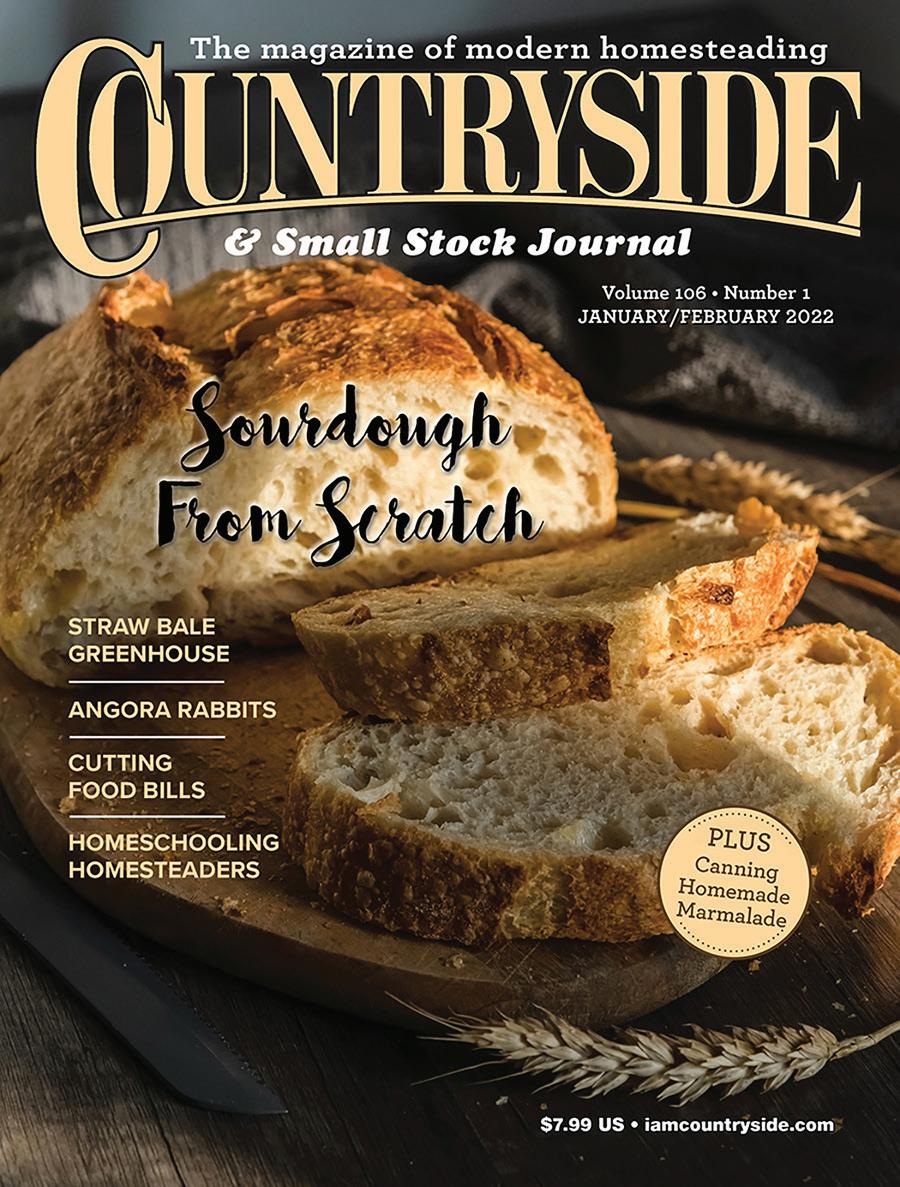
Send in the attached card or visit us online! Choose All-Access for exclusive perks, including digital access, bonus content, discounts on books and resources, and more! F�� & F�ug�� Enjoy Family-Focused C��n��� L���n� and Money-Saving DIY Projects in Every Issue! • Savory and sweet recipes • Small-scale livestock care • How to improve your harvest • Cra�s and gi�-giving ideas • Food preserva�on techniques • Tips to live off the land • Kid-friendly projects • And more! IAmCountryside.com/All-Membership Today!
RSVP
What to Do Before Buying Your First Bees
I’m all abuzz about pollinators. I’d like to venture into beekeeping; where should I begin?
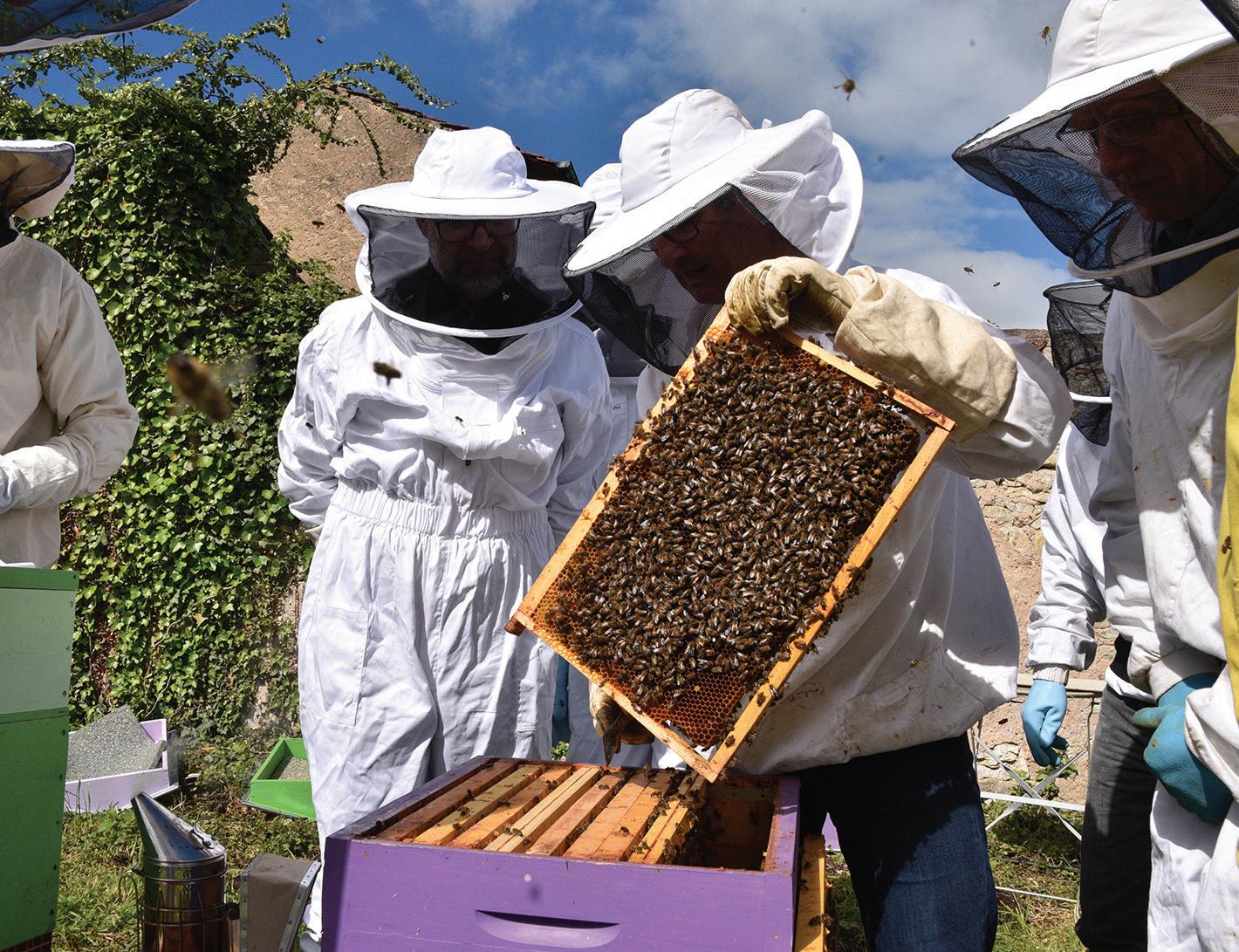
Before you run out and buy your first set of bees, take the following steps to ensure your venture into beekeeping is a success loaded with lots of honey and fun.
Attend a Beginner’s Class
Most classes for beginners are conducted by a beekeeping association. Usually, these classes are posted months in advance and range from a four-hour course to eight or more hours in length, with each covering varying amounts of information. These classes will show you what to expect before you begin handing over hardearned cash for honeybees and equipment that you may later discover you don’t want or need.
Join a Bee Club
The value of bee clubs can’t be overstated. Countless times, novice beekeepers wander into our meetings frustrated with beekeeping after only a season or two and considering giving up their hobby entirely. These folks have often never attended a bee meeting or a bee conference, and perhaps they’ve watched videos online or read a book on beekeeping. But absent from their toolbox of beekeeping skills are the community and knowledge gained from regularly attending meetings of their local bee association.
Why is a club so important? First, you’ll discover what only those beekeepers in your region can know how to keep bees in your area. Beekeeping is highly region-specific, as many factors outside the beehive affect how any colony behaves. The timing of seasonal changes, the timing of forage availability, and even the timing of farming practices all affect the timing of key beekeeping best practices as described in the literature. And timing is one key factor that can make or break your entire beekeeping adventure.
Second, at the local bee club, you’ll have an incredible opportunity to find a mentor or someone who will talk with you beyond the classroom walls to guide you as you discover your own beekeeping style. I can’t begin to tell you the number of folks who have helped me along the way, and it was at these bee associations that I met all but one of my mentors. The value of your local beekeeping association is arguably one of the most significant if you want to succeed.
Read Quality Sources
Many excellent beginner beekeeping publications are available in any format you desire hard copy, digital, and audiobooks. The information gleaned from quality resources is the foundational knowledge every beekeeper needs to keep their bees alive beyond the first season.
With these books, each novice can learn the importance of each aspect of beekeeping while simultaneously discovering the various methods that accomplish each task. Then, the local bee club can help each beekeeper learn how to correctly time and apply this information in their specific region.
Be Judicious with Videos

The internet is an excellent tool to use when first discovering the world of honeybees. In these videos, we’re allowed access into a beekeeper’s bee yard and can see what the inside of a colony looks like. We can learn how to light a smoker in three ways while discovering what a queen cell looks like. We can even see honeybee diseases up close and personal through the lens of a knowledgeable beekeeper. What we can’t see, however, is the flow of beekeeping practices that keep honeybees alive year in and year out. We can’t see that the beekeeping practices for Maine vary dramatically from those practices best used in Texas. Floridians keep bees a bit differently than beekeepers in Arkansas, partly due to small hive beetles. Dysentery is a more significant issue up north than down south, so spring and winter practices often vary for this reason.
Plus, hives in some regions require pollen supplementation to survive, while in other areas, pollen subs wipe out entire colonies in a matter of days. Use these videos in conjunction with the practices learned via your local association and science-based beginner beekeeping books, as online videos aren’t intended to be a standalone resource.
Slow Down for Success
Before buying bees, slow down and gather your information. Take the time to meet up with folks from your local bee club, visit the library and read a book or two, and take a beginner’s class while watching a few videos to see if you really want to jump into the exciting world of beekeeping. The success of your beekeeping journey depends on it.
Kristi Cook
74 MOTHER EARTH NEWS April/May 2023 Ask Our Experts
A dobe S tock / h A ppyculteur ; p A ge 75, from top : A dobe S tock / dori S oberfr A nkli S t ; A dobe S tock /S vi A tl A n A
Beekeeping classes can show novices what to expect before they invest.
The Cut Flower Garden
What are some easy-to-grow flowers I can plant and harvest with my kids?
Kid-friendly, easy-to-grow flowers include bachelor button, black-eyed Susan, celosia, cosmos, dahlia, daisy, gerbera daisy, globe amaranth, coneflower, lovelies-bleeding, marigold, nasturtium, peony, phlox, roses, snapdragon, strawflower, sunflower, and zinnia.

Gather the following supplies:
• Flower seeds of mixed sizes, colors, and bloom times
• Hand trowels and cultivators
• Watering can
• Balanced fertilizer, such as 10-10-10 or 20-20-20
• Straw and mulch materials
Planning Your Cut Flower Garden
• You can plant flowers in a garden, flower bed, or container. Plants need more than eight hours of sun with well-drained soil.
• Decide which flowers to grow.
• Plan for mature size, shape, and color.
• Look for varieties with long stems; some will need staking.
Designing with Flowers
Learn flowers’ attributes to design a beautiful, well-balanced bed or bouquet.
• Large blooms: zinnia, black-eyed Susan, sunflower, rose, Shasta daisy.
• Small blooms: bachelor button, cosmos, phlox, marigold.
• Showy blooms: celosia, snapdragon, lovelies-bleeding, grass bloom head.
• Filler flowers: baby’s breath, statice, dill flowers, queen Anne’s lace.
• Greenery: fern, dill, basil, feverfew, asparagus fern, peony leaves.
Planting
Purchase seeds early; plant after last frost. Plant seeds in rows or individual spots in the ground or in containers. Seed packets will include planting directions. If planting in the ground, prepare the seed bed by turning the soil and raking it level. Plants transplanted in the ground will need water immediately.
After seeding, cover with a light layer of straw to protect from heavy rain.
Maintenance
• Thin newly emerged plants if too thick.
• Supplement with water as needed.
• Fertilize twice a month with a wellbalanced fertilizer.
• Add 2 to 4 inches of mulch when plants are 6 inches tall.
• Remove dead blooms to promote longer blooming.
• Keep weeds out of the flower bed.
• Stake flowering plants as needed.
Harvesting Tips
• Harvest in the coolest part of the day.
• Select blooms half to three-quarters open; avoid blooms that are shriveling, fading, curling, or falling off; avoid peak bloom time.
• Carry a bucket of water in which to place the stems; keep in shade.
• Always use a sharp, clean knife or a pair of scissors to make a smooth, even cut.
• Cut long stems (5 to 18 inches long); cut stems several inches longer than needed.
• Remove foliage below the water line; foliage left in the water causes bacteria to grow and clouds the water.
• Consider using flowers and foliage from trees and shrubs for filler and greenery.
• Keep stems in water while designing.
• Use floral preservative for longer life.
Flower Arranging
Finally, creatively arrange your flowers in a vase. You’ll need scissors or a knife, vases full of water, and a floral preservative (optional).
1 Gather supplies and select flowers.
2 Fill vase half-full of water.
3 As you select stems, remove any foliage that will be below the water line.
4 Recut stems at a diagonal, as this will allow for a larger surface area and greater absorption of water.
5 Start by placing 6 to 8 stems of greenery in a criss-cross fashion to create the base.
6 Select large flowers as focal points and measure the flowers against the vase to know where to cut the stems. Stagger the height to fill the vase and create an eye-catching design.
7 Fill in with smaller, secondary flowers.
8 Add filler to soften the open spaces and round out the arrangement.
9 Replace water every other day and use floral preservative if needed.
Donna Aufdenberg; excerpt from the University of Missouri Extension publication YM103, “The Cut Flower Garden,” www.Extension.Missouri.edu
Is Galvanized Wire Safe?
I’ve read conflicting advice about whether using galvanized wire in gardens is safe; some sources indicate high lead and mercury content. What’s a safe solution for fencing an organic garden?
You’re right to be concerned. Lead and mercury are quite toxic. I’ve similarly encountered a writeup from an author who tested soil levels beneath galvanized steel and found that it contained higher levels of lead than soil on the same property but away from the steel.

www.MotherearthNews.coM 75 c redit
Though steel is made of iron, lead and mercury become involved during the galvanizing process, whether through hot-dip or electro-galvanizing procedures. So, almost any galvanized metal will contain at least some lead, though the mercury evaporates above 375 degrees Celsius. (Galvanizing takes place at 450 degrees Celsius.)





























































Protection agencies have become aware of the lead persisting through this process. The 2006 Restriction of Hazardous Substances Directive indicates a maximum concentration of lead at 0.1% of material weight. However, steel galvanization puts the lead amount outside this scope, so a lead exemption (made in May 2010) allows lead up to 0.35% for galvanized steel. (If the product is sold in California, the label must state whether it contains lead.)
Though plants don’t transport every soil-persistent chemical and element, they do transport lead. But how much transfers into fruits and vegetables? That depends on the plant. Often, soil contamination manifests in plant damage before the vegetables become toxic to humans. That doesn’t apply to lead. Soil levels have to exceed 1,000 ppm before apples and grapes show any damage but that doesn’t mean those fruits won’t harm humans, who are more sensitive to lead exposure than plants are.



So, you’re probably already considering forgoing galvanized steel within your gardens or livestock and pet areas. Thankfully, you do have some alternatives:


Vinyl-coated wire provides a polymer coating to the galvanized steel. These polymers are effective when sealing lead paint. However, water may eventually cause the polymer to separate from the steel.















Rabbits and squirrels can chew through plastic fencing, though it may deter them for a while. But plastic isn’t environmentally sustainable, and its manufacturing process involves other issues you may not wish to support, such as the use of fossil fuels.
Stainless-steel fencing, though the most expensive, is the safest metal that avoids leaching toxins into soil or water. It’s also durable; some people have reported finding stainless-steel hardware cloth intact after 30 years.





We hope this helps you make the best material choice to protect your hard-earned produce from opportunistic critters!





 Marissa Ames
Marissa Ames
Ask Our Experts 76 MOTHER EARTH NEWS April/May 2023
neseed.com NESEED 122 Park Ave. East Hartford, CT p. (800) 825-5477 f. (877) 229-8487 info@neseed.com Free USA ground seed shipping over $174.99 10% discount on seed orders over $999.99 Great USA ground seed shipping rates a NO GMO seed company. Cascadia Snap Pea vines are semibush which produce an abundance of 3” plump, crunchy and sweet pods. Good disease resistance makes Cascadia a good choice for summer to fall planting as well as spring. Resistant to PM and PRMV. 60 days. Cascadia Snap Pea For growers of any size. $90! Enter for a chance to win this prize package valued at No purchase necessary. A purchase will not increase your chances of winning. Open to legal residents of the continental United States (excluding Hawaii). Entrants must be 18 years of age or older. Sweepstakes begins 01/12/2023 and ends 05/29/2023. See o cial rules online at https://backyardbeekeeping.iamcountryside.com/sweepstakes/beginner-beekeeping I Sponsor: Backyard Beekeeping, 1503 SW 42nd St., Topeka, KS 66609. backyardbeekeeping.iamcountryside.com/sweepstakes/beginner-beekeeping More details online! SWP_BB01 Beginner Beekeeping_1.6h 1 2/9/2023 1:47:35 PM See #24 on page 89
In today’s world, stress and anxiety seem to be constant companions on our life journeys. What can we do about the crushing burdens both place on us?





Author Suzanne Tabert turns to the plants.





Within these pages, Suzanne discusses the benefits of 11 plants — ashwagandha, chamomile, hawthorn, lavender, lemon balm, motherwort, mugwort, nettles, oats, reishi mushrooms, and violets — and offers ways for us to use these remedies to lessen our anxiety about modern life.

The plant world freely provides humans with myriad ways to treat any number of illnesses and conditions that plague us. Delve into what the plants offer, and you will discover the means of bettering your life and the life of your family.

































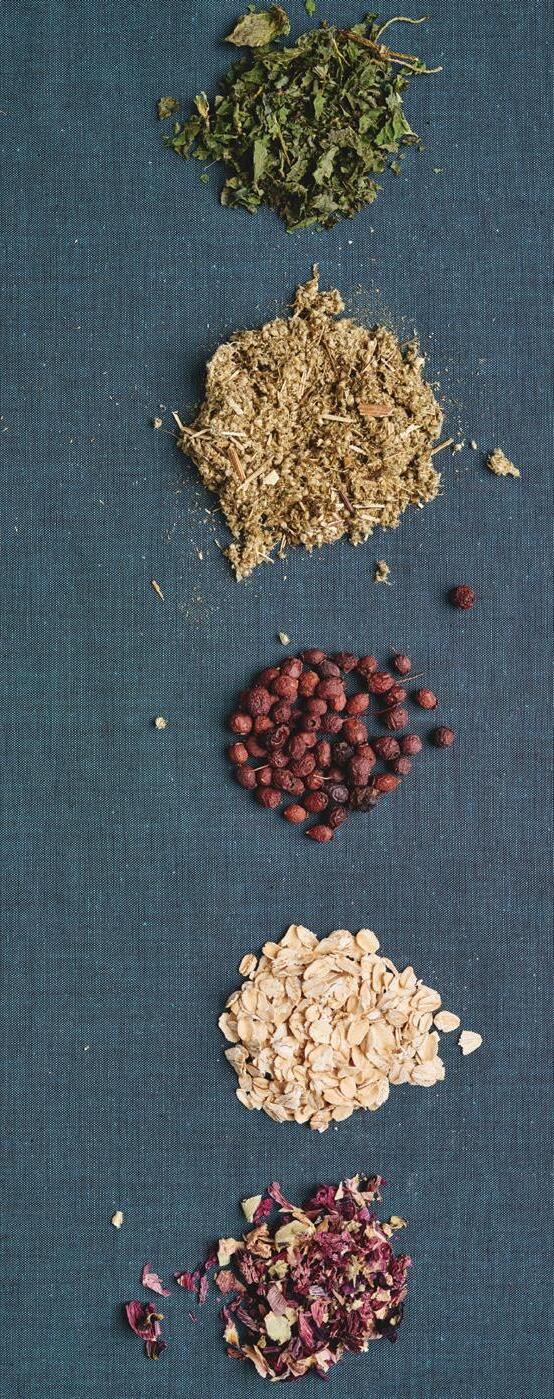
Item # 11842 $17.99















































NATURE’S RITE
#22 on page 89 Order today by calling 800-234-3368 or visiting Store.MotherEarthNews.com
code: MMEPANZ2
See
Promo
Quest for Calm_1.2_MEN.indd 1 2/10/2023 12:13:02 PM (A) Antimicrobial for lower respiratory relief (B) Relieve a sore throat by addressing the cause (C) Clean & protect nasal passages Natural Protection from Respiratory Issues 20% OFF CODE SINUS22 100% SATIS FACTION GUAR A NTEED MONEY BACK MyNaturesRite.com 800-99 1-7088 A B C Call us to receive your FREE HealthCare ToolKit book!
Natural Remedies to Create Resilient Emotional Health
Gardening

MYSOIL TEST KIT

MySoil® soil test kit is a Patent Pending start-to-finish solution for the DIY & professional community. MySoil's team has successfully combined predictive soil testing technologies with an easy-to-use customer experience that assists in improving soil and plant health while effortlessly guiding sustainable practices. Their goal is to guide users in perfecting their soil to grow the healthiest plants possible.
#11701 $34.99 Member: $29.99
WOMANSWORK DIGGER GLOVES: GREEN, PINK, YELLOW, OR PURPLE


These best-selling garden gloves are doubly reinforced at the fingertips, so they hold up to lots of digging in the garden and look good even after repeated washings. Palm is lightly padded for extra comfort. A more extended cuff with velcro wrist closure gives the gloves a snug fit and keeps soil from getting inside. These multi-purpose “Digger” gloves offer agility and protection for all your chores.
Green: S 11653; M 11654; L 11655
Magenta: S 11656; M 11657; L 11658















Purple: S 11659; M 11660; L 11661
Teal Blue: S 11662; M 11663; L 11664 $19.95 Member: $18.95
LET'S WILDFLOWER THE WORLD
This is an exciting introduction to the global seed-swapping and grassroots gardening movement, exploring how we can rewild the world around us with beautiful wildflowers. Featured is an invaluable directory of all the best seeds to save and swap, alongside essential seed bomb recipes to transform concrete oases into colorful wildlife havens. You'll also find additional husbandry and harvesting techniques and a step-by-step guide to creating your own seed bank.


BEST SELLER
#11877 $20.00 Member: $16.99

THE BASIC GARDEN TOOL

The Basic Garden Tool is a multipurpose tool that makes working around your yard and garden beds easier and faster. Made with the everyday gardener in mind, its triangle-shaped head and open interior minimizes dirt movement. Its high-carbon, USA steel-tempered head allows for digging through rocks, the sawtooth front and back edges cut through plant material like nothing else, and the ergonomically designed and balanced NW-ash handle makes for comfortable hand placement. This is a garden tool you can use for years to come. Each tool comes with a free pair of gloves to reduce impact while weeding! Please allow two weeks for shipping. Available for shipment to U.S. continental addresses only.
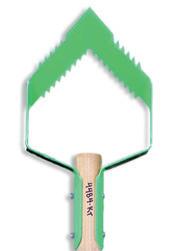
Short #8483 $77.00 Member: $69.99

Regular #8485 $77.00 Member: $69.99
Long #8487 $77.00 Member: $69.99
X-long #8489 $77.00 Member: $69.99
78 MOTHER EARTH NEWS April/May 2023


CERTIFIED ORGANIC WORM CASTINGS






If you want to have rich, nutritious soil for plants, it’s crucial to use high-quality, organic compost! Your plants are going to love this organic compost, and you are going to enjoy a fruitful, prosperous garden! Please allow two weeks for delivery. Available for shipment to continental U.S. addresses only.
BEST SELLER
3 LB Bag #9714 $19.99
10 LB Bag #9715 $29.99
15 LB Box #10147 $39.99
BEST SELLER
BACKYARD PHARMACY

COOL FLOWERS
COOL FLOWERS
In Cool Flowers Lisa Zeigler introduces us to the best growing techniques for annual flowers. Plant them in the right spot at the right time, nestle their roots deep into rich organic soil, and stand back. In no time at all, you’ll have a low-maintenance, vibrant spring flower garden that keeps on blooming when other are dead and gone.

In Cool Flowers Lisa Zeigler introduces us to the best growing techniques for annual flowers. Plant them in the right spot at the right time, nestle their roots deep into rich organic soil, and stand back. In no time at all, you’ll have a low-maintenance, vibrant spring flower garden that keeps on blooming when other annuals are dead and gone.
#7368 $22.95 Member: $20.95
GARDEN GIANT/KING STRAPHORIA MUSHROOM KIT
GARDEN GIANT/KING STRAPHORIA MUSHROOM KIT
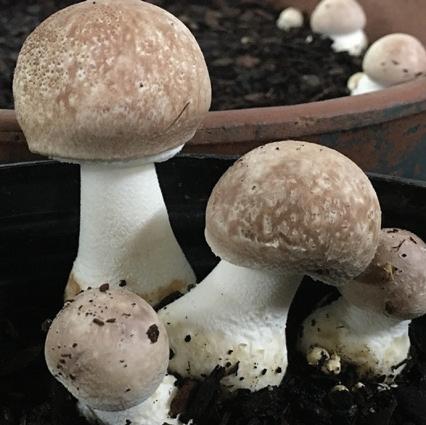

One of the easiest mushrooms to grow beginners, this 5-pound package of Garden Giant is perfect to how to cultivate in hardwood chip beds or mulch. Even better is the ease of identification: Nothing else looks like it! It quickly colonizes wood chips and fruits a little in the spring, and typically yields a bumper crop in the fall. It can also grow indoors on pasteurized straw cased with soil. The mushroom tastes like potatoes cooked in a mild red wine sauce.
One of the easiest mushrooms to grow for beginners, this 5-pound package of Garden Giant is perfect to learn how to cultivate in hardwood chip beds or mulch. Even better is the ease of identification: Nothing else looks like it! It quickly colonizes wood chips and fruits a little in the spring, and typically yields a bumper crop in the fall. It can also grow indoors on pasteurized straw cased with soil. The mushroom tastes like potatoes cooked in a mild red wine sauce.
This compact yet complete guide to herbal medicines shows you how to transform common plants into healing remedies. While using herbs as medicines can often seem complicated or costly, the Backyard Pharmacy offers a way to learn that's simple, effective, and low-cost. You’ll find solutions for common ailments such as mosquito bites, inflammation, insomnia, flu symptoms, and more. Match the properties of each plant to your own medicinal needs.


#11876 $21.99 Member: $18.99
#8019 $25.00 Member: $23.99
#8019 $25.00 Member: $23.99
NEW!
BEST SELLER NEW! NEW!
#7368 $22.95 Member: $20.95
KILNER BUTTER CHURNER

The Kilner butter churner offers the easy way to make homemade butter! Simply place heavy whipping cream into the butter churner, turn the handle, and in no time you can enjoy fresh and delicious butter. The churner can hold up to 34 fluid ounces and comes with recipes! It measures 4.3 inches wide by 10.6 inches high by 6.5 inches long, and is hand wash only.
#8994 $55.00 Member: $49.99
Real Food & Cooking
MEALS IN A JAR

Meals in a Jar provides the step-by-step, detailed instructions needed to create all-natural breakfast, lunch and dinner options that you can keep on a shelf and enjoy at any time. These scrumptious recipes allow even the most inexperienced chefs to serve gourmet dishes. Not only are these meals perfect for everyday events like camping trips, after-school study sessions and rushed evenings, but they can also be lifesavers in times of disasters like fires, blackouts, or hurricanes.
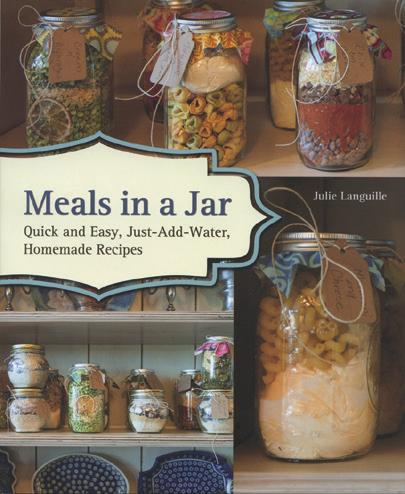
#6657 $15.95 Member: $14.95
BEST SELLER
#10 CAST ALUMINUM CLAMP-ON GRINDER

FLAVORED BUTTERS
FLAVORED BUTTERS
Lucy Vaserfirer's Flavored Butters provides the recipes and techniques for homemade flavored butters. In 50 recipes, she offers up ideas that are amazingly quick to execute in the kitchen and transformative in the flavor they impart. The recipes cover both sweet and savory applications, and each includes advice about what the butter is best used on. Plenty of photographs illustrate the recipes, and you’ll also find ample tips and tricks.
Lucy Vaserfirer's Flavored Butters provides the recipes and techniques for homemade flavored butters. In 50 recipes, she offers up ideas that are amazingly to execute in the kitchen and transformative in the flavor they impart. The recipes cover both and savory applications, and each includes advice about what the butter is best used on. Plenty of photographs illustrate the recipes, and you’ll also find ample tips and tricks.

7-1/2" MEAT SLICER



The #10 clamp-on hand grinder has a 3 3/8" x 4" hopper opening and the clamp opening is 1 1/2". This grinder comes with a coarse (3/8") and a fine (3/16") carbon steel grinding plate and a carbon steel grinding knife. Crafted of cast aluminum and wellmade for long-lasting service.

#11640 $39.99 Member: $34.99
#10682 $14.99 Member: $12.99
#10682 $14.99 Member: $12.99


FABULOUS RECIPES FOR VIBRANT HEALTH

From breakfast to dessert, the recipes collected in Fabulous Recipes for Vibrant Health promote energy, vitality, and longevity. Janet M. McKee has spent years figuring out the balance between healthy and delicious eating, which has resulted in this collection of more than 100 recipes. Ranging from smoothies to pasta primavera, this cookbook recognizes that eating well and living healthy are both important, and its guidance will help you find that balance.
#9057 $30.00 Member: $24.99
THE COMPLETE GUIDE TO SMOKING AND SALT CURING
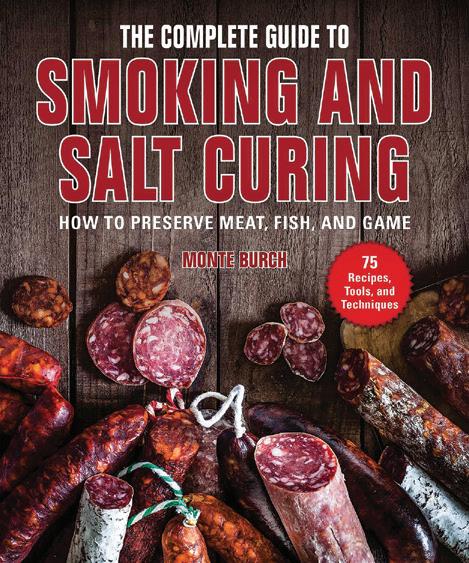
Smoke and cure everything from store-bought meats to freshly harvested fish and game. With full-color photographs and clear instructions on how to select meats and avoid contamination, this complete guide will teach you how to choose smokers, use various tools, and prepare recipes for rubs, sauces, bacon, and more.
#9967 $17.99 Member: $14.99
This 7½-inch Meat Slicer is small but mighty. With the powerful 200-watt motor, you can precisely slice deli meats, steaks, and everything in between. Featuring adjustable thickness settings, a stainless steel rotary blade, a smooth gliding carriage, and a countertop footprint of 14½ inches across and only 9 inches deep, the slicer can easily be stored in any home kitchen!

#9776 $99.99 Member: $89.99
THE BARBECUE! BIBLE

Redesigned inside and out, The Barbecue! Bible now includes full-color photographs illustrating food preparation, grilling techniques, ingredients, and those irresistible finished dishes. A section has been added with answers to the most frequently asked grilling questions, plus the author's proven tips, quick solutions to common mistakes and more. Also featured is over 500 of the very best barbecue recipes from around the world.
#11603 $24.95 Member: $21.95
THE CHICKEN BIBLE

Chicken is the go-anywhere, eat-with-anything, highly transformable crowd favorite that always fills the bill. Find exactly what you’re looking for (and more!) with a wide breadth of themed chapters, including Easy Dinners, Classic Braises, Breaded and Fried, Pasta and Noodles, and more. With over 500 recipes included, you could eat chicken every night and never tire of it.
#10779 $40.00 Member: $34.00






TO ORDER, CALL TOLL-FREE 800-234-3368 (OUTSIDE U.S.: 785-274-4365) or visit Store.MotherEarthNews.com


TO ORDER, CALL TOLL-FREE 800-234-3368 (OUTSIDE U.S.: 785-274-4365) or visit Store.MotherEarthNews.com Mention Promo Code: MMEPANZB • Sale Ends 05/15/2023
Mention Promo Code: MMEPANZB • Sale Ends 05/15/2023
BEST SELLER BEST SELLER www.MotherearthNews.coM 79
MOTHER EARTH NEWS FIRST EDITION T-SHIRT



The art on this shirt is the magazine cover of the first ever MOTHER EARTH NEWS magazine edition from 1970. This unisex fit
shirt is 100% Airlume combed and ring-spun cotton, with side seams, shoulder taping, and a tear-away label.


S #11859 $14.99 Member: $13.99

M #11860 $14.99 Member: $13.99

L #11861 $14.99 Member: $13.99



TAPPING INTO WATER
This book reintroduces readers to the lost art of affordable, do-ityourself well drilling. You will learn how to utilize common materials for the fabrication of percussion bits, sludging pipes, bailer valves, casings, screens, and much more. Step-by-step instructions on how to rig and operate these low-tech drilling devices for creating your own personal water well (up to 100 feet deep) are also included.

#9694 $15.95 Member: $14.95

BEST SELLER
Prepper


BEST SELLER NEW!
365 ESSENTIAL SURVIVAL SKILLS


365 Essential Survival Skills comprises the best knowledge, tips, and tricks available in the world today, and each skill is explained in fun, easy-to-learn ways that any student (greenhorn or seasoned) will pick up with a little practice. With 365 skills inside this book, there's plenty of practice to keep you busy year-round.

#8249 $19.99 Member: $16.99
Herbal Health



BEST SELLER
THE HERBAL APOTHECARY Incorporating traditional wisdom and scientific information, The Herbal Apothecary includes advice on growing and foraging for healing plants, as well as recommendations for plant-based formulations to fight common ailments. Step-by-step instructions show you how to make your own teas, salves, and more.

#7705 $24.95 Member: $20.95
XL #11862 $14.99 Member: $13.99
2XL #11863 $16.99 Member:$13.99

3XL #11864 $17.99 Member:$16.99





A full-color introductory guide to providing a flock of chickens with their very own digs, Starter Coops addresses the needs of every chicken owner. From planning for the future coop and purchasing the needed tools and materials to the actual construction, this book offers detailed step-bystep instructions to the beginning keeper. Color drawings assist the reader with building a confined coop, chicken tractor, and more.

#11858 $14.95
Member: $13.95









THE NEW 5-GALLON BUCKET BOOK
THE NEW 5-GALLON BUCKET BOOK

LIVING OFF THE GRID

The New 5-Gallon Bucket Book updates a quirky classic with dozens of new ways to take those old buckets and put them to use. With common tools and the instructions in this book, you'll find 60+ ideas and projects to make today. Connect with your inner engineer as you make a shoe rack, washtub bass, boat anchor, walking water can, and more. Simple step-by-step instructions make sure you will have fun and love the results of your work.
The New 5-Gallon Bucket Book updates a quirky classic with dozens of new ways to take those old buckets and put them to use. With common tools and the instructions in this book, you'll find 60+ ideas and projects to make today. Connect with your inner engineer as you make a shoe rack, washtub bass, boat anchor, walking water can, and more. Simple step-by-step instructions make sure you will have fun and love the results of your work.
#11870 $24.99 Member: $21.99
#11870 $24.99 Member: $21.99

BEST SELLER
Dave Black describes alternatives for ecopimping your home and lifestyle for independence, economy, and a more integrated way of life. Equally valuable for the urban dweller vaguely concerned about the size of his or her carbon footprint and the rural self-sufficiency enthusiast, Living Off the Grid can help anyone take control of his or her life and way of living.
#8546 $12.95 Member: $10.95
THE LOST BOOK OF HERBAL REMEDIES

The lost knowledge of herbal remedies goes against the grain of mainstream medicine and avoids just dealing with symptoms. The Lost Book of Herbal Remedies targets the underlying root cause and strengthens your body's natural ability to repair itself. With the medicinal herbal reference guide included, it’s very easy to look up your own condition and see exactly which herbs and remedies can help.
#10469 $37.00 Member: $31.99





MICROSHELTERS
MICROSHELTERS








If you dream of living in a tiny house, or creating a getaway in the backwoods or your backyard, you’ll love this gorgeous collection of creative and inspiring ideas for tiny houses, cabins, forts, studios and other microshelters. Microshelters shows 59 unique and innovative structures, with full-color photographs, and additional plans for six different structures, to help you build your very own tiny structure!
BEST SELLER

If you dream of living in a tiny house, or creating a getaway in the backwoods or your backyard, you’ll love this gorgeous collection of creative and inspiring ideas for tiny houses, cabins, forts, studios and other microshelters. Microshelters shows 59 unique and innovative structures, with full-color photographs, and additional plans for six different structures, to help you build your very own tiny structure!

#7812 $18.95 Member: $16.95
#7812 $18.95 Member: $16.95
DIY
NEW!
NEW!
80 MOTHER EARTH NEWS April/May 2023
ADVENTURES IN AGRITOURISM


In Adventures in Agritourism, author and agritourism farmer Matt Stephens talks with six other agritourism farmers as they examine the realities and hard work involved in creating an agritourism component to help keep a small farm and an agriculture dream alive. Time to turn the page to take a step toward making your agritourism adventure a reality!
#11910 $17.99
Member: $14.99





COUNTRY WISDOM & KNOW-HOW
COUNTRY WISDOM & KNOW-HOW
THE SELF-SUFFICIENT BACKYARD
From growing your own food year-round to generating electricity from solar and wind, The Self-Sufficient Backyard shares over 100 practical DIY projects for your land whether it's an acre or just a small backyard! This book is a must-have for anyone interested in going off-the grid or just saving and making some money on their own property.

#10544 $39.99 Member: $33.99






A FIELD GUIDE TO BACKYARD BIRDS OF NORTH AMERICA

Country Wisdom & Know-How is an unprecedented collection of information on nearly 200 individual topics of country and self-sustainable living.





Nearly 1,000 black-and-white illustrations and photographs run throughout, and fascinating projects and trusted advice crowd every page.
Country Wisdom & Know-How is an unprecedented collection of information on nearly 200 individual topics of country and self-sustainable living. Nearly 1,000 black-and-white illustrations and photographs run throughout, and fascinating projects and trusted advice crowd every page.

#8219 $25.99 Member: $21.99
#8219 $25.99 Member: $21.99
ECO KIDS SELF-SUFFICIENCY HANDBOOK










By combining creativity with ecoawareness, this timely book encourages children to put down their mobile devices and get involved. From building a wind turbine and a go-kart to creating light and making green gifts, Eco Kids Self-Sufficiency Handbook offers a wide range of ways to capture the imagination and positively contribute to the world around us. With easy-to-follow step-by-step instructions and photographs—and a little adult supervision—no project is too difficult for children to complete! Ages 7-14.
#11871 $14.99 Member: $12.99
RAISE BACKYARD CHICKENS
Raise Backyard Chickens helps get you started with everything from incubating fertile eggs to receiving and raising day-old chicks to building a chicken coop to keeping your birds safe and healthy. You’ll find top-notch advice on how to protect your flock from predators, produce the healthiest eggs, and so much more.
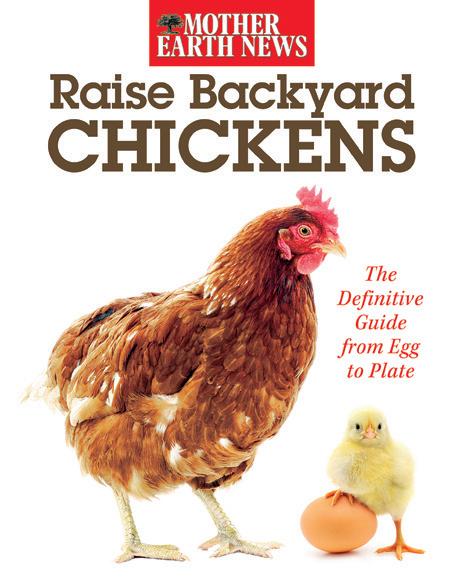
#8871 $24.95 Member: $19.95
Whether you’re just getting started birding or want to build on your existing knowledge, this handbook provides you with all you need, making it the companion in the field. Inside this gorgeously illustrated guide, you’ll find a fascinating introduction to the world of birds, an exquisite logbook, a comprehensive catalog of the most commonly seen birds in the US, and more. Sized perfectly to fit into a shoulder bag next to your binoculars, this guidebook is the one you won’t want to leave home without.
#11816 $16.99 Member: $14.99
COMPACT FARMS



Small-scale farmers can have big-time success. Compact Farms is an illustrated guide for anyone dreaming of starting, expanding, or perfecting a profitable farming enterprise on 5 acres or less. The farm plans explain how to harness an area’s water supply, orientation, and geography in order to maximize efficiency and productivity while minimizing effort. These real-life plans and down-and-dirty advice will equip you with everything you need to actually realize your farm dreams.

#8189 $19.95 Member: $16.95
Livestock

RAISE BACKYARD CHICKENS

In Raise Backyard Bees, you will find beekeeping information on building beehives, installing bees in the hive, gathering up a swarm, breeding queen bees, caring for your bees, harvesting honey, and processing honey for sale.


#9039 $24.95 Member: $19.95
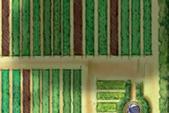
TO ORDER, CALL TOLL-FREE 800-234-3368 (OUTSIDE U.S.: 785-274-4365) or visit Store.MotherEarthNews.com Mention Promo Code: MMEPANZB • Sale Ends 05/15/2023
TO ORDER, CALL TOLL-FREE 800-234-3368 (OUTSIDE U.S.: 785-274-4365) or visit Store.MotherEarthNews.com Mention Promo Code: MMEPANZB • Sale Ends 05/15/2023
Homesteading Kids NEW!
BEST SELLER BEST SELLER NEW! BEST SELLER www.MotherearthNews.coM 81
BEST SELLER
(CONTINUED FROM PAGE 6)


some measurements and found that the stove was sucking more heat out of the house than it was putting in. This was forced-air heat — not the water-based outdoor heating units. So we gave up on that and gave the furnace to a friend.



A few years ago, we repurposed the shed into a garden shed by putting in a door and using some recycled barn board on the front exterior.
The majority of the materials used in updating the shed are reused or recycled, such as the barn board and the green door, which came from a friend when they remodeled their home, and I painted it a fun color.

The shed has an attached greenhouse on the back that used storm windows donated by the same friend.
We used scrap lumber to add the window box, and the window itself came home from my guy’s part-time job at a local lumberyard. It’s a salesman sample. Plus, we had the weather vane, the “shutters,” and the deer rack above the door. Our 2,000-square-foot garden is just out of frame next to the shed.
I store my garden tools in the shed, which also has a small woodstove. We use the greenhouse section to start our plants in spring.

We’ve fired up the woodstove in winter, and picked and cracked walnuts from the huge walnut tree in the yard. I can see

the shed out my dining room window, and it still makes me smile!
Mary Hyland Iowa

Coracle Comments


Your article on coracles (“Take to the River in a Coracle,” December 2022/ January 2023) was a well-written article on a type of (mini) watercraft most have never heard of. I really appreciated the concise style of writing with personal touches and excellent photos.
It’s always nice to see a fine writer from Wales get published here. I hope she’ll submit many more stories. Thank you for many years of wonderful and informative reading.
Joel Monteith Via email

Oregano Oil
I’ve been a subscriber for years and read the magazine from cover to cover. I was suffering with a constant cough. Then, I saw Patricia Rife-Beaver’s “Curbing Coughs” in Country Lore (December 2022/January 2023) regarding oregano oil.



A friend of mine also knew about this oil, and it stopped her cough as well. I purchased some, and within a week, my cough was totally gone. Thanks again, MOTHER EARTH NEWS.
James Vidal Angus, Ontario
Dear MOTHER
New
R ICK F RIDAY See #26 on page 89
coop lights!
Take a Page from the Past
A previous letter spoke of the need for reasonable clothes for those trying to live off-grid. Granted, fabric and patterns are expensive, but we need to take a page from the past: Reuse clothing or use what I call “found materials.”


If a garment is worn, cut where all fabric is intact and reuse existing seams where feasible. Old sheets and drapes are good sources of fabric.
One thing to watch for is synthetic fabrics, such as polyester or spandex: These melt instead of burn, so be careful if you use them around open flames.

A good source for crafting is plain plastic yarn you make from plastic bags. Again, it won’t withstand heat but is good for bags and mats.
Memories of Canning
My story is about enjoying home canning over my 81 years. I watched my mother canning. She didn’t have water or electricity, and she cooked on an old woodstove. She had a lot of old, blue jars and zinc lids. All of her stuff turned out great.

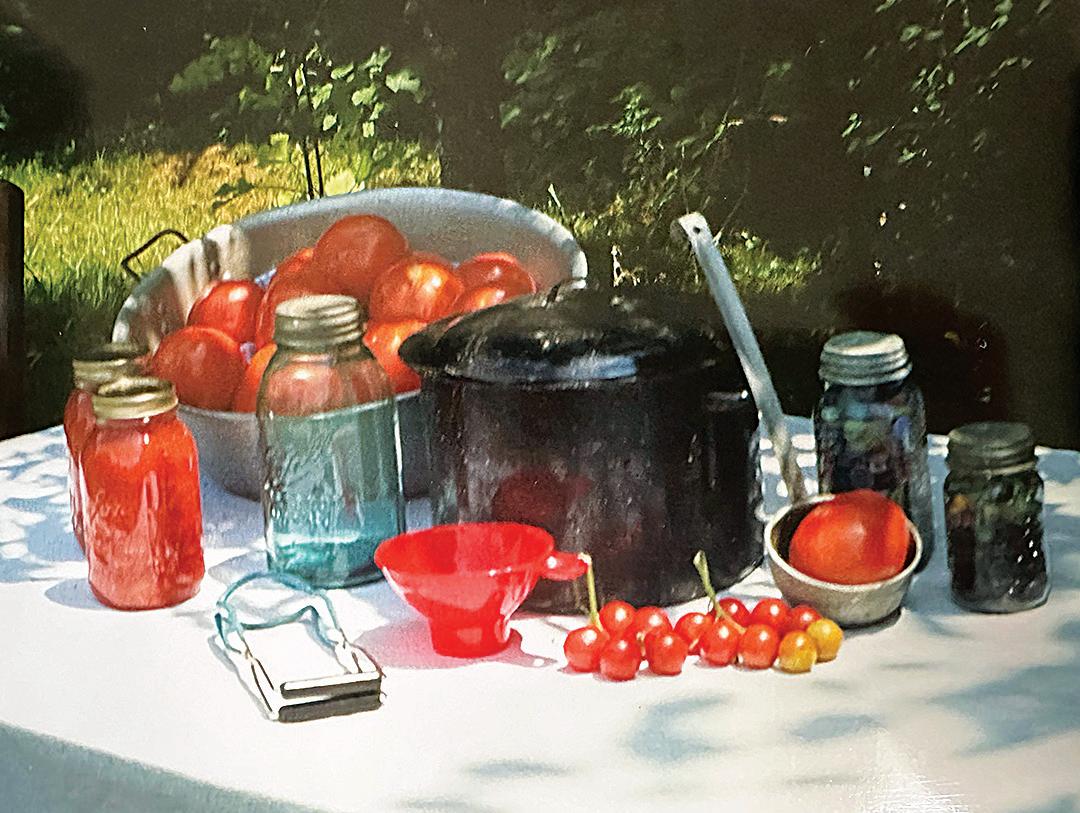

Even after 81 years, I still love to hear the “pop” of the lids sealing. It’s how you know you’ve done everything right. After they’ve sealed, you never want to hear that sound again, because if anything goes wrong, you hear the same “pop,” and the lid unseals. I’ve always had good luck, but my daughter lost all her green beans. She just had to sit and listen to every jar unseal. Not music to your ears.
 Carolyn Watts Adairville, Kentucky
Carolyn Watts Adairville, Kentucky
Dear MOTHER
WWW.MOTHEREARTHNEWS.COM 83 C AROLYN W ATTST
Make more compost with the Mantis ComposT-Twin, a large-capacity, dual-bin compost tumbler. 24.8 cubic feet of black gold!
AERATOR DETHATCHER EDGER
PLOW CULTIVATOR TILLER
mantis.com
for
See #34 on page 89 See #19 on page 89
The 16” Mantis XP Tiller gets more done! Easily converts to a yard tool with optional attachments.
Mantis Products:
your large spaces
days

Thrift stores and yard sales are good sources of used patterns and clothes. I once made a dress for my daughter from a used dress. The fabric from the skirt was enough for a dress.
P. Kiser Via mail
Uncle Jack
My uncle Jack Reed in Missouri would sometimes go out at 2 a.m. in the snow if he knew a calf might be born, and then bring it in to his kitchen to keep it from freezing. He had a woodburning heater and would wrap the newborn in a blanket and bottle-feed it when necessary. He was in his 80s and lived in the same place from 1936 until he passed.
Doug Reed Templeton, California
A Gift in My Mailbox
Your magazine feels like a gift each time I find it in my mailbox. As a farm girl transplant to the city, MotheR eaRth news magazine keeps me connected to my most durable values of love for the Earth, health and well-being, and frugality and practicality. I wanted to show you how my cat, Frankie, found a second use for your grocery bag. On winter days, he’s trolling for indoor adventure. Thanks for your solid, centered voice in the midst of uncertain times.
 Ruth Johnston Via email
Ruth Johnston Via email








Dear Mother
84 MOTHER EARTH NEWS April/May 2023 R uth J ohnston
Commercial Grade All Day Power User Friendly Planet Friendly Find a Dealer at: meangreenproducts.com TAX C $REDITELIG IBLE COMMERCIAL GRADE. ALL DAY POWER. See #18 on page 89 THOUSANDS of products EXCLUSIVE online sales SIX RETAIL locations CUSTOMER SERVICE for all your needs 800-720-1134 STROMBERGSCHICKENS.COM Sign up on our site for alerts on pre-orders and special deals on your next flock! chick
Pre-Order Your Chicks Now! Pickup on location at Mann Lake stores Sign up on our site for alerts on pre-orders and special deals on your next flock! StrombergsChickDays 4.5x4.5.indd 1 2/13/23 7:34 AM
Your uncle sounds like a hard-working and compassionate man, which can make such a difference during hard winters when animals are so vulnerable. Thank you for sharing the memory with us.
— MOTHER
Not Much for the Deep South

I really enjoy MOTHER EARTH NEWS! However, the vast majority of articles and features are geared for temperate climates. Those of us in the Deep South or even beyond can’t relate to much of what’s offered.



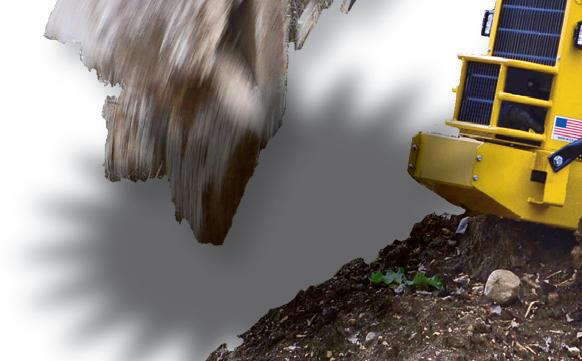

Does this mean that your contributing base needs to expand?




 Michael Deep South
Michael Deep South

Hi Michael,



Thanks for your letter. We appreciate hearing from our readers who live in various climate zones, since we distribute our magazine internationally, but not all the information applies in all areas. Luckily, we’re working on changing that. For the Deep South, are there any specific aspects of gardening that you’d like us to focus on, or local experts you’d like us to feature? We know from experience there’s a lot of rain (and flooding), acidic soils, a greater chance of perennials, more pests, and more potential for fungus. We’d love to hear from our Deep South readers on what problems — and advantages — you encounter in your own gardens.
— MOTHER






Apple Factors



I’m in eastern Idaho and currently growing eight varieties of apples, both sweet and tart flavors, because I hope to be able to make and sell apple cider. I’m going to try a ‘Winesap,’ even though it’s borderline for my Zone.


One thing I learned was to not fertilize young apple trees; it inhibits their fruit production for that year. I control worms by removing wormy apples from the tree while they’re small, which thins the apples, so the remaining apples are larger. The wormy ones are hauled to the landfill, not composted. Another crucial factor is that different apples have different storage lives. ‘Honeycrisp,’ ‘Gala,’ ‘Haralred,’

WWW.MOTHEREARTHNEWS.COM 85
Dear MOTHER PO BOX 1111, LYNDONVILLE, VT 05851 • P: 800-451-7593 • F: 802-626-8045 ©2012 Radiantec, Inc. • Free design assistance and tech support • Free detailed installation manual • Low cost and direct sales Can do This! You YOUR HANDS, YOUR TOOLS, OUR ASSISTANCE. Come to our award winning website and see if radiant is right for you. www.radiantec.com RETROFIT RADIANT INTO YOUR HOME. USE YOUR EXISTING WATER HEATER INSTEAD OF AN EXPENSIVE BOILER. If you can see the underside of the floor, you can install comfortable and efficient radiant heat. 1-262-599-6363 Mention Promo Code: ME423 Clear land & brush for trails, excavate a foundation for your dream home, dig trenches and ponds, demolish old sheds, the list goes on and on! - Out performs 4WD Wheeled Tractors!!! SAVE MONEY! Stop paying others to do jobs you could do yourself. Get Your FREE Info Kit! EASY TO USE! No shifting gears, instant power to forward and reverse. MADE IN THE USA! Quality craftmanship, by American workers! StruckCorp.com/me TOUGH Jobs...Made EASY! ® GetYour FREE InfoKit! MH85-16.qxp_4.5 x 4.5 1/30/23 12:17 PM Page 1 See #32 on page 89 See #30 on page 89
and ‘Winesap’ store well for several months. One should also avoid varieties that are susceptible to fire blight, and be aware that some varieties only produce every other year.

I slice and can apples for winter pies and apple dumplings. Here’s one of my favorite recipes.
Finnish Compote
• 1 quart sliced apples
• 1 to 2 cups of the juice
• 1 cup raisins
• 1⁄3 cup chopped walnuts
• Brown sugar and cinnamon, to taste
Bring to a boil and then simmer for 10 minutes. Serve warm.
Mary Martin Idaho
Thoughts on Carbon Footprints


We’d have to fool ourselves if we want to convince anyone that burning wood is less damaging to the atmosphere than burning anything else. For sure, if the Earth contained a half-billion people or less, there might be a carbon neutrality on what’s emitted and what’s absorbed sustainably. Currently, any burning adds to problem, and unfortunately, I’m as guilty as anyone, but I’m not pretending that I’m not polluting from driving my gasoline-powered car to burning the pile of brush in spring (plus the weed whacker, lawn mower, chainsaw, and tractor).
Gordon Hoffman Via email
Your letter echoes our thoughts as we reply to other queries about diminishing our carbon footprints. And there just isn’t a one-size-fits-all answer. Humans currently depend on a lot of gasolinepowered machines. Many building and Homeowners Association codes require them for maintenance. Living in a backcountry, off-grid house sounds sustainable until you have to cut down trees for heat. It’s all a great reminder for us to stay educated on our own carbon footprints and the pollution we cause with mere consumerism, and then decide what we can improve within our own

86 MOTHER EARTH NEWS April/May 2023 Dear Mother
See #15 on page 89
See #35 on page 89
See #25 on page 89
lives while simultaneously advocating for alternatives and regulations within our communities so we diminish the problem as much as possible.
Mother
Propagating Cuttings
I’ve been an avid seed saver for years. More recently, I’ve been expanding my use of cuttings in fall (prior to first frost) to propagate not only annual flowering plants but also vegetables. Tomatoes are especially easy to root. They don’t even need special medium or rooting hormone to do well.
An advantage to using cuttings versus saving seeds is that one can save hybrids without being concerned about seeds “breeding true.”
Maybe Mother earth News could do a few articles?

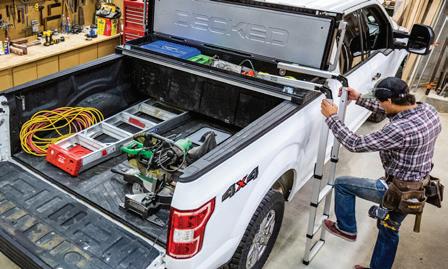




 David A. Middle Salmon Creek Farm
David A. Middle Salmon Creek Farm
Wonderful suggestion, David. You can find resources on our website. For an article on how to get started, search for “How to Grow Plants from Cuttings” on www.MotherEarthNews.com

Mother



Write to Us!
Started in 1970 to raise awareness of environmental concerns and to provide information and support for a simpler lifestyle, Mother earth News has made it this far because of continuous interest from you, the readers. Your dedication to living more sustainable lives has kept this magazine afloat through five decades and an increasingly digital world, and we’d love to hear from you. Send photos of your farm, your garden, and any projects you’ve undertaken over the past five decades to Letters@ MotherEarthNews.com. Or, mail a letter to Dear Mother, 1503 SW 42nd St., Topeka, KS 66609. Please send your full name, address, and phone number. We may edit for clarity and length.

Nature Studies
www.MotherearthNews.coM 87 Dear Mother
Turkey Chicken Mini Call or Order Online Made in USA AdorStore.com Automatic Doors for Chickens Guineas, Ducks, Peacocks & Turkeys 832-444-0192 info@adorstore.com www.adorstore.com Rugged Galvanized Steel 1 year warranty Free USA shipping* Free Battery Included Ideal for remote location LED status indicator Mount inside or outside Compatible with wifi Door Locks Shut Built in RedScare *Excluding Turkey Door) I adore my ADOR Learn the secrets of growing abundant plants and vegetables. Explore the fascinating natural world around us. Delve into a “hands-on” subject like beekeeping or mushrooms.
1-800-FOLK-SCH BRASSTOWN, NORTH CAROLINA folkschool.org/mearthnews Bamboo Fly Rod Making The Little Homestead Beekeeping Mushroom Immersion Week Edible Flowers From Flax to Linen Growing Great Tomatoes Southern Appalachian Springtime Explorations UPCOMING CLASSES INCLUDE: Products for property care & outdoor life CHP.com TAKE 10% OFF YOUR 1ST ORDER! Use CODE: Welcome10 SHIPPING FREE Limitations Apply See #11 on page 89 See #2 on page 89


AD# ADVERTISER PAGE(S) URL PHONE 1 Allivet ...................................................61 ......... www.allivet.com .................................................... 877-500-9944 2 ALLOGIC, Inc/Adorstore.com 87 www.adorstore.com 832-444-0192 3 Apothecary Inc 91 www.thepowerherbs.com 866-229-3663 4 Ardisam - Earthquake 23 www.getearthquake.com 800-345-6007 5 Ardisam - Yardbird .................................56 ......... www.yardbirdpluckers.com .................................... 800-345-6007 6 Botanical Interests 40 http://www.botanicalinterests.com/ 877-821-4340 7 Brinsea Products Inc. 59, 91, 92 https://www.brinsea.com/catalog.aspx 888-667-7009 8 Doyle Blackberry Inc. .............................31 ......... www.fruitsandberries.com...................................... 812-254-2654 9 Dr. Jimz 29 www.DrJimZ.com 888-394-4454 10 Earth & Turf Attachments 90 www.earthandturfattachments.com 877-800-6625 11 John C. Campbell Folk School 87 www.folkschool.org 800-365-5724 12 Kent Nutrition Group .............................17 ......... https://kentfeeds.com/product-lines/home-fresh/ ..... (866) 647-1212 13 KozGro Organics 60 www.kozgroorganics.com (208) 718-8771 14 Kubota Tractor Corporation IFC www.kubotausa.com 888-465-8268 15 Kunz Engineering 86 www.kunzeng.com (815) 539-6954 16 Long Creek Herbs ..................................51 ......... www.longcreekherbs.com ...................................... (417) 779-5450 17 MacKissic 11, 92 www.mackissic.com 800-348-1117 18 Mann Lake 84 http://www.strombergschickens.com/ 800-720-1134 19 Mantis ..................................................83 ......... http://www.mantis.com/ ......................................... 888-240-4765 20 Mt. Healthy Hatcheries ..........................47 ......... www.mthealthy.com .............................................. 800-451-5603 21 MUSSER FORESTS 40 www.musserforests.com 800-643-8319 22 Nature’s Rite 77 https://www.mynaturesrite.com/ (800) 991-7088 23 Neptune Harvest/Ocean Crest Seafood ....90 ......... www.neptunesharvest.com..................................... 800-259-4769 24 NEW ENGLAND SEED CO. 76 www.neseed.com (800) 825-5477 25 Nomadic State of Mind 86 www.nomadicstateofmind.com 781-816-3030 26 Nopec 82 www.chickendoors.com 512-995-0058 27 Pacific Yurts ......................................... IBC ......... www.yurts.com ..................................................... 800-944-0240 28 Premier 1 Supplies 90 premier1supplies.com/pages/catalog 1-800-282-6631 29 Progressive 7 www.progressive.com 800-PROGRESSIVE 30 Radiantec 85 www.radiantec.com 802-626-5564 31 Stiebel Eltron ........................................92 ......... www.stiebel-eltron-usa.com ................................... 800-582-8423 32 Struck – Power Solutions for Today 85 https://struckcorp.com/ (262) 599-6363 33 Summit Responsible Solutions 19, 65 www.SummitResponsibleSolutions.com 800-227-8664 34 Sun-Mar................................................83 ......... www.sun-mar.com ................................................. 888-341-0782 35 TeraVolt Energy ......................................86 ......... www.tvnrg.com ..................................................... (210) 374-TERA (8372) 36 Waterwise 91 www.waterwise.com/grit 800-874-9028 37 Wisconsin Aluminum 90 www.allamerican1930.com 920-682-8627 38 Wood-Mizer ...........................................51 ......... www.woodmizer.com ............................................. 317-271-1542 39 Worksaver 70 www.worksaver.com (217) 324-5973 IFC = Inside Front Cover IBC = Inside Back Cover OBC = Outside Back Cover If you have recently requested information using our reader service reply card and have not received a response, please reach out to the advertiser directly at the above link. Free Information from Our Advertisers 68C 100Y 24K Pantone
Please visit www.motherearthnews.com/advertiser-directory to connect with our advertisers for further product information www.MotherearthNews.coM 89
363C











GENERAL STORE 90 MOTHER EARTH NEWS April/May 2023 For more information on these ads see page 89. Premier1Supplies.com 800-282-6631 Poultry Fencing Portable Electric FREE shipping on qualified orders! NEPTUNE’S HARVEST ORGANIC FERTILIZERS 1-800-259-4769 NEPTUNESHARVEST.COM Family-Owned • Gloucester, MA FOR EVERYTHING YOU GROW! PRODUCTS FROM THE OCEAN, TO SET YOUR PLANTS IN MOTION 10 28 37 23
1/6

VERT

For more information on these ads see page 89.
BIOLOGIST’S FRAGRANCE ADDITIVES INCREASE AFFECTION FROM OTHERS
These cosmetics increase your attractiveness. Created by the co-discoverer of human pheromones. Dr. Winnifred Cutler has authored 8 books on wellness and 50 scientific papers.

ATHENA PHEROMONE


for women for men tm
unscented fragrance additives

♥ Maggie (NY) “People notice me more. The UPS man was the real clincher. For years he would come in, and leave. But once I put on the 10:13 he stopped, turned around and stared. ‘Has anyone told you you are so beautiful?’”
♥ Jim (CT) 10X really works! Other men are trying to figure out what I have that they don’t. Women say to me, ‘There’s something about you that attracts me.’”
PROVEN EFFECTIVE IN SCIENTIFIC STUDIES
athenainstitute.com
Vial of 1/6 oz. added to 2-4 oz. of your fragrance lasts 4 to 6 mos., or use straight Contains human synthesized pheromones. Call (610) 827-2200 – Order online or send to: Athena Institute, Dept MEN, 1211 Braefield Rd. Chester Springs, PA 19425
Works for most, but not all. Cosmetic products; not aphrodisiacs. No animal testing. NOT SOLD IN STORES. F ree US Shipping

Please send me__vials of 10:13 for women@$98.50 and/or___ vials of 10X for men @$99.50 for a *total _____ by: ❑ money order, ❑ check ❑ Visa,M/C,Disc.______-_______-_______-_______

Exp._____ CVV:____ Sign:__________________ to: Name______________________________ Address_______________________________ City/State_________________zip__________ Tel:______________ email___________________


(*PA add 6% tax, We ship abroad—See website) MEN


GENERAL STORE
7 3 36









































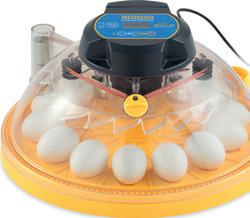















































GENERAL STORE 92 MOTHER EARTH NEWS April/May 2023 1/9 For more information on these ads see page 89. Endless Hot Water 800.582.8423 | www.StiebelEltron.us Tempra ® Plus electric tankless water heaters with Advanced Flow Control ™ Germany always delivered at the hot water temperature desired. 99% efficiency | no venting | save space, water & money LEADS TO Featuring premier properties in lifestyle & country real estate. 800.999.1020 | UnitedCountry.com FIRSTHAND EXPERIENCE SERVICEexceptional www.MacKissic.com 1-(800)-348-1117 Wood Chippers Chipper Shredders Turn GARBAGE Since 1947 Into GOLD Proudly made in the USA Providing heirloom fruit trees for your home and farm. www.treesofantiquity.com Trees of Antiquity f i i Tre es o Ant qu t y Free Catalog For more information www.brinsea.com or call 1-888-667-7009 Brinsea the world leading incubator manufacturer has a full line of incubators, brooders, egg candlers, starter kits and much more! Color Incubation Specialists Hatching your own chicks is fun, easy reliableandwith Brinsea Ifahencould choose… www.CandlesAndSupplies.com 800-819-6118 Your one-stop shop for all Candle, Soap & Personal Care Product Supplies... Visit our showroom or shop online! 7 31 17
MOTHEREARTHNEWS CLASSIFIEDS

Classified ad information, contact Connie: 866-848-5416; email classifieds@MotherEarthNews.com; fax 785-274-4316
ALTERNATIVE BUILDING
Fully illustrated DIY manual, detailed step-by-step instructions for building an off-grid, completely solar cabin. Can be owner-built for a few $K. $20. 828-371-6086 or email ldfranklinxx@yahoo.com
ALTERNATIVE ENERGY
PUMP WATER UPHILL. No gas or electricity with Ram or Solar Pump. Free Energy-Sun or Gravity. 800-227-8511.

www.theramcompany.com
EDUCATION
GARDENING/RELATED PRODUCTS
ONE SCYTHE REVOLUTION
BUILD UNDERGROUND houses/shelters/greenhouses dirtcheap! Live protected. Slash energy costs. Featured on HDTV. “Radical and innovated“ Mother Earth News 800-328-8790 www.undergroundhousing.com

ALTERNATIVE ENERGY
BOOKS / MAGAZINES
Do you love to write or wish you could? Scribbly is a gentle and whimsical writing program for women. Each issue is beautifully illustrated with easy-to-follow writing prompts. We mail Scribbly to your home – you’ll love it! 1-month/3-month/6-month subscriptions. www.kimdukewrites.com/Scribbly


FOOD PRESERVATION
Selling Europe’s best scythe blades, adjustable wooden snaths, accessories, and permaculture hand tools. onescytherevolution.com 507-454-4121

OUTDOOR WOOD FURNACE
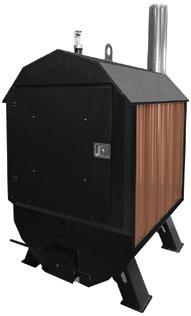
The industry leader in proven clean burn technology
• All Fire no smoke.
• Combustion efficiency 99.5%
• Burns up to 60% less wood
• 7 industry firsts
• Carbon neutral

• Oldest renewable energy.
• Compatible with off-grid use
Build your own cob oven! Step-by-step instructions with clear pictures. Written by an experienced natural building teacher. $22.00/88 pages

www.cobitat.org
The MIDNIGHT CRY has sounded. The angel of REVELATION 14:6 has come. Free literature. 800752-1507; www.ccem1929.com
BUSINESS OPPORTUNITY
Make jam & jelly with low amounts of any sweetener. No Sugar, Preservatives, or GMOs At natural food stores or www.pomonapectin.com 559-760-0910

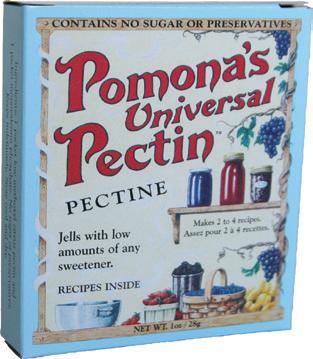
AMAZING GARDEN TOOLS!
Broadforks for deep soil prep. Wheel Hoes for fast weeding. We make THE BEST. See videos online: valleyoaktool.com Call 530-342-6188

CONTACT
Ultimate Outdoor Furnace LLC
Les Radcliffe 507-254-0622
Polar Furnace Factory Rep

Dealer/Agent opportunities
www.ultimateoutdoorfurnace.com

Sunstar High Efficient Appliances
12/24VDC Refrigerators and freezers made specifically for offgrid applications. Free Shipping to the lower 48 states.
www.thecabindepot.com info@thecabindepot.com Phone 844-603-4743
GREEN HOME BUSINESS Make a living while making a difference working from home. P/T or F/T. Flexible hours. No large investment. www.EcoTeamUnited.com
CRAFTS
Seatweaving Supplies
Chair cane, reed splint, Shaker Tape, fiber & natural rush. Complete line of basketmaking suplies. Waxed linen cord. Royalwood Ltd., 517-MEL Woodville Rd., Mansfield, Ohio 44907. 800-526-1630. www.RoyalwoodLtd.com
SOON Church/Government uniting, suppressing RELIGIOUS LIBERTY enforcing NATIONAL SUNDAY LAW. Be informed!
TBSM, BOX 374, Ellijay, GA 30540 tbsmads@yahoo.com 1-888-211-1715.
LUNATEC Hydration Spray

Bottles combine a garden hose, shower, kitchen faucet and water bottle in one. Cool off, clean off and drink. They’re perfect for gardening, camping, sports and more. www.lunatecgear.com
SCYTHESUPPLY.COM European scythes. Mow where your tractor can’t go. Custom-made handles(snaths). 496 Shore Road Perry, Maine 04667 207-853-4750 Free Catalog. www.scythesupply. com, FREE hat with scythe outfit: use code MEN at checkout.
WWW.MOTHEREARTHNEWS.COM 93 CLASSIFIEDS
Inspired!
+ healthy low-sugar recipes
Bookstores & Online FREE
Get
80
At
Best Updraft
G-Class Best Downdraft
PORTAGE and MAIN
POLAR
GARDENING/RELATED PRODUCTS
Dripping Springs Ollas: an ancient system that saves up to 70% in water use. OLLAS are buried neck deep in soil and filled with water. surrounding plants pull the water out when needed. Check out our website, youtube and instagram for more information.
www.DrippingSpringsOllas.com
GREENHOUSES
BUILD WITH PVC

-Specialized Fittings-Free Plans -
-Snap Clamps & PVC KitsCirco Innovations, Inc. 877-762-7782

www.circoinnovations.com

HEALTH, HEALTH CARE PRODUCTS
IRRIGATION & WATER WELLS
FREE SHIPPING on Drip Irrigation Kits for Small or Large Gardens and Hobby Farmers! Growing Accessories, Mulch, Twine and more! Fast Shipping. Free Catalog. www.berryhilldrip.com
MACHINERY/TOOLS/ SUPPLIES
CROSSCUT SAWS: Saw tools, knives, firewood-cutting, people-powered tools. Catalog $1.00. ($3.00 Canada/ Overseas). Crosscut Saw Company, PO Box 7875, Seneca Falls, NY 13148; 315-568-5755; CrossCutSaw.com

PLANTS, SEEDS, BULBS, ROOTS
Wowwwww!! Lowest prices for heirloom vegetable seeds! Stock up while they are still $1-2 a packet. Why pay more? - Buy 10 packets, and get the next one free!


Go online to request a catalog www.ecoseeds.com

Or call 650-325-7333Redwood City Seed Company, Box 361, Redwood City, CA 94064 – Since 1972





Every Gardener knows that in order to have a beautiful garden, you must Always Be Weeding. Sometimes our life garden needs weeding, too!
www.alwaysbeweeding.com

GREENHOUSES
Greenhouse Kits, Super Strong Greenhouse Plastic, Containers, Pots and Containers Garden
Drip Irrigation, Jiffy Peat Pots, Sprinklers, Greenhouse supplies 866-928-3390.


www.growerssolution.com
Surgical augmentation is needlessly desecrating in light of dramatic, perennial enlargement organically achieved w/unprecedented, holistic proprietary formula. Brochure: 1-800-967-2177

www.BeautyVantage.com


HOMESTEADING
Your Product Source for Homesteading, and More! All Farm, Ranch and Dairy Supply! Gift Certificates! (928)583-0254. www.HomesteaderSupply.com
HOUSEHOLD PRODUCTS

PERSONALS
GREENSINGLES.COM Ready for a meaningful, conscious relationship? Meet someone who loves Mother Earth as much as you! It’s time, you’re next!
Christian Singles Catalog. Personal ads. Photos. Pen pals. Sample $1. Singles, Box 310-MN, Allardt, TN 38504. 931-879-4625. www.nicesingles.com


PLANTS, SEEDS, BULBS, ROOTS
Red Spider Lily Bulbs Lycoris Radiata Radiata A southern heirloom bulb, hardy zone 6 south. For prices contact 601-941-9017 retirdpots@aol.com
Southern Exposure Seed Exchange
Open-pollinated, Heirloom & Organic Seeds & Garlic selected for flavor and local adaptability. Free Catalog 540-894-9480
www.southernexposure.com
Packets and Bulk Vegetables Herbs Flowers Fast Shipping Order online TOLL FREE 844-254-7333. www.burrellseeds.com

We make hanging Laundry a Breeze!

High quality pulley clotheslines crafted in the USA, delivered to your door. 330-403-3010
www.skylineclotheslines.com
LUNATEC Odor-Free Dishcloths and Self-Cleaning Washcloths stay odor-free, dry in minutes, rinse clean and have less bacteria than sponges or cotton cloths. Try them today. www.lunatecgear.com
Turtle Tree Biodynamic Seed Initiative Pioneer of seed transparency offering Organic and Heirloom
Open-pollinated Vegetable, Herb and Flower seed. Located in Camphill Village since 1998. Free Catalog: info@turtletreeseed.org 1(800) 930-7009
www.turtletreeseed.org
www.GrandpasOrchard.com The best fruit trees and growing tips for the backyard fruit grower. Huge variety selection. Grandpa’s Orchard, LLC, PO Box 773 DeptMN Coloma, MI 49038. Phone 877-800-0077.
American Elderberries. Learn To Grow Your Own Medicine with Terry Durham. Commercially Or In Your Backyard. Online Classes Available Now. www.RiverHillsHarvest.com
POULTRY
FREE COLOR CATALOG 203 varieties shipped to your local post office, chickens, rare breeds, bantams, ducks, geese, turkeys, guineas, pheasants, quail, supplies and videos. Since “1936” Cackle Hatchery PO Box 529, Lebanon, MO 65536, 417-5324581. cacklehatchery.com
94 MOTHER EARTH NEWS April/May 2023 Classified ad information, contact Connie: 866-848-5416; email classifieds@MotherEarthNews.com; fax 785-274-4316 CLASSIFIEDS
vs
®
POULTRY
Hatching your own chicks is fun, easy and affordable with Brinsea Forget Styrofoam incubators andwatch your eggs hatch every time. Quality incubators since 1976 - durable, easy to clean, user friendly digital controls and 3-year warranty. Free color catalog. www.Brinsea.com 1-888-667-7009.

POULTRY
Keeping your flock safe has never been easier or more reliable. With only one moving part, no mechanical switches and no calibration ChickSafe are the ultimate rugged, fuss-free automatic coop door openers with 3 year warranty. www.Brinsea.com

1-888-667-7009. CHECK OUT OUR AD IN THE GENERAL STORE!!
FREE CATALOG. Chicks, Turkeys, Ducklings, Goslings, Guineas, Gamebirds, Bantams, Equipment. Hoffman Hatchery, Box 129A, Gratz, PA 17030; 717-365-3694; www.hoffmanhatchery.com
POULTRY
The Egg Carton Store Best Prices, selection, high quality. 40 years of egg packaging and marketing expertise! Egg Cartons, Filler Flats, Stamps, Egg Cases, Nesting Boxes, Supplies, Poultry Care, Custom Cartons and Labels. Call for GREAT wholesale/pallet quantity pricing! 866-333-1132. FREE SHIPPING on all cartons and filler flats.
WWW.EGGCARTONSTORE.COM

POULTRY FOR SALE
2 Jamesway 252 incubators
2 side panels 48 incubator trays Egg Turner, Time Clock $3000.00 OBO 815-943-7396
REAL ESTATE
DAY-OLD BABY CHICKS | FREE SHIPPING Shop McMurray Hatchery for the highest quality and guaranteed rare and Heritage breed poultry, low minimums, and all the supplies you need to raise your flock. Offering day-old standard and bantam baby chicks, ducks, geese, turkeys, guineas, pheasants, quail, and more! Request a FREE CATALOG at McMurrayHatchery.com or by calling 800.456.3280.

Nature’s Best provides premium ingredients and customer service manufacturing organic, nonGMO feed across North America. Nature’s Best knows what is important to their customers and continually strives to provide trusted products and healthy, innovative options from poultry to livestock feeds.

Stromberg’s Chicks & Game Birds Unlimited is your one-stop shop for all things poultry! We carry a full line of incubators, brooders, feeders & waterers, feeds, coops & pen supplies, egg supplies, and processing equipment. Check out our great selection of chicks & birds! Request a free catalog today! 800-720-1134, www.strombergschickens.com
Designed and developed for small flock owners. Moves easily with one person. Available in 3 sizes Order CD plans through mail, printed plans, or electronic download version. www.chickenmobilestagecoach.com

Go to www.chickendoors.com for the best automated door on the market or call 512-995-0058.
Myers Poultry Farm - FREE CATALOG. Chicks (9 meat varieties), Ducklings, Goslings, Turkeys, Guineas, more. 966 Ragers Hill Road, South Fork, PA 15956; 814539-7026 www.myerspoultry.com
Local Hens Find Good Stuff Grown nearby. Join more than 3,000 other farms and connect directly with consumers by listing your farm. Your FREE farm profile can showcase products with farm photos, your farm story, and google map locations where you sell. Made for ALL farms and food types.
WWW.LOCALHENS.COM

Ontario, Canada. Newly built off grid homestead minutes off Highway 400 - 2000’ sq ft’on 46 acres of hardwood bush, 7.25 Kw of Solar, 12.3 Kw diesel generator, drilled solid granite well, 3 bedrooms, 2 bath, open concept living/ dining room, wood burning airtight fireplace, high efficiency propane furnace, gourmet 6 burner propane range, dishwasher, washer and dryer, fruit trees: stream running through the apple orchard, pear, mulberry, elderberry, hazelnut, haskap trees, laying chickens, moose, deer, fishing, atv and skidoo trails, Georgian Bay and local airport nearby, 10 minutes to beautiful Parry Sound and an amazing hospital. Annual costs are propane and taxes under $3,000/year. Max Connolly - 705-526-1626
SAWMILLS
BANDSAW SAWMILL KITS
Available Complete or Buy Part/ Build Part. Free brochure. Call 1-541367-6900 Web: www.linnlumber.com
DON’T WASTE THOSE LOGS! Cut lumber, slabs beams. The Alaskan® Chainsaw Mill. Made in the USA. Portable, affordable, accurate. 800-233-6499; www.granberg.com
SEPTIC SOLUTION
TRY THIS BEFORE PUMPING your septic system or replacing your drain field!
Aluminum chicken tractors, great for mobile pasture raised chickens. Call 785-289-3807. www.naturalgramma.com

Come see us at the Mother Earth News Fair in Lawrence, Kansas. April 29 -30, 2023
Ideal Poultry Breeding Farms, Inc. Supplying quality backyard poultry since 1937. www.idealpoultry.com 1-800-243-3257.

NRR Hatchery has been a family owned and operated farm in Northeast Oklahoma since 2013.

1 Day Old Chicks, Hatching Eggs, Fresh Eggs, Mealworms and Farm Goods. Local Pickup and Shipping Available. For more information visit our webiste at www.nrrhatchery.com
Accelerator by Dr. Pooper Drain Field Cleaner is a revolutionary non-toxic commercial-strength septic treatment that clears organic solids from septic tanks and drain fields. Money-back-guarantee! Order at DoctorPooper.com

WWW.MOTHEREARTHNEWS.COM 95 CLASSIFIEDS Classified ad information, contact Connie: 866-848-5416; email classifieds@MotherEarthNews.com; fax 785-274-4316






Photos from the Field Share your unique perspective with our community by submitting photos of inviting gardens, nutritious foods, wild animals, and more to the MOTHER EARTH NEWS Photo Group on Flickr (www.Flickr.com/Groups/MotherEarthNewsPhotos/Pool ). We’ll feature our favorites here and online! SHOW US! C LOCKWISE FROM TOP LEFT : R YAN I TO ; A SHLEY D UFFUS /A G REAT C APTURE ; K AREN M OLENAAR T ERRELL
From left: A ladybug tunnels into purple petals in Alberta, Canada. A jellyfish swims at the Aquarium of the Bay in San Francisco.
Vibrant tulips bloom in the RoozenGaarde flower fields in Mount Vernon, Washington.

F rom seaside getaways to mountain retreats, the Pacific Yurt goes where you want to be. • Comfortable • Affordable • Easy to Set Up • Eco Friendly Call today 800-944 -0240 yur ts.com Design & price your yurt in 3D at The Original Modern Yurt TM See #27 on page 89








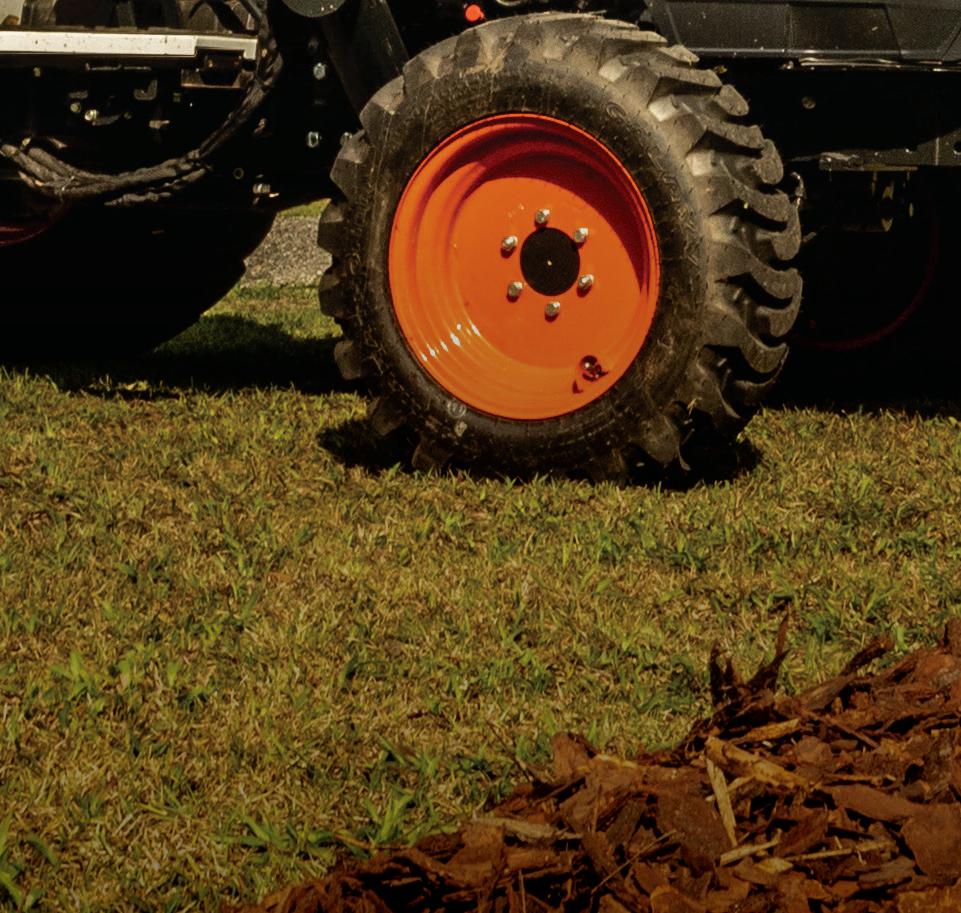










Do the most challenging chores with a Bobcat Compact Tractor. If you have the will to tackle difficult jobs on your property, we have the way. Bobcat Company is a member of the Doosan Group. Doosan is a global leader in construction, grounds maintenance and material handling equipment, power and water solutions, and engineering that has proudly served customers and communities for more than a century. Bobcat ®, the Bobcat logo and the colors of the Bobcat machine are registered trademarks of Bobcat Company in the United States and various other countries. ©2023 Bobcat Company. All rights reserved. | 1544 BOBCAT.COM LOOK FORWARD TO TOUGHER DAYS.


































































































































































































































































 Professional installers will evaluate your home and land for solar.
The author’s 2014 solar electric system installation included 26 ground-mounted panels.
Professional installers will evaluate your home and land for solar.
The author’s 2014 solar electric system installation included 26 ground-mounted panels.























 By Ashleigh Krispense
By Ashleigh Krispense








 By Kami McBride
By Kami McBride












































































 By Linda Bowen
By Linda Bowen



























































 – Stan Kujala, British Columbia
– Stan Kujala, British Columbia






































































































































































































 Melissa Ball Enfield, New Hampshire
Melissa Ball Enfield, New Hampshire









 Trish Robbins Bonners Ferry, Idaho
Trish Robbins Bonners Ferry, Idaho





















 Sammy Yu
Port Moody, British Columbia
Sammy Yu
Port Moody, British Columbia










































































































































































 Marissa Ames
Marissa Ames























































































































































































































 Carolyn Watts Adairville, Kentucky
Carolyn Watts Adairville, Kentucky

 Ruth Johnston Via email
Ruth Johnston Via email















 Michael Deep South
Michael Deep South

















































































































































































